David E. Grogan's Blog, page 5
January 21, 2022
Specialist Andrea Marshall, U.S. Army – Something Bigger Than Self
It takes courage to enlist in the military. Once you raise your right hand and take the oath to serve and defend the Constitution, you must go wherever the military says you are needed most. When the nation is at war, that need could very well be in a war zone where your life is at risk. Such is the case with Specialist Andrea Marshall, who enlisted in the Army in 2008. Four years later, she found herself assigned as a combat medic at a Forward Operating Base in Afghanistan. This is Andrea’s story.
Andrea was born and raised in New Berlin, Illinois, a very small town located about fifteen miles west of Springfield, the capital of Illinois. Her dad was a career Navy Reservist. Andrea remembers seeing him bring home books to study for advancement exams and carefully keeping track of his drill points to make sure he earned enough points to retire. His experience weighed heavily on her as she looked at life beyond New Berlin High School. She saw the military not only as an opportunity to get away from her small town and see the world, but also as a means of adding structure and direction to her “wishy-washy” outlook and participating in something that was bigger than self.
The Air Force almost snagged Andrea after she graduated from high school in 2007. In fact, an Air Force recruiter worked up an enlistment package on her before she graduated, but Andrea didn’t feel like he was being responsive to her questions and concerns. His indifference convinced Andrea the Air Force was not for her. Instead, she enrolled at Lincoln Land Community College hoping to teach music to kids. Music had been her love in high school, where she played the clarinet, the saxophone, and a handful of other instruments. One of the benefits of the Lincoln Land program was that it allowed her to teach music to kids at a local elementary school. That experience proved crucial, because it taught her that her love of teaching music to kids did not include dealing with their parents.
During the spring semester of 2008, Andrea talked to an Army recruiter at the college. Her goal was to be a musician in the Army’s Big Band. The recruiter said he could arrange for an audition, but she had to have a “Plan B” in case she wasn’t selected for the band. Andrea thought that was reasonable, so she and the recruiter worked up an alternative enlistment package for the medical field. She also took and passed the Army’s Physical Fitness Test (PT test), which she was told would benefit her once she graduated from Basic Training.
The Army recruiter delivered on his promise for the audition, which took place before the end of Andrea’s second semester at Lincoln Land Community College. She was very nervous for the audition and, looking back, she feels as though she should have auditioned for saxophone rather than clarinet. Unfortunately, she did not make the band, but she was still excited about her second choice of becoming an Army combat medic.
Andrea completed her second semester at Lincoln Land Community College and then reported to the St. Louis Military Entrance Processing Station (MEPS) for her formal induction into the Army in June 2008. She arrived at the MEPS around 4:00 a.m. and was the first person through the screening line. As instructed, she took an elevator to the building’s top floor. When the elevator arrived at the top floor, the doors wouldn’t open and Andrea found herself trapped inside alone. She pushed the help buttons, but it was just after four o’clock in the morning, so no one answered. Eventually she connected with someone through the elevator’s emergency phone who promised to send someone to get her out.
While Andrea was waiting for help to arrive, she called her father on her cell phone. He told her not to panic and asked if there was a vent in the elevator. When she told him there was, he assured her she would be okay because there should be enough oxygen in the elevator for her to breathe. This created a new worry because now Andrea wondered if her dad might be wrong. Finally, the firefighters arrived. They had to pry open the doors because the elevator had gone two feet past the stopping point for the top floor. Andrea climbed out, put the incident behind her, and went on with her day. Still, this was not the beginning she envisioned for her enlistment in the Army.
After completing her final physical and taking the oath of enlistment, Andrea and the other new Army recruits at the MEPS took a bus to the airport and a flight to Atlanta. Once in Atlanta, they boarded another bus to Fort Jackson, South Carolina, arriving at “zero dark thirty”. Drill sergeants screamed at them to get off their bus and immediately let the new arrivals know who was in charge.
Although the male and female recruits lived in separate barracks, they did their Basic Training together. Platoon and squad leaders were chosen by the drill sergeant from within the ranks of the recruits, rotating on a weekly basis. During one week, a recruit platoon leader returned to the barracks after the firing range upset because she was told she could no longer be a platoon leader because her rifle scores were too low. In consoling her comrade, Andrea indicated that didn’t seem right and that leadership was more than just being able to fire a weapon. Much to Andrea’s chagrin, the drill sergeant overheard what she said. The drill sergeant asked her, “So you don’t think I make good decisions?” He then promoted Andrea to platoon leader so she could see what leadership really entailed.
Unlike her predecessor, Andrea could shoot. In fact, when she went to the range to qualify with the M4 rifle, she is pretty sure the sergeants took bets on how well she would do. When Andrea’s target was scored, she only missed on two of the forty rounds she fired. Her drill sergeant came up to her afterwards and asked her how she could have missed twice, once on a 50-meter target and once on a 300-meter target. Andrea is sure he bet that she would score hits with all forty rounds and had to pay up even though she’d excelled on the range and earned her Sharpshooter badge.
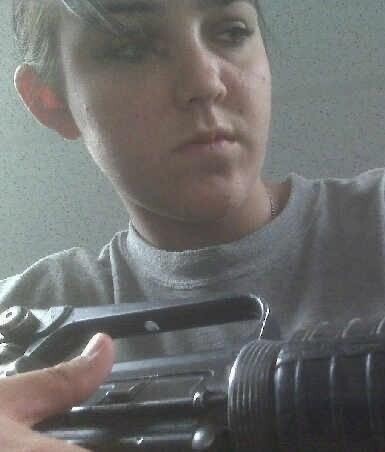 Andrea Marshall at AIT
Andrea Marshall at AITAndrea graduated from Basic Training in August 2008. Because she had completed one year of college and passed the PT test prior to enlisting, she was immediately promoted to Private First Class. This meant more pay and seniority as she reported to her follow-on Advanced Individual Training (AIT) at Fort Sam Houston, located in San Antonio, Texas. It was there that Andrea would learn to become a combat medic.
Andrea loved everything about AIT. The training was broken into two sessions. The first was the “civilian” session, where Andrea earned her Emergency Medical Technician (EMT) certification. The training was intense because the normal semester-long certification had to be completed within two months. During this session, Andrea learned such skills as controlling bleeding, stabilizing broken bones, and dealing with patients in shock.
The second two-month session was called the “whiskey school” because the Military Occupational Specialty (MOS) code for combat medics is 68W (where the “W” is pronounced “whiskey”). During this session, Andrea learned the additional skills she would need to keep wounded soldiers alive on the battlefield, like dealing with gunshot and shrapnel wounds, applying tourniquets and stabilizing soldiers suffering amputation injuries, and administering medications. As a final exercise, Andrea spent seven days in the field being tested on what she had learned on soldiers with simulated combat injuries.
Andrea graduated from AIT in December 2008, earning her combat medic MOS. After taking leave over the holidays, she reported to the 2nd Battalion, 159th Aviation Regiment (2-159th), located at Storck Barracks in Illesheim, Germany. The 2-159th Battalion, together with the 3rd Battalion, 159th Aviation Regiment (3-159th), operated Apache attack helicopters and were the two principal units operating from a small airfield located on the installation. The remainder of the 12th Combat Aviation Brigade, of which the 2-159th and 3-159th were a part, operated out of the U.S. Army Garrison at Ansbach, located about fifteen miles away. Thus the U.S. facilities available at Storck Barracks were limited to a commissary, a gas station, a small convenience store, an elementary school, and family housing.
On the bus taking her from the airport to Storck Barracks for the first time, Andrea couldn’t believe her new assignment. She’d enlisted in the Army to get away from small-town life in New Berlin, Illinois, and now she was going to live and work in a small town located in the middle of nowhere in Germany. Once she completed a week-long course about living in Germany and learned some basic German phrases, she felt less stressed about her new assignment.
Andrea worked at the Storck Barracks clinic, together with one or two other combat medics and a flight surgeon (sometimes two). Her duties included diagnosing and treating patients, issuing medications, and dealing with the normal administrative tasks associated with operating a clinic. For field exercises, Andrea would pack up the unit’s medical equipment, load it on a Humvee, drive the Humvee about ninety-five miles on the autobahn to the exercise site at the Grafenwoehr Training Area, and set up and run an aid station in the field.
During one such exercise, a soldier reported to the aid station that he was having terrible pain in his arm, having injured it while playing frisbee. Andrea examined his arm and concluded it was broken, which meant she would have to ride with him to the Grafenwoehr clinic, located about fifteen minutes away, where his arm could be x-rayed. When Andrea relayed her opinion to the flight surgeon to get his permission to go, he said he didn’t think it was broken and that Andrea was just saying that because she wanted to stop at Burger King, which was near the clinic. Andrea pushed back and the flight surgeon gave in. The trio then rode to the clinic where an x-ray revealed that the soldier’s arm was indeed broken. Feeling vindicated, Andrea insisted they stop at Burger King on the way back to the aid station and that the flight surgeon pay for it, which he did.
In 2011, Andrea had a baby girl and got married to another soldier assigned to the unit. She had only a little time with her daughter, though, before another big event loomed on the horizon – the 2-159th Battalion was getting ready to deploy to Afghanistan in May 2012. Because Andrea and her husband were both deploying with the unit, they flew back to the United States to meet each other’s parents and leave Andrea’s daughter in their shared custody while Andrea and her husband deployed. Having to leave her daughter was very hard, but at least Andrea knew she was in good hands.
Andrea and the 2-159th Battalion did not deploy directly to Afghanistan – they made an initial stop in Kazakhstan for some final theater-specific training. This included rollover training, where Andrea learned how to escape from a Humvee after it rolled over and pull the other occupants to safety. After about a week in Kazakhstan, the unit continued to Forward Operating Base (FOB) Sharana in eastern Afghanistan, near the border with Pakistan.
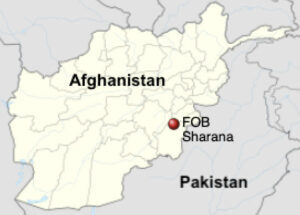 Map of Afghanistan showing location of FOB Sharana – Source: NordNordWest
Map of Afghanistan showing location of FOB Sharana – Source: NordNordWestAndrea arrived at FOB Sharana in May 2012. Aside from Afghanistan being a dangerous war zone, Andrea thought the country itself was beautiful. She also had the opportunity to meet some of the local nationals who had set up tents where soldiers could purchase knives, DVDs, and rugs. She found the people she met very friendly and easy to talk to.
Life at FOB Sharana soon settled into a routine with the highlight of every day revolving around meals. Soldiers would do their work wherever they were assigned, but for meals, they would go to the chow hall as a group with their friends. Andrea found it strangely similar to the way the various cliques ate together in her high school cafeteria.
Another important event was when supplies were flown in. If the supplies included Pepsi, some of the supply guys unloading the helicopters would bring a case to the clinic because they knew the Andrea liked it. In return, Andrea would put on a Scrubs, House, or Chief DVD and let the supply guys watch on the TV in the waiting room.
During Andrea’s time at FOB Sharana, she typically dealt with lots of routine injuries, like ankle sprains occurring when soldiers twisted their ankles running on the FOB’s rock-strewn terrain. On one occasion, a soldier tried to use his knife to clean something stuck to a helicopter and ended up stabbing himself in the leg. On another occasion, a soldier passed out while standing in formation and fell face first onto the rock and gravel-covered ground. In both cases, Andrea cleaned the wounds and stitched them up and the soldiers returned to duty.
The most serious condition Andrea had to deal with turned out to be her own. In August 2012, Andrea began to experience severe pain in her lower back. Eventually, the pain got so bad that she collapsed while trying to get her gear. The soldiers from the communications shop (S-6) heard her fall and called the flight surgeon. The flight surgeon initially suspected kidney stones, but later determined the cause to be blood clots resulting from a known risk of smoking while taking birth control pills. Although Andrea was aware of the risk, she never thought it would happen to her. Now she cautions women about the risk saying it’s more than just theoretical—it really can happen.
The condition was so severe that Andrea had to be medevac’d to Landstuhl Regional Medical Center at Ramstein Air Base in Germany. She was initially placed in the Intensive Care Unit (ICU) until the blood clots resolved. During this time, the Wounded Warrior Project stepped in to purchase clothes for her at the PX (post exchange) and made sure she was taken care of. Andrea then transitioned to temporary quarters at Ramstein so she could be monitored as she moved off blood thinner shots and started blood thinner pills.
After approximately three weeks, Andrea was back on her feet, but she was not permitted to return to her unit in Afghanistan because of her blood thinner medication. Accordingly, she returned to Storck Barracks, where she rejoined her husband who was recuperating from surgery after severing a tendon in his thumb. When Andrea became pregnant with their second child, she told her husband she couldn’t do another hitch in the Army. She’d already missed her daughter’s first birthday, her first steps, and her first words, and now the cycle was going to start again.
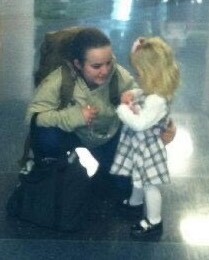 Andrea’s daughter welcoming Andrea home at the airport
Andrea’s daughter welcoming Andrea home at the airportWith her new direction clear, Andrea was honorably discharged from the Army in February 2013. Because her husband had to finish his tour in Germany and Andrea was not considered a command sponsored dependent, Andrea moved with her daughter to Alabama to live with her in-laws. The family later reunited at Fort Campbell, Kentucky, for Andrea’s husband’s follow-on tour, but the pressures on the family proved too great and Andrea’s marriage dissolved. Andrea then moved with her daughter and son back to her hometown in New Berlin, Illinois, to start her life anew.
As Andrea looks back at her service in the Army, there is one painful aspect that needs to be told. Andrea was sexually assaulted by a someone she trusted. Because he was in her chain of command, she felt like she had nowhere to turn or anyone she could talk to about it. She hopes that by talking about it now, it will empower women to reach out to each other for strength and support. She also calls on the military to continue to root out sexual misconduct by changing the culture and holding those responsible accountable for their actions.
After arriving back in Illinois, Andrea returned to college to pursue a nursing degree using her GI-Bill benefits. However, when she learned the program would not give her credit for her previous science courses and some family emergencies required her time, she decided she needed a stable career now to provide for the two most important people in her life: her daughter, Nevaeh, and her son, Aidan. That’s when she found a position working as a National Cemetery Representative for the Camp Butler National Cemetery in Springfield, Illinois. In her position, Andrea helps veterans and their families at a time when they need it most, meeting with the family members of the deceased, advising them of veterans’ benefits, and providing them information on burials at national cemeteries.
Voices to Veterans is proud to salute Specialist Andrea Marshall for her service in Army. She enlisted during a time of war and answered our countries call by deploying to Afghanistan, where she served with distinction. She then returned to civilian life to raise her family, all while continuing to serve veterans and their families as a National Cemetery Representative. We thank Andrea and her family for their service and sacrifice, and wish her fair winds and following seas.
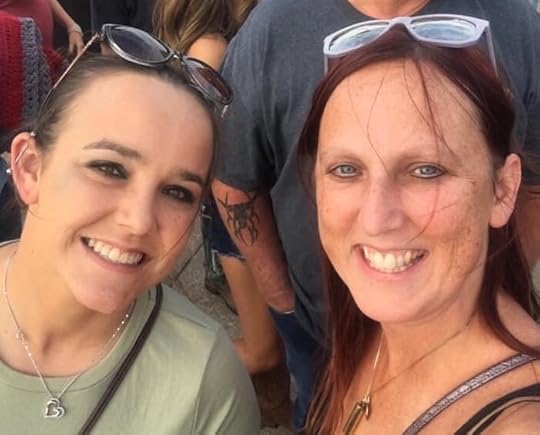 Andrea Marshall (left) with her sister
Andrea Marshall (left) with her sister
December 23, 2021
Sergeant Jim Elsener, U.S. Marine Corps – From Chicago to Da Nang…and Back
Sometimes in life we are presented with choices where the “right” choice is obvious. Sergeant Jim Elsener, U.S. Marine Corps, was given such a choice in January 1966. He could finish out his enlistment at Camp Lejeune, North Carolina, having served in the Marines with honor, and return to civilian life in the Midwest. Or he could choose a course that promised many unknowns. Jim chose the latter, and as the poet Carl Sandburg so eloquently expressed, that choice has made all the difference. This is Jim’s story.
Jim was born in Chicago, Illinois, in 1943. His father worked at the Douglas Aircraft Company’s assembly plant at what is now O’Hare International Airport. Having been born in 1912 and married with one son when the war began, Jim’s father wasn’t drafted until the very end of World War II. He never had to serve, though, because the war in Europe ended and he was no longer needed.
In 1947, Jim’s family moved to Battle Creek, Michigan, and later to Detroit, where his father worked as a floor covering salesman. In 1955, the family moved again to Jonesville, Michigan, a small town about 100 miles west of Detroit where his father and uncle entered the farm implement business. They stayed in Jonesville for all of Jim’s school years, frequently traveling to Chicago to visit family and friends. They still considered Chicago home.
Jim graduated from Jonesville High School in the spring of 1961. He enrolled at nearby Albion College, but after completing one unsatisfactory year, he enlisted in the Marines in July 1962.
Jim reported for boot camp at Marine Corps Recruit Depot (MCRD) San Diego. He succinctly sums up his experience there by saying “there was nothing warm and fuzzy about boot camp.” He did, however, have an exceptional junior drill instructor, Sergeant Johnny Adams. Jim and the other recruits respected him and, at the end of their training, agreed Sergeant Adams was a gifted leader and outstanding instructor.
After graduating from boot camp as a Private First Class (E-2), Jim went through infantry training at Camp Pendleton, California, and then radio school at MCRD San Diego, where he learned Morse Code. In June 1963, he received orders to his first permanent duty station, Communications Platoon, Headquarters & Service Company, 3rd Battalion, 8th Marines, at Camp LeJeune.
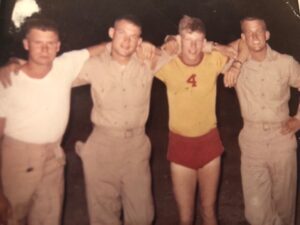 From left to right, Cpl John Briggs, Cpl Jim Elsener, LCpl Norm Jetland, and LCpl Bill Donohue on Vieques Island, Puerto Rico, in January 1965
From left to right, Cpl John Briggs, Cpl Jim Elsener, LCpl Norm Jetland, and LCpl Bill Donohue on Vieques Island, Puerto Rico, in January 1965In December of that same year, Jim’s battalion deployed aboard ships to the Caribbean for a three-month tour of duty. Jim and his unit sailed on the USS Monrovia (APA-31), which had seen service during World War II and Korea. Ports of call were Guantanamo Bay, Cuba; San Juan, Puerto Rico; and Camp Garcia on Vieques Island, Puerto Rico, where they practiced amphibious landings, close air support, and basic infantry tactics.
In January 1964, Jim’s battalion was sent to the Panama Canal Zone for jungle training at Fort Sherman, a U.S. Army base. The first night in-country, anti-American riots erupted in Panama’s capital, Panama City. The battalion was ordered back aboard ship and docked at the Coco Solo Naval Base at the Caribbean end of the canal to provide security. They stayed there for two months, living aboard ship but practicing riot control techniques ashore. Despite the unrest, the battalion was able to finish its jungle training before returning stateside. History has tagged this period as the “beginning of the end” for U.S. control of the Panama Canal Zone.
In October 1964, the Second Marine Division, which included Jim’s battalion, participated in Operation Steel Pike, the largest peacetime amphibious landing in history. Over 28,000 U.S. Marines and Spanish military took part in the exercise along the southwest coast of Spain. Unfortunately, it got off to a bad start when two helicopters ferrying Marines ashore collided, killing nine and injuring thirteen. As Jim waited on the flight deck of the USS Okinawa (LPH-3) for his turn to board a helicopter to join in the landing, he could see smoke and flames from the crash even though he was five miles out to sea. Once ashore, Jim’s battalion held a field memorial service for their fallen comrades. The exercise continued for seven days. After it concluded, the USS Okinawa stopped in La Rochelle, France, and Plymouth, England, giving Jim and his fellow Marines some well-deserved liberty before returning to the United States.
In the spring of 1965, Jim’s battalion once again deployed to the Caribbean for a lengthy stay in Vieques, Puerto Rico, and then Fort Sherman in the Panama Canal Zone. Other ports of call were Guantanamo Bay, Cuba; San Juan, Puerto Rico; Barbados; and Kingston, Jamaica. This was the battalion’s third deployment in two years.
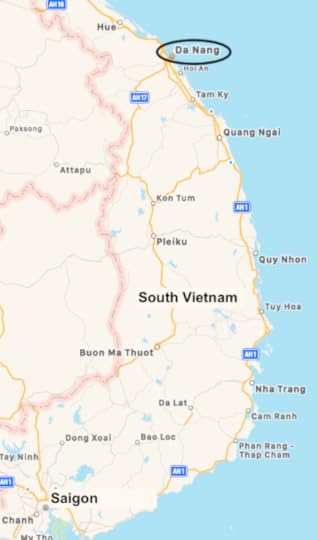 Map of South Vietnam showing Da Nang
Map of South Vietnam showing Da NangShortly after his battalion returned to Camp Lejeune, Jim’s tour of duty with the 8th Marines came to an end. In July 1965, he transferred across the base to the 10th Marine Regiment, which provides artillery fire support to the infantry regiments of the Second Marine Division. When Jim reported to the 10th Marines, he had less than one year remaining on his enlistment. Being a relative “short-timer,” he was in a position to ride out the rest of his time at Camp Lejeune and transition back to civilian life in the summer of 1966. However, the war in Vietnam had begun to escalate rapidly, both in terms of U.S. troop involvement and intensity. In March 1965, the 9th U.S. Marine Expeditionary Force had deployed to Da Nang, a city located approximately 380 miles northeast of Saigon, to provide security for the airport. It was the first Marine combat unit in Vietnam and the Marine Corps needed more men to fulfill its expanding combat mission. To help achieve this, on August 20, 1965, the Marine Corps involuntarily extended the enlistments of Jim and other regular Marines for four months, which meant Jim would not be eligible for discharge until November 1966.
Because Jim now had adequate time on his enlistment to go overseas, he was offered an “opportunity” to take an all-expense paid trip to Vietnam. He had trained for three years to do his job as a Marine and had been promoted to corporal (E-4). As a non-commissioned officer (NCO), he felt an obligation to do his part in the war. So, in February 1966, Jim took leave to visit his family and then reported to Camp Pendleton for three weeks of intense training. He spent long days and nights in the field operating on little sleep, learning lessons that could save his life in Vietnam.
In March 1966, Jim boarded an Air Force C-141 “Starlifter” transport jet and crossed the Pacific, stopping to refuel on Wake Island and finally landing on Okinawa. A week later, Jim and the other Marines deploying as individual replacements loaded onto an Air Force C-130 “Hercules” transport for the six-hour flight across the South China Sea to Da Nang.
Upon arrival in Da Nang, Jim was assigned as a radio operator with the 1st 8-Inch Howitzer Battery of the 12th Marines. At the time, the unit consisted of 8 officers and 200 enlisted Marines who manned and fired the powerful M115 8-inch howitzers. These big guns, known as the “King of Battle,” could hurl 200-pound high-explosive projectiles to targets located as far as fourteen miles away. Jim felt the earth shake every time one of the howitzers fired.
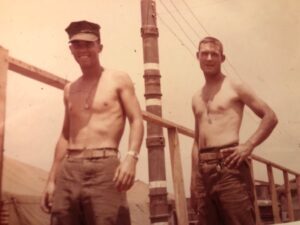 PFC Willie King (left) with Jim Elsener (right) in Vietnam in July 1966
PFC Willie King (left) with Jim Elsener (right) in Vietnam in July 1966While Jim was with the battery, the unit occupied three different fire bases, all within approximately ten miles of Da Nang. Several guns and crews were also deployed with Marine infantry units operating from fire bases deeper in the countryside.
Because Jim was a radio operator, he was assigned as the driver for the battery’s commanding officer (CO), Major Paul Wilson, a crusty Mustang (enlisted Marine who became an officer) and veteran of the Korean War. Each day Jim and Major Wilson visited the battery’s various firing positions to check on the guns and their crews. They also searched for new firing positions across the Da Nang tactical area of responsibility (TAOR). On May 1, 1966, Major Louis J. Cavallo, an ROTC graduate from the University of Maine and also a Korean War veteran, assumed command of the battery and kept Jim on as his driver. Jim especially admired Major Cavallo and thought he was a terrific leader.
Though Jim’s jeep had reinforced metal plates on the floor to protect against explosive devices, on many mornings Jim and his CO had to wait for engineers to clear the roads of mines before they could proceed. Often, they found themselves alone searching for new firing sites, which required them to be extra alert for trouble. On one occasion, they heard a bullet whiz by and saw it hit the road just in front of the jeep. Jim stepped on the gas and got out of there.
Jim experienced enemy fire another time when his fire base was probed by the enemy one night. When the shooting started, Jim was off duty. He jumped out of his sleeping quarters into a nearby sandbagged bunker and saw the hot end of an automatic weapon firing in his direction. The Marines at the closest guard post opened fire and silenced the enemy weapon. The unit then called in “Puff the Magic Dragon,” a fixed wing gunship operated by the U.S. Air Force to provide close air support for ground troops. “Puff” shot up the area outside the fire base, putting an end to any Viet Cong (VC) in the area.
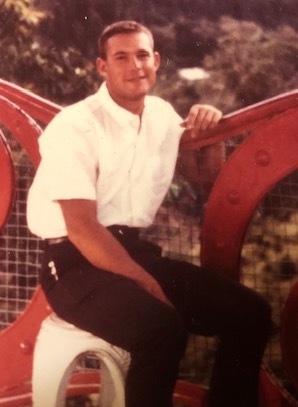 Jim on R&R in Hong Kong
Jim on R&R in Hong KongLife as a driver also had its perks. One day, Jim drove Major Cavallo to pick up two Red Cross “Donut Dollies” who were assigned to the battery. These young women had volunteered to support U.S. servicemembers in Vietnam by socializing with the men, playing cards and other games, telling jokes, and just trying to help maintain their morale while all were serving so far from home. Jim said it felt like a high school double date when they picked up the women in Da Nang. Jim drove, with one woman sitting in the passenger seat, while the Major and the other woman scrunched into the back next to the radio. At the fire base, the women ducked for cover when they first heard an eight-inch howitzer fire but were reassured when they learned it was outgoing – not incoming.
Besides his duty as the CO’s driver, Jim stood regular radio watches in the Fire Direction Center (FDC). The battery was always involved in direct support of Marine units engaged with the enemy or nighttime harassment and interdiction, known as H&I fire. Forward observers in the field would call in fire missions to Jim and the other radio operators, who would relay the firing coordinates and specifications (type of explosive, target adjustments, and number of rounds to be fired, as well as after action reports) to the FDC crew. The FDC crew would, in turn, prepare and communicate specific firing instructions to the gun crews via land line. It was crucial that all the information be passed accurately at every point of the communication trail.
Often, the Marine forward observers communicating with Jim would whisper into their radio handsets, reflecting their proximity to enemy forces. Sometimes all the forward observer could do was click the microphone to acknowledge message receipt because speaking was too dangerous. The fact that there were Marines in the field whose lives depended on him was never lost on Jim. He realized that even a small error in relaying the target coordinates could cost American lives.
Jim also often went on patrols around the perimeter of the fire base and in nearby villages searching for signs of enemy activity. And he and his fellow Marines fought a constant battle with the humid tropical environment trying to keep their weapons clean. If he didn’t give his M14 rifle a thorough cleaning almost every day, it would begin to rust—a grave sin for any Marine.
Jim was promoted to sergeant (E-5) in September 1966. The following month, he enjoyed R&R (rest and relaxation) in Hong Kong. That trip stands out in his mind because he recalls sitting in the lobby of his hotel reading a newspaper and learning the Baltimore Orioles had swept the Los Angeles Dodgers in four games in the 1966 World Series.
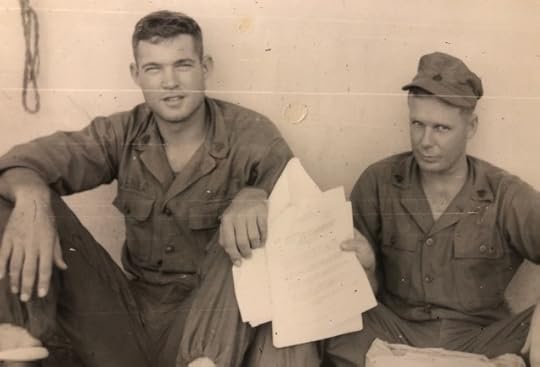 Jim Elsener and Bob Snead with their discharge papers
Jim Elsener and Bob Snead with their discharge papersBy December 1966, Jim had only one month left on his enlistment. Friend and Company Clerk, Sergeant Bob Snead, told Jim he could cut orders to get them both home before the holidays. Sergeant Snead was good to his word and the two men detached from their unit and headed to the Da Nang terminal to catch a flight to the United States via Okinawa.
As had happened when Jim arrived in country, the veterans getting ready to leave Vietnam began shouting warnings at the new troop arrivals disembarking from the airplane Jim would take on its return trip to Okinawa. This time, Jim was one of the NCO’s ordering the veterans to knock it off rather than being on the receiving end of their taunts. Jim departed Vietnam on December 10, 1966, after having spent eight months and twenty-two days in country.
On December 13, Jim left Okinawa on a chartered Continental Airlines flight bound for the United States. His journey ended at El Toro Marine Corps Air Station, where he received his Honorable Discharge on December 20. He had served four years, five months, and five days on active duty. Jim and Bob Snead then spent two days in Las Vegas “decompressing” before returning to their homes in time to spend Christmas with their families.
In January 1967, Jim drove to Los Angeles where he found work as a lineman for the telephone company. Although he enjoyed the job and the California lifestyle, he moved back to Michigan in the fall of 1967 to attend Western Michigan University using his GI Bill benefits. This time he excelled at college, graduating in 1970 with a degree in communications.
Jim’s first job was with the City News Bureau of Chicago, where he worked as a reporter and editor covering federal and state courts, politics, and the police beat. Two-and-a-half years later, he was hired by the Chicago Tribune, where he worked for five years as a general assignment reporter and covering politics and business. It was during this time that he met his future wife – Patricia, also a Tribune journalist.
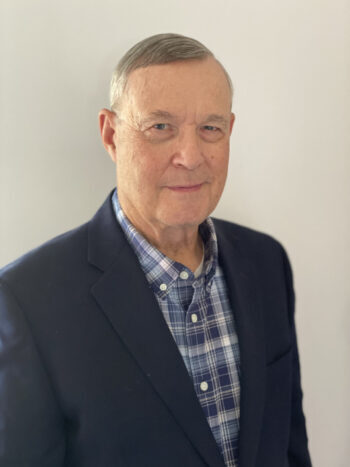 Jim Elsener
Jim ElsenerIn 1975, the Tribune sent Jim to study for a year as a Knight-Bagehot fellow at the prestigious Columbia University School of Journalism in New York City, where he studied business, economics, and finance. After returning to the Tribune, Jim specialized in covering economics and the energy industry. He spent three weeks in Alaska reporting on the construction of the Trans-Alaska oil pipeline, which was the major economic and environmental story of that era.
Jim left the Tribune in 1977 to manage a national newspaper trade association and in 1992, he and his wife started their own regional business publication. They sold the company fifteen years later to a local daily newspaper. He stayed with that company for seven years before retiring in 2017. During the span of his forty-two-year journalism and publishing career, he served as a reporter, columnist, editor, publisher, sales manager, and association executive.
Although Jim’s newspaper days are behind him, his writing continues. In August 2018, he published his first novel, The Last Road Trip, about a major league baseball player trying to figure out what comes next after his baseball playing days have ended. In June 2021, he released his second novel, Reflections of Valour, a story of untested lovers from opposite backgrounds during the tumultuous early days of the Vietnam War. The book is equal parts a love story and a soldier’s story at war, and is a fictionalized autobiography of Jim’s time in the Marine Corps. The story uses the Vietnam Memorial Wall as an important backdrop. Jim’s third book, a murder-mystery, is currently in the works. You can learn more about Jim on his author website.
Voices to Veterans is proud to salute Sergeant Jim Elsener for his distinguished service in the Marine Corps and in Vietnam. Whether conducting exercises off the coast of Spain, guarding the Panama Canal Zone, or helping to direct artillery fire on enemy positions near Da Nang, Jim served with distinction and answered our country’s call. We thank him for his years of service and wish him fair winds and following seas.
November 20, 2021
Staff Sergeant Dean Moss, U.S. Air Force – “A Year in Nha Trang: 1968-69”
Destiny has a way of just happening, whether you want it to or not. Staff Sergeant Dean Moss, U.S. Air Force, knows that all too well. No matter how many times he tried to point his life in a particular direction, destiny kept bringing him back to where he was meant to be. He was destined to serve our country in Vietnam, where his expertise with armaments would help protect American lives. And, he was destined to marry Barbara, his wife of fifty-two years, despite his impending deployment to a war zone and not knowing if he would ever return. This is his story.
Dean was born in Atlanta, Georgia, in 1947. He attended Atlanta city public schools, graduating from Franklin D. Roosevelt High School in 1965. Although he did not know her well yet, his future wife, Barbara, graduated from the same high school one year ahead of him. Since senior girls did not normally associate with junior boys, their romance was yet to be.
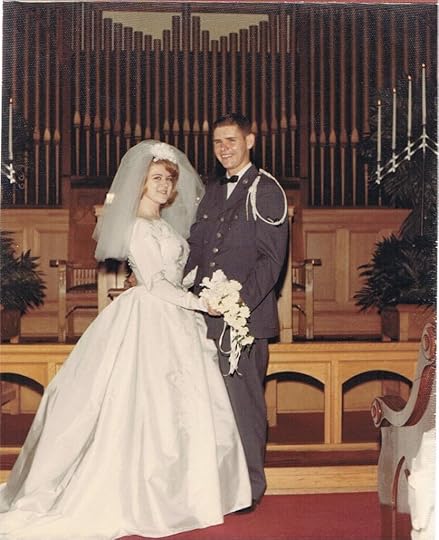 Dean and Barbara’s wedding
Dean and Barbara’s weddingDean’s graduation from high school in 1965 was bittersweet. He was thrilled to be moving on to the next stage of his life, but he also knew graduation meant the very real possibility of being drafted to fight in the rapidly escalating war in Vietnam. Against that backdrop, he enrolled in his local community college to study electronics, giving him a deferral from the draft. His courses were technical and vocationally oriented, rather than degree oriented, and he really enjoyed the hands-on work. As an offshoot of his studies, he earned his FCC license and became a HAM radio operator. The two-year course of study also gave him the opportunity to begin dating Barbara now that the junior/senior distinction of high school was gone.
Dean finished his electronics studies in 1967 and immediately received a notice to report for his pre-induction physical. Concerned with the prospect of being drafted into the Army or the Marines, he visited his local Air Force recruiter. The recruiter told him his two years of electronics training would allow him to bypass the Air Force’s introductory electronics school at Keesler Air Force Base in Biloxi, Mississippi, and immediately get to work in the electronics field. That sounded good to Dean, so he committed to the Air Force, enlisting in the delayed entry program in June 1967, with a report date three months later.
Dean’s parents and Barbara weren’t thrilled with Dean’s enlistment. He was an only child, so his parents were understandably worried. Barbara also worried because she had no idea what lay in store for Dean now that the Air Force owned him for the next four years. Dean reassured them his Air Force enlistment protected him from the draft and he would be safe. So, with heavy hearts, they bid Dean farewell in September when it came time for him to honor his commitment.
Dean reported for Basic Training at Lackland Air Force Base in September 1967. After graduating, Dean was shocked to learn he was being sent to Armament School at Lowery Air Force Base in Denver, Colorado. There, instead of commencing work in electronics as the recruiter had promised, he would learn how to arm airplanes with bombs, rockets, guns, and missiles. He also surmised that meant he would be headed to Vietnam as soon as he finished his training, rather than working on electronics systems stateside or in Europe.
Mustering all of the intestinal fortitude he could as a newly-minted Airman (E-2), Dean approached his sergeant and told him his new orders had to be a mistake. He told his sergeant he believed he was supposed to be working on electronics and the orders should have been to Keesler Air Force Base in Mississippi, not Lowery Air Force Base in Colorado. Dean’s sergeant left no room for misunderstanding. He told Dean he was in the Air Force now and would be assigned based on the needs of the Air Force, not his desires or what he thought he had been promised. He told Dean he was going to be a weapons mechanic and he better get used to it.
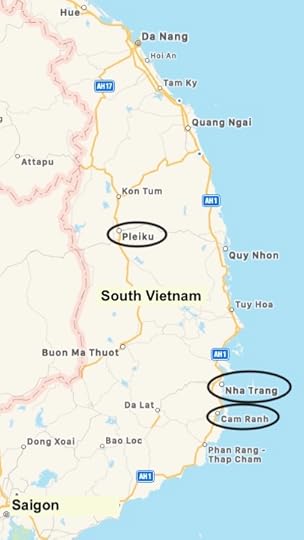 Dean Moss’s South Vietnam
Dean Moss’s South VietnamDean reported to Lowery Air Force Base as ordered and learned all about the art of arming aircraft. In week eleven of the fifteen-week course, Dean received orders to his first duty station: the 4th Air Commando Squadron in Pleiku, Republic of South Vietnam. While it was bad enough receiving orders to Vietnam, what he dreaded even more was calling Barbara and his parents to tell them the news. With coverage of the bloody Tet Offensive having recently played out on televisions all across America, their reaction was predictable. Dean also talked with Barbara about their future, not wanting her to commit to someone who was about to be sent to a war zone. That didn’t matter to Barbara, so after much thought and prayer, Dean proposed to her during a call he made from a phone booth in Colorado. After she accepted, Dean committed himself to finishing his training at Lowery, where he graduated as an Honor Graduate in April 1968.
After graduating from Armament School, Dean took thirty days leave. He went home to Atlanta on April 17th and married Barbara on May 4th. Behind the scenes and unbeknownst to Dean, his mother wrote their Congressman to request that Dean not be sent to Vietnam given he was the only male child in their family’s line. She told the Congressman if he died, there would be no one to carry on the family name. Her request was denied.
On May 20, 1968, just sixteen days after marrying Barbara, Dean found himself kissing her goodbye at Atlanta’s Hartsfield International Airport. It was the hardest thing Dean would ever do, not knowing if he would ever see her again. He then flew from Atlanta to Seattle, Washington, where he reported to McChord Air Force Base for further transit to Vietnam. At McChord, he and servicemen from all the other services boarded a chartered Northwest Orient flight bound for Vietnam. They flew nonstop to Tokyo, where the plane refueled and English-speaking Japanese stewardesses replaced their American counterparts for the final leg of their journey.
The flight landed in South Vietnam after dark at Cam Ranh Bay Air Base, located approximately 180 miles northeast of Saigon. Dean hadn’t been given any real training on what to expect other than to make sure he had a will and had given his wife a power of attorney, so everything about Vietnam surprised him. He hadn’t expected a lush tropical climate, nor had he been informed about the magnesium star shells that would be lazily descending over the base at night to help ward off would-be attackers. So, when Dean got off the plane and saw a flair floating over the base on a parachute, he wondered if the base was under attack. Even more worrisome, he’d received no training on things he’d heard about like booby traps and grenade attacks. All he’d had was M16 rifle training, but he’d not been issued a rifle or battle gear, so he felt very vulnerable. It made for a stressful transit from the flight line to the barracks and for a sleepless night once there, where he not only had to cope with the intense tropical heat, but also had to fight off a multitude of Vietnamese mosquitoes trying to welcome him to his new home.
The next morning, Dean boarded a C-130 cargo plane headed for Pleiku in South Vietnam’s Central Highlands. The plane made a spiraled approach into the airfield at Pleiku, causing Dean to hang on for dear life as it felt like the airplane was crashing. Once on the ground, he found it noticeably cooler than Cam Ranh Bay, especially since the monsoon season was just beginning. As per his orders, he reported to the 4th Air Commando Squadron, which operated AC-47 gunships, known as “Puff the Magic Dragon”. Each plane was equipped with three Gatling guns (called miniguns) that in a matter of seconds could saturate an area the size of a football field with thousands of 7.62-millimeter machine gun rounds. The squadron wanted Dean to man one of the airplane’s miniguns during flights to make sure it fired when needed. Unfortunately for the squadron, Dean did not have the level of training required for the job and they did not have time to train him. They told Dean they were going to send him back and, at least for a moment, Dean thought that meant he would be going back to the States.
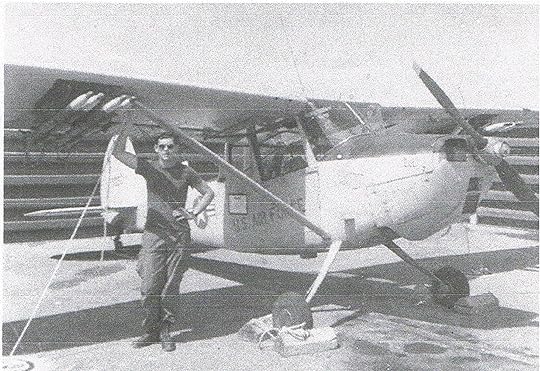 Dean standing with an O-1E Bird Dog loaded with rockets
Dean standing with an O-1E Bird Dog loaded with rocketsInstead, Dean was sent to the 21st Tactical Air Support Squadron (TASS) in Nha Trang, located on the coast just twenty-seven miles north of Cam Ranh Bay. The 21st TASS operated the single-engine Cessna O-1E “Bird Dog” and its replacement, the twin-engine Cessna O-2A. These slow-moving and vulnerable planes provided Forward Air Control (FAC) guidance to tactical aircraft and helped artillery units and even ships at sea attack enemy forces on the ground. In addition to radioing target coordinates, the Bird Dogs fired white-phosphorous rockets at enemy positions to mark their locations with smoke. Attack planes would then swoop in to deliver bombs and other ordnance on the targets. After the attack, the slow-moving Bird Dogs would again fly low over the enemy positions to assess the damage and, if necessary, call in another attack. It was dangerous work; often the planes came back riddled with bullet holes. With the pilot’s and spotter’s lives at risk on every mission, it was crucial the planes’ rocket launchers worked as intended. Dean’s new job was to make sure they did.
Keeping the rocket launchers in working order meant keeping them clean and making sure the rockets went where they were aimed. On one occasion, a pilot returned from a mission and reported the rockets were hitting left of target. When Dean inspected the plane, he found the metal sight extending vertically from the engine cowling had been bent to the left. He straightened it out and reported the problem solved. Before the plane could be considered fully mission capable, though, it had to undergo a functional check flight (FCF). The FCF pilot asked Dean to go along in the spotter seat behind the pilot. The two men flew until they found a deserted hut on stilts near a riverbank. Having been cleared to test the rockets, the pilot made a textbook approach toward the hut and fired two rockets, scoring direct hits and setting the burning hut adrift down the river. Unfortunately, the hut had not been completely deserted, but was occupied by a bunch of chickens who did not fare well in the blast. The pilot told Dean not to tell anyone what had happened, but somehow word leaked out. As a result, the pilot’s call sign was changed to Colonel Sanders and someone stenciled a dead chicken on the side of his airplane.
Despite arming planes daily with rockets, at times it was hard for Dean to remember he was in a war zone. His barracks was just across the road from where he worked, so going to work was easy. The mess hall always had hot food—it might have been powdered milk and powdered eggs—but Dean was keenly aware it was better than what the soldiers fighting in the jungle were getting. The base even had a beach designated as a U.S. Armed Forces Beach where people could swim or sunbath. The reminder of exactly where he was came in the form of North Vietnamese Army (NVA) and Viet Cong mortar attacks, which happened frequently. The attacks were primarily aimed at the airfield and the planes, but occasionally 81-millimeter mortars would stray into the barracks areas. Dean knew if a mortar hit his barracks, it would turn out badly, but there was nothing he could do about it, so he didn’t dwell on it.
One very popular amenity on the base was a nine-hole putt-putt golf course built on the beach by the base’s Red Horse Squadron (a heavy construction unit). During most mortar attacks, it seemed like the NVA and Viet Cong saved their very last round for the putt-putt course, believing its destruction would adversely impact American morale. Dean said the attacks didn’t achieve their goal, though, because the putt-putt course was often the first thing repaired and back in action after an attack.
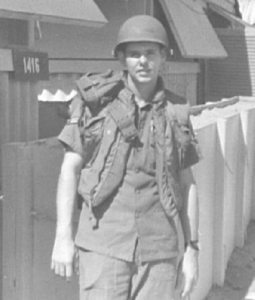 Dean in Nha Trang
Dean in Nha TrangFor Christmas 1968, Barbara sent Dean an eighteen-inch, fully decorated Christmas tree. Dean’s barracks chief permitted him to plug in the lights as long as he was in his quarters, so it brought a touch of Christmas cheer to Dean’s home away from home. The chapel also helped bring in the holiday by building a nativity scene on a grassy spot just outside the chapel. To represent Mary, Joseph, the baby Jesus, and the three wise men, the chapel wrote the Spiegel catalog company and it sent the chapel mannequins. The parachute shop made costumes for the mannequins and the nativity scene turned out beautifully. One night after it had been set up, two or three mortars hit right outside the chapel and blew the nativity scene apart, destroying all the characters except the baby Jesus. Dean said the following Sunday, there were a lot of extra people attending services at the chapel!
One other memorable Christmas event involved Dean’s selection to attend the Bob Hope USO Christmas Show being held on December 23rd at Cam Ranh Bay. He and the other airmen lucky enough to go were loaded into a truck for the twenty-seven mile drive south along the coastal highway. Everyone was particularly excited about the prospect of seeing Ann-Margret, so all were equipped with their cameras and lots of film. None, however, carried a weapon, so they joked the truck could have been commandeered by a Viet Cong guerilla with a pocketknife. Fortunately, that didn’t happen, and Dean and his friends enjoyed the show and made it back safely.
Because of his background in electronics, Dean was especially suited for working with the rocket launcher’s control system and wiring. On his own initiative, he developed a way to test the adequacy of the voltage being sent through the launching system, which earned him a certificate and a twenty-dollar bonus from the Air Force’s beneficial suggestion program. His knowledge was really put to the test when his squadron was tasked with completely rebuilding a Bird Dog badly damaged in a crash. The plane was in such bad shape that it had to be airlifted back to Nha Trang by a heavy-lift helicopter.
Dean’s NCOIC (non-commissioned officer in charge) asked him if he thought he could rewire the rocket launcher system by himself. Dean responded “absolutely” and spent the next two days doing so. When he finished, though, the system wasn’t registering the required voltage. Dean checked everything but couldn’t find the problem. Finally, he reported his failure to his NCOIC. Rather than chew him out, Dean’s NCOIC told him to take a break and come back in a couple of days with a clear head. Dean did, and to his surprise, the system worked flawlessly without him doing a thing. He initially suspected his NCOIC had found the problem and fixed it on his own, but his NCOIC assured him he had not. They then discovered what the problem was—the voltage meter Dean had used to test the system the first time had a faulty fuse. Now that he was testing with an accurate voltage meter, his rewiring of the system proved perfect.
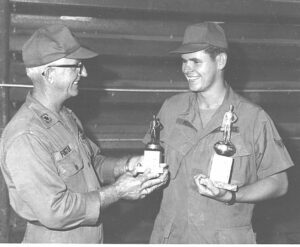 Dean receiving his 7th Air Force Munitions Maintenance Mechanic of the Quarter and Semi-Annual awards
Dean receiving his 7th Air Force Munitions Maintenance Mechanic of the Quarter and Semi-Annual awardsDespite being just an Airman First Class (E-3), Dean was recognized as an expert in his field. He was selected as the 7th Air Force Munitions Maintenance Mechanic of the Quarter and received a similar semi-annual award. He also taught and certified Airmen assigned to Forward Operating Locations on safely handling explosive ordnance and loading aircraft rockets. For his final Airman Performance Report, Dean was ranked in the top 1% of Airmen, making him feel very proud.
Consistent with tradition, Dean marked the beginning of his final month in South Vietnam by wearing the ribbon from a bottle of Seagram’s VO whiskey on the top button of his uniform shirt. One week prior to departure, he tied the ribbon into a bow. Finally, in May 1969, one year after arriving at Cam Ranh Bay, Dean boarded an outbound flight and departed South Vietnam for home.
Dean’s flight landed at McChord Air Force Base and he and five other service members hired a taxi to the Seattle-Tacoma International Airport. On the way there, the taxi rear-ended another vehicle and Dean hit his knee on the front console, causing him to limp slightly when he finally got out of the cab. At the airport, the only welcome Dean received was from war protestors, who heckled him as he limped along. One individual stayed close behind him, but Dean ignored him until the man called him a “baby killer”. Dean turned around and said, “I’m not a baby killer, so back off and leave me alone.” The protester responded by spitting in Dean’s face. Dean still has the scar on his hand from where he broke the heckler’s nose.
Dean returned to Atlanta and into Barbara’s welcoming arms. Because he had enlisted instead of being drafted, he still had two-and-a-half years to serve on his enlistment. The Air Force assigned him to the 428th Tactical Fighter Squadron at Nellis Air Force Base, so he and Barbara packed up and moved to Las Vegas, Nevada, to complete Dean’s service commitment. Dean was honorably discharged in September 1971 after turning down a $10,000 variable reenlistment bonus. He was ready for his civilian life to begin.
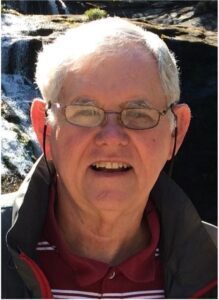 Dean Moss today
Dean Moss todayAfter being discharged, Dean and Barbara returned to Atlanta, where Dean took a job with a medical supply company. The job was short-lived because in June of 1972, Dean received a call from the federal government offering him a position with the Federal Aviation Administration (FAA) working on instrument landing systems. Dean took the job and in 1977, relocated to Knoxville, Tennessee, where he stayed with the FAA until he retired in 2009.
On Dean and Barbara’s 40th wedding anniversary, they began an amazing year-long journey together. Remembering they had written each other every day when Dean was in Vietnam, they went into their attic and retrieved the letters they had sent each other, having saved them in a box for all of these years. Instead of reading them all at once, they read the letters to each other on the same day they were written forty years before. The year-long experience rekindled so many memories for Dean that he began to take notes, creating a detailed journal of his experience in Vietnam. Dean used the journal to write a fascinating memoir of his year in Vietnam. You can read Dean’s memoir, The Other Side of the World, for an even deeper understanding of his service in Vietnam.
Dean and Barbara have two sons. David, the youngest, is serving as a Lieutenant Colonel in the Air Force. When David deployed to Iraq and had to spend a Christmas there, Dean and Barbara retrieved from the attic the Christmas tree Barbara had sent to Dean in Vietnam almost fifty years before. That little Christmas tree has thus brightened the spirits of two generations of service members in two war zones. Dean and Barbara’s other son, Scott, is serving as a Captain in the Navy. Sadly, Dean’s beloved wife, Barbara, passed away in 2020. They had been married for fifty-two years.
Voices to Veterans is proud to salute Staff Sergeant Dean Moss, U.S. Air Force, for his distinguished service in Vietnam during the Vietnam War. Although far from home and the people he loved, he dedicated his heart and soul to his duties, making sure the systems he was responsible for functioned properly, saving American lives. We are proud of what Dean has accomplished in his life and wish him fair winds and following seas.
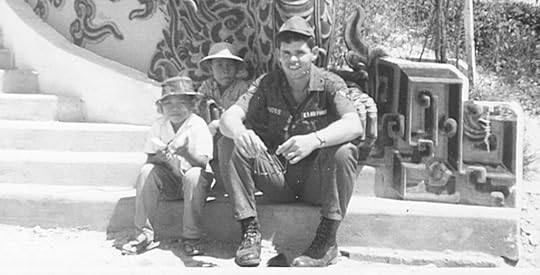 Dean with some boys in Nha Trang
Dean with some boys in Nha Trang
October 13, 2021
ETN3 Eugene Walker, U.S. Navy – Right Place, Right Time
Some people have a knack for telling stories. When you listen, you can’t help but share in their excitement as they reveal an unexpected outcome or describe an event that made a difference in their lives or the lives of other people. Petty Officer Third Class Eugene Walker, U.S. Navy, has the storytelling gift. If he were a guest at your home, you would easily listen for hours as he regaled you with stories about the places the Navy had taken him, the people he’d met, and the things he gotten to do. If you asked him to sum it up when he finished, you’d watch him get emotional and declare his service in the Navy opened doors for him throughout his entire life. This is his story.
Gene was born in Canton, Illinois, in July 1943. Soon after his birth, his father joined the Navy and was dispatched to the West Coast to join his ship, the escort carrier USS Altamaha (CVE 18). Gene’s father took his young wife with him, but they left Gene with his paternal grandparents, Wayne and Dale Walker. Gene’s parent’s marriage did not survive the war and, with Gene’s father deployed, Gene’s mother wrote Wayne Walker and told him she could not take Gene back. In her letter, she asked if Wayne and Dale could take care of Gene for her, which they did, raising Gene as if he were their own son.
Gene began at a very young age helping around his grandparent’s farm. He fed and groomed the animals and even learned to drive a tractor when he was six years old. He started first grade in a one-room schoolhouse, but then his grandparents moved in 1950 to another farm in Ipava, Illinois, a small town located about 175 miles southwest of Chicago. This move allowed Gene to finish school in a larger school district enrolling students from Ipava, Vermont, and Table Grove, Illinois.
All through elementary, middle, and high school, Gene worked hard on the farm. If the buildings needed repair or the barn’s roof needed patching or new shingles, Gene and his grandfather did it themselves. Needless to say, the work around the farm kept Gene in great shape, so it was only natural that he played football and ran track for VIT High School. Gene graduated from high school in the spring of 1961, one of forty-four VIT “Hornet” seniors to graduate that year.
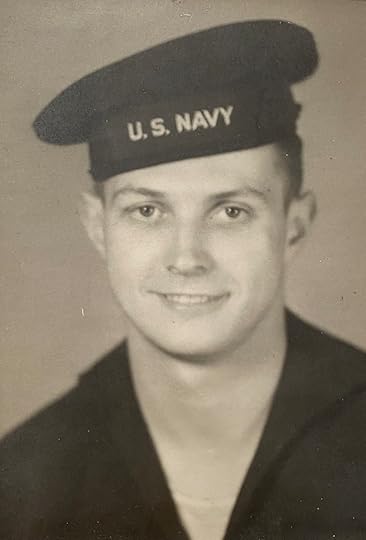 Gene’s father, Eugene W. Walker, Sr.
Gene’s father, Eugene W. Walker, Sr.After high school, Gene attended Canton Community College beginning in the fall of 1961. He attended on a scholarship and graduated in the spring of 1963 with an Associate of Arts degree in Agriculture. With his new degree in hand, he returned to working on his grandfather’s farm. He was concerned, though, that with the U.S. involvement in Vietnam growing, he might be drafted into the Army or the Marines, which he did not see as favorable options. His friends told him the best option would be to enlist in the Air Force or the Navy. Gene heeded their advice and, influenced by his father’s service in the Navy, visited a Navy recruiter in Canton, Illinois. He liked what he heard and agreed to enlist.
Given the small rural environment, Gene needed to travel to Naval Station Great Lakes to get his enlistment physical and sign the enlistment contract. To make that happen, Gene’s grandfather dropped him off with the recruiter on the morning on November 18, 1963. The recruiter took him to the Naval Station, where he began the intake process the next day. When it came time for the eye exam as part of his physical, the optometrist told him to stand behind a line on the floor, take off his glasses, and read the smallest line he could see clearly. Gene did as instructed and replied, “I can’t read anything, sir.” Unfazed, the optometrist told Gene to start walking toward the eye chart and let him know when he could read the letters. Gene got to within two feet of the wall and announced that he could now read the giant “E” on the chart. Seeing that Gene was acutely nearsighted, the optometrist announced, “we can’t use you.”
Gene was devastated. He’d told everyone at home he’d joined the Navy and would now have to go back and let them know the Navy rejected him. Then, a First Class Petty Officer who’d been helping him navigate the intake process asked Gene if he wanted to go home. Gene told him, “No”. The First Class Petty Officer responded, “well you aced the math test and the only thing you’ve not passed is the eye exam, so let’s see if there is anything we can do.” He took Gene back to the optometrist and asked if there was any way the optometrist could let Gene in. The optometrist thought for a moment and said, “if he promises to keep two pairs of glasses with him at all times, I’ll pass him.” Gene readily agreed. With the final hurdle out of the way, Gene raised his right hand with the other recruits being inducted that day and took the oath of enlistment.
The First Class Petty Officer who had saved Gene’s enlistment wasn’t finished yet. He told Gene it was his lucky day. Because he had scored so high in math, he had the choice of attending boot camp at the nearby Recruit Training Center at Naval Station Great Lakes where the winter temperatures were beginning to take hold, or he could attend boot camp at the Naval Training Center in sunny San Diego. Either way, after boot camp he would go to school at Naval Station Treasure Island in San Francisco to learn to be an Electronics Technician. Gene chose San Diego and soon found himself with other lucky Navy and Marine recruits on a plane departing Chicago’s O’Hare Airport en route to San Diego.
Gene and the other new recruits arrived in San Diego at 2:00 a.m. on the morning of November 20. As the service representatives weren’t ready to take charge of their newest recruits, they told the Marine recruits to file off the plane and line up on the right and had the Navy recruits file off the plane and line up on the left. As soon as the Marine representatives arrived, they started chewing out their recruits, just like Gene had seen in the movies. Watching that reinforced his decision to enlist in the Navy—he was glad he wasn’t one of those poor Marine recruits.
Two days after Gene started boot camp in San Diego, President John F. Kennedy was assassinated. Not knowing what would happen in the country or what the military might be called upon to do, Gene wondered what he had gotten himself into. Fortunately, his training company was strong and he was designated a platoon leader, so training went well. He learned to handle the M1 Garand rifle, which his company marched around with during the course of the day. The recruits also quickly learned the rifle had another purpose. If they messed up on something, they would have to run around the grinder with the heavy M1 rifle above their head. The sanction had the desired affect and everyone did their best to avoid it. Then, on December 13, 1963, Gene received a notification through the Red Cross that his grandmother, Dale Walker, had passed away. He was granted emergency leave and attended his grandmother’s funeral in Lewiston, Illinois, in his Navy dress blue uniform. The burial at the cemetery was bitter cold; the temperature was five degrees below zero.
After the funeral, Gene returned to San Diego to complete boot camp. His former company had continued training in his absence, so Gene was assigned to a new company to make up the training he had missed. Since he knew none of the men in the new company and they had already bonded prior to his arrival, Gene set his sights on just getting through the training.
As boot camp graduation drew near, a Chief Boatswain’s Mate approached Gene out of the blue and told him he had a friend that Gene knew and he wanted Gene to invite the friend to graduation. He told Gene to write the friend a letter and tell her it was okay to come. Gene did as instructed, which is how Gene’s mother was able to attend his graduation. This was just the third time in twenty years Gene had seen his mother.
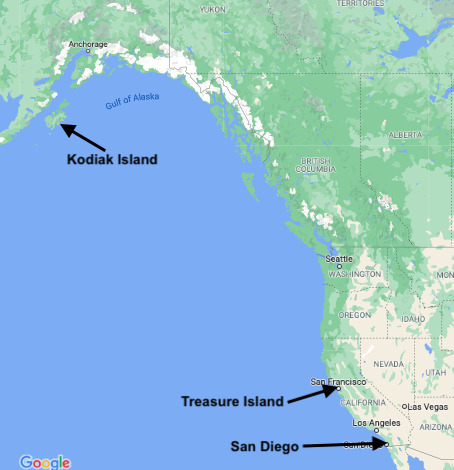 Gene’s initial assignments on the West Coast
Gene’s initial assignments on the West CoastGene graduated at the end of February 1964 as a full Seaman (E-3) because unlike most of the other recruits, he had completed two years of college. After graduation, he took two weeks leave in Illinois and then reported to Naval Station Treasure Island for Electronics Technician “A” school around the first of March. Life as a Seaman at Treasure Island was pretty good, although he did occasionally have to stand duty on weekends. One weekend he was assigned as the Battalion Runner, which meant he had to drive all around Treasure Island delivering messages to various commands. One of the messages he had to deliver was addressed to the Navy Brig. When the Duty Petty Officer handed him the letter to deliver, he told Gene to be sure he knew his general orders before delivering the letter because the brig was sure to ask Gene about them.
When Gene arrived at the brig, a brig Petty Officer brought him inside. In front of him were two lines on the floor—one blue and one red. Gene also saw two sailors, each holding up a five-inch shell with outstretched arms. Both were sweating profusely and struggling to hold the heavy shells at arms-length. The brig Petty Officer barked an order at Gene not to cross the blue line without permission, which Gene had no intention of doing anyway. The Petty Officer then asked Gene to recite the seven general orders, which he did. At that point, the situation relaxed and Gene asked the Petty Officer why the two sailors were holding the shells. The Petty Officer responded, “They didn’t listen. You’re dismissed.” That was all Gene needed to hear and he quickly departed. He was glad to never step foot in a Navy brig again.
On another weekend in March 1964, Gene felt like his hair was getting a little shaggy, so he went to the base barber shop to get a haircut. Apparently, there were lots of other sailors who felt the same way because the waiting line for a haircut ran all the way out the barber shop’s door. Gene dutifully went to the end of the line to wait his turn. While he was standing there, one of the two barbers reserved for cutting officers’ hair (so officers wouldn’t have to wait long to get haircuts) came out of the shop and walked up to Gene at the end of the line. He said he wasn’t cutting any officer’s hair just now and he could cut Gene’s hair on the condition that Gene not say anything to anybody about it. Gene agreed and walked into the shop with the barber, taking his seat in the officer’s chair.
After the barber started cutting Gene’s hair, a Marine Sergeant Major “dressed to the nines” in his meticulous Marine uniform rushed into the shop and approached Gene’s barber and the other barber reserved for cutting officers’ hair (his chair was empty). “Sirs, the Admiral wishes to get his hair cut,” the Sergeant Major announced. Gene was mortified. The one time he’d bent the rules and now he, a Seaman only a month out of boot camp, was going to be caught getting his hair cut in the officers’ chair by an admiral. Before he could get out of the chair, a gray-haired older gentleman walked into the shop and approached him. “Hello, sailor,” he said. “Where are you from?” Gene responded, “Ipava, Illinois, sir.” The man answered, “We’ll, I must admit I don’t know where that is. What’s your name?” Now standing, Gene responded, “Walker, sir. Eugene.” “Well, I guess you don’t know who I am,” the man continued. Gene admitted he did not. The man replied, “Chester Nimitz”. Gene could not believe it. He was actually speaking to Fleet Admiral Chester W. Nimitz, the legendary U.S. Admiral and architect of the U.S. Pacific Fleet’s victorious naval campaign in World War II. Gene shook the Admiral’s hand and then the Admiral got his hair cut in the other chair. This was an experience Gene would never forget—he had been at the right place at the right time. Admiral Nimitz would pass away two years later and be buried next to his wife at Golden Gate National Cemetery in San Bruno, California. The cemetery would later prove to be significant for Gene and his family, as well.
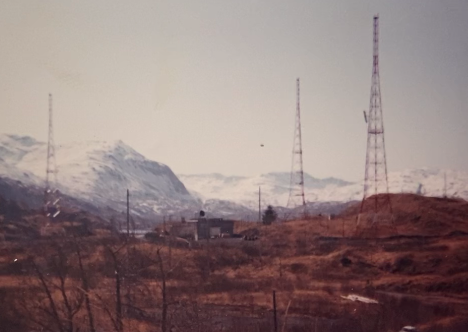 The Buskin Lake transmitter site on Kodiak Island
The Buskin Lake transmitter site on Kodiak IslandGene completed Electronics Technician “A” school in approximately six months. He was now ready for his first assignment, which was the Buskin Lake Transmitter Site on Kodiak Island, Alaska. As soon as he received his orders, he had to check an atlas to see where Kodiak Island was. He took leave in Illinois, then boarded a plane at O’Hare Airport in Chicago and flew to Anchorage, Alaska, via Seattle-Tacoma International Airport. In Anchorage, he boarded a Navy Albatross seaplane for the final leg of the journey to Kodiak Island, located in the Gulf of Alaska 30 miles off Alaska’s southern coast and 250 miles southwest of Anchorage.
Gene’s tour of duty at the Buskin Lake Transmitter Site began in September 1964. The site was a major communications facility supporting the Navy’s communications throughout the Pacific. As Gene’s rate (the Navy term for a sailor’s occupational specialty) was Electronics Technician Communications, the assignment was tailor-made for him. He worked on transmitter equipment, ran jumpers, did troubleshooting, repaired or replaced anything that broke, and used test equipment to make sure Navy communications in the Pacific flowed uninterrupted. This was a challenge because the equipment was old analog equipment, but also exciting because the Navy was beginning to move to more sophisticated electronics. The result was Gene gained valuable experience during his time on the island.
Given Buskin Lake’s remote location, there was little to do outside of work. The weather was surprisingly mild and Gene found it similar in many respects to the temperatures he had grown accustomed to growing up in Central Illinois. In the summer, he was able to go on hikes with his friends into the surrounding countryside, which was largely untouched by civilization. However, they had to carry weapons with them to fend off any bears they might encounter. In fact, it was not uncommon to see bears on the installation rummaging through trash dumpsters in search of food. They also had a pool table and ping pong tables to pass the time, and the installation would show movies. The radio station at nearby Naval Air Station Kodiak added music to the entertainment mix.
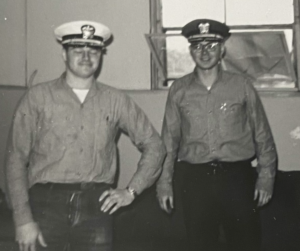 Gene (right) and friend trying on officers’ covers
Gene (right) and friend trying on officers’ coversOne thing the Buskin Lake Transmitter Site did have was outstanding food. The Buskin River was packed full of King Salmon, and Alaskan King Crab were also readily available. With those fresh catches at his disposal, the cook at the galley made sure the men ate well. So well, that when officers from Naval Air Station Kodiak visited the Buskin Lake facility, the lieutenant in charge always took them to the galley to eat. During one such visit while the officers were eating, Gene and two of his friends saw the officers’ covers (the Navy term for hats) in the galley’s outer area. They took turns trying them on and one of them took a picture. They were glad they didn’t get caught as they were sure the lieutenant would have “had their asses.”
Gene’s one-year tour on Kodiak Island came to an end in September 1965. He requested to extend but it was disallowed because it was his turn for sea duty. He received orders to report to USS Chevalier (DD-805), a World War II era Gearing class destroyer currently in drydock at Hunters Point Naval Shipyard in San Francisco. Before reporting to his new ship, he again took leave in Illinois. Then, with all of his possessions loaded into his green canvas sea bag, he flew from St. Louis to San Francisco and joined his ship at the end of September 1965.
Gene really enjoyed his time on USS Chevalier. Because he was an experienced Electronics Technician, he didn’t have to work in the ship’s galley like the other junior enlisted sailors did upon first reporting to the ship. Instead, he jumped right into working on the ship’s communications gear, making sure the ship could communicate reliably with the rest of the fleet. He also helped work on the ship’s radar antennas, not because of any special training he had, but because he’d told some of his new shipmates about his life growing up on his grandfather’s farm. One day, Radarman Second Class Jim Lorenz approached him and said “I hear you used to work on barn roofs and aren’t afraid of heights. When work needs to be done on the radar antennas on the ship’s mast, I need someone to go with me and the other guys are scared.” From then on, Gene climbed the ship’s mast with Petty Officer Lorenz to work on the antennas. It was perilous work when the ship was at sea, especially when the ship rocked from side to side. When the ship rolled to port (left) and Gene looked down, all he could see was water. When the ship righted and he looked down, all he could see was the center of the ship. When the ship rolled to starboard (right) and he looked down, again all he saw was water. The work was not for the fainthearted.
 USS Chevalier (DD 805) Source: U.S. Navy
USS Chevalier (DD 805) Source: U.S. NavyOn May 12, 1966, USS Chevalier departed San Diego for a deployment to the Western Pacific. On the way there, they stopped at Pearl Harbor, Hawaii, before making the long voyage to the Yokosuka, Japan, as part of the aircraft carrier USS Constellation (CV 64) task group. Throughout the six-month deployment with USS Constellation, USS Chevalier would often serve as “plane guard” for the giant aircraft carrier when it conducted flight operations. This meant USS Chevalier would take station near the carrier and be ready to rescue any aircrew in the event one of USS Constellation’s aircraft made a water landing. USS Chevalier had a diver onboard who would jump into the water near the downed aircraft and attempt to rescue any survivors before the aircraft sank. Gene only remembers a one occasion where a rescue was attempted but the pilot did not survive.
After a brief stay in Yokosuka from June 1-7, the Chevalier got underway again with the other ships in the Constellation’s task group heading for Vietnam via Subic Bay in the Philippines. When the Chevalier arrived off the coast of South Vietnam, it detached from the task group and sailed up the Saigon River. Because Chevalier’s draft was only fourteen feet, four inches, it could navigate in the river’s shallow water. Once it sailed past Saigon, it provided fire support the troops ashore by bombarding enemy targets. To ensure Chevalier’s guns hit their targets, spotter planes radioed coordinates to the ship and the ship then blasted those areas with its six five-inch guns. The Chevalier wasn’t the only asset being called upon to assist the troops in the vicinity. On one occasion during the ship’s Saigon River mission, Gene watched as an AC-47 “Puff the Magic Dragon” gunship rained down machine gun fire, accented by thousands of tracer rounds, on the enemy ashore. During the period from June 15-21, USS Chevalier expended all of its five-inch ammunition in support of allied forces on the ground.
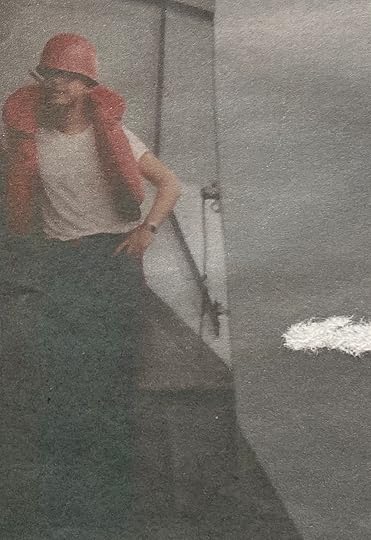 Gene onboard USS Chevalier (DD 805)
Gene onboard USS Chevalier (DD 805)After its gunnery support mission, USS Chevalier rejoined USS Constellation and resumed plane guard duties. Gene worked on equipment, but also spent time on the bridge in case any of the communications equipment went down and needed a quick repair. When the ship needed to resupply, it would sail close alongside a supply ship. While maintaining a steady course and speed, the ship would refuel and resupply from hoses and lines connected between the two ships. The evolution was dangerous, so the crew was placed at a heightened state of readiness. Gene’s replenishment position was amidships, where he could clearly see how well the replenishment was proceeding.
For one such replenishment, a new Lieutenant Junior Grade had the conn of USS Chevalier as she pulled alongside the resupply ship, USS Mars (AFS-1). Gene and the other crewmembers at his station thought the Chevalier was getting too close to the Mars until a First Class Boatswain’s Mate couldn’t take it any longer. He radioed to the bridge that they were so close he could reach out and touch the Mars from where he was standing. The Chevalier’s captain intervened and a safe distance was restored between the two ships.
After its duty in Vietnam, USS Chevalier headed home, retracing the steps it took on the way over. One difference, though, was the ship stopped in Singapore, which meant the ship crossed into the southern hemisphere. To mark the occasion, the ship’s crew held the traditional crossing the line ceremony, where sailors like Gene who had never done so before transitioned from uninitiated “pollywogs” to trusty “shellbacks”. The raucous ceremony is usually memorialized by a certificate issued by the Court of King Neptune and becomes a cherished part of a sailor’s memorabilia.
USS Chevalier returned to San Diego in October 1966. Gene would go out with the ship one more time on a trip to Acapulco, Mexico, which he thoroughly enjoyed. The ship then went into a maintenance and workup period as it prepared to deploy again to the Western Pacific in 1967. However, because Gene’s enlistment would expire while the ship was deployed, he transferred in May to the USS Hamner (DD 718), another Gearing Class destroyer homeported in San Diego.
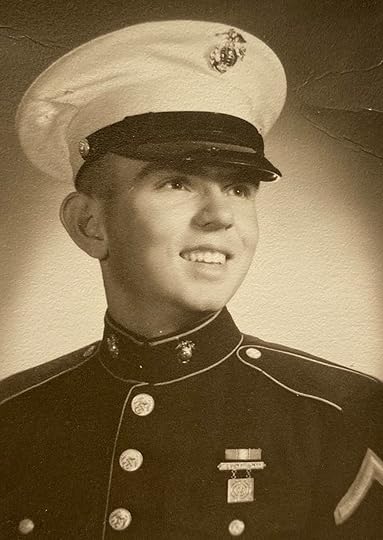 Private Medford Adarine Chrysler, USMC
Private Medford Adarine Chrysler, USMCOn July 2, 1967, Gene’s mother called him with some very bad news. His brother, Medford Adarine Chrysler, had been killed in Vietnam. His mother asked him to attend the funeral, which was to be at the Golden Gate National Cemetery, the same place Fleet Admiral Chester Nimitz was buried. She also asked him to go to the morgue to identify the body, which Gene was able to do based upon a tattoo Medford had on his right forearm. Medford, a Marine who died fighting the North Vietnamese in Quang Tri Province near the demilitarized zone between North and South Vietnam, was buried with full military honors. This was the second funeral Gene attended in his dress Navy uniform.
Gene remained onboard USS Hamner until he accepted an early discharge in August 1967 to attend Southern Illinois University. At the time of his discharge, he was a Petty Officer Third Class. He attended Southern Illinois University as planned, but it wasn’t what he was looking for, so he returned to Ipava to work at his grandfather’s gas station. In 1972, he was ready to move on from that, too, and applied for a job with AT&T in Peoria, Illinois. While the clerk at the AT&T office told him they weren’t hiring, he submitted his application anyway. When he returned home, there was a message waiting for him from a Mrs. Dahl at AT&T.
Gene returned the call and Mrs. Dahl said she had seen his application. She asked him why he thought he would be a good fit for AT&T. When he told her he had been an Electronics Technician in the Navy specializing in communications, she asked him if he could start in two weeks. So began Gene’s thirty-four-year career with AT&T. His job took him from Illinois to California and back again, and he loved the work. He retired from AT&T in 2005.
Gene now lives in Springfield, Illinois, where he is active in VFW Post 755. Since joining the Post, he’s reached out to veterans in need by helping coordinate assistance through the Illinois Department of Veterans Affairs. When veterans pass away, he serves on the burial detail at Camp Butler National Cemetery and has performed countless burial ceremonies honoring veterans as they are laid to their final rest. He also is a Civil War reenactor, playing the role of Major John Aaron Rawlins, General Ulysses S. Grant’s Chief of Staff.
Voices to Veterans is proud to salute Electronics Technician Communications Third Class Eugene Walker for his dedicated service in the U.S. Navy. His service took him to two extremes, from a remote island off the coast of Alaska to the war in Southeast Asia. Wherever he was, he served with distinction, ably representing the United States. We thank him for all he has done for our country and wish him fair winds and following seas.
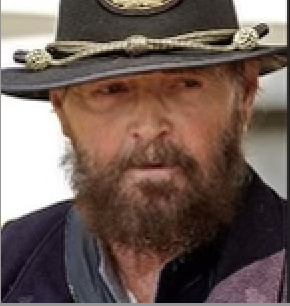 Gene portraying Major John Aaron Rawlins
Gene portraying Major John Aaron Rawlins
September 11, 2021
Command Chief Master Sergeant Dave Himmer, U.S. Air Force (Ret.) – Coming of Age in Vietnam
Veterans influence and inspire us, often to follow in their footsteps. Such was the case with Command Chief Master Sergeant Dave Himmer, U.S. Air Force (retired), who looked up to his high school history teacher – a Marine in World War II – and said, “I want to be like him”. Although Dave didn’t make it into the Marines right away, he did begin his long and distinguished military career with a combat tour as an Army infantry soldier in Vietnam. Since then, countless soldiers, airmen, and Marines have looked at Dave and said, “I want to be like him.” This is Dave’s story.
Dave grew up in a bygone era. He was born in March 1945 and raised on his family’s 160-acre farm southwest of Rochester, Minnesota, in a farming community called Pleasant Valley. His parents, Stan and Margaret Himmer, and their six children tended dairy cows, hogs, and chickens and grew corn, oats, and hay to feed the animals. Later, they leased an additional eighty acres, where they grew soybeans as a cash crop. Dave milked cows in the morning and again at night with the milk flowing into traditional milk cans. When it came time for harvest, the family did not have a combine so crops had to be bundled and pulled in wagons by horses to where it would be stored. Meats, fruits, and vegetables had to be canned for long-term storage because they didn’t have a freezer. The farm kept Dave and his three brothers and two sisters busy, but it also taught them the value of hard work and made their family very close. Another critical aspect of Dave’s family life was the strong Christian faith his parents modeled for him and his siblings. They taught the children the importance of daily prayer and active participation in their local parish community. Dave has continued these practices throughout his life.
Life on the farm wasn’t all work—it was fun, too. Dave loved working with the animals and was active in the Racine Ramblers 4-H Club. He enjoyed taking his farm’s livestock to the county fair and hunting around the farm, where rabbits, squirrels, and pheasants were plentiful. The family got its first telephone and television when Dave was around twelve, adding new entertainment options. Dave’s dad also built a milk house allowing the cows’ milk to flow directly into a large tank rather than into the heavy milk cans, acquired tractors and a combine for harvesting his crops, and installed a freezer making canning everything no longer necessary. These improvements reduced the family’s workload and gave them more time for other pursuits, like school and studying.
The Himmer children initially attended school in a one-room schoolhouse with no phone, indoor plumbing, or running water. Each morning, two students were assigned to walk to a farm across the road from the school to carry back water for students to drink and wash their hands. The school covered grades one through eight, but after Dave completed the fifth grade, the school consolidated with the Stewartville School District. That allowed Dave to attend Stewartville schools for grades six through twelve, including Stewartville High School.
Several of Dave’s high school teachers were World War II veterans who went to college on the GI Bill after the war. Their service during the war inspired Dave. Most influential was his history teacher, a Marine who fought his way across the Pacific in such battles as Guadalcanal, Tarawa, and Iwo Jima. Occasionally, the teacher would talk to his classes about his experiences in the Marines, mesmerizing Dave. So much so, Dave decided to follow in his history teacher’s footsteps and join the Marines as soon as he graduated from high school.
The hard work Dave did on his family’s farm kept him strong and in good shape, making him a natural for the Stewartville High wrestling team. He enjoyed being on the team and learned a lot from the experience, although he injured his knee, an injury that would hamper him during the latter part of his senior year and into his college years. Little did he know the seemingly minor injury would soon change the course of his life.
Dave graduated from Stewartville High School in May 1963 and tried to enlist in the Marine Corps. Unfortunately, the Marines would not take him because of his injured knee. Dave’s second option was college, so he enrolled in the fall at Rochester Community College. To get the money he needed for school, he took a part-time job at St. Mary’s Hospital in Rochester working in the maintenance department, which meant washing windows in the summer for the 1318-bed hospital for most of the day. While there, he took on another part-time job working for the Gold Cross Ambulance Company and did some work in the hospital’s emergency room. During a subsequent summer, he worked for a medical neurologist at the Mayo Clinic, assisting him with his cerebral vascular research.
Dave’s finances held out through the first year of college and extended into the second and third, although he had to take a reduced class load. He also wrestled for his college team, aggravating his knee injury, which now periodically filled with water and had to be drained. As the end of the quarter neared in the first week of December 1966, Dave’s boss at Gold Cross asked him to do a road trip with an ambulance. Dave didn’t want to go because he had a final exam that Friday he would have to miss, but agreed when his boss said he would call Dave’s professor and explain Dave’s absence. When Dave returned on Monday and asked his professor to allow him to take the test, his professor refused and failed Dave for the quarter. Angry and tired of living without money, Dave left college and began working full-time.
With school behind him, Dave set out on his own. Now working full-time for Gold Cross Ambulance, he lived in an apartment in Rochester. At the same time, the Vietnam War was escalating, and young men like Dave were being drafted for service in the Army and the Marines. Dave’s knee injury, however, continued to keep him out of the military. In fact, Dave was drafted after leaving college, but twice failed the physical because of his knee. At each physical, he produced a letter from his orthopedic doctor explaining the nature of his injury and the treatment he’d received. Each time he was sent home. Realizing his injury would keep him out of the military forever, Dave got engaged in 1967 and prepared to get on with his life. His doctor also treated his knee with Cortisone injections, which for the first time seemed to help his injury heal.
Toward the end of 1967 or early in 1968, Dave was again told to report to the Military Entrance Processing Station (MEPS) on the second floor of the Minneapolis Post Office for his third draft-related physical. His report date was February 20, 1968, less than two weeks after he returned from his honeymoon and as images of the Tet Offensive dominated the news broadcasts on TV sets across America. Dave told his new bride not to worry and went to the physical, just as he had done two times before. When he gave the examining physician the letter from his orthopedic doctor, the physician tore it up in front of him. Dave was then shuffled into another room with the other draftees who had gotten their physicals. An Air Force officer stood at a podium at the front of the room and told the men to raise their right hands. Dave did not comply and they asked him why. He told them he wasn’t eligible to be drafted because his classification was 1-Y, not 1-A. Unfazed, they took him to another room, where he waited until two soldiers returned with a new draft card reflecting he was now 1-A. He then returned to the main room and raised his right hand with everyone else. He was officially in the Army.
Dave was shocked. He’d told his wife he’d be back shortly and now he had just five minutes to call her and tell her he was about to board a bus to the Minneapolis/St. Paul airport en route to boot camp. After that difficult call, as he left the building to board the bus, protestors invited him and the other draftees to go to Canada. Although distraught with the turn of events, Dave thought of his high school history teacher, and of his uncle who fought in North Africa and Italy, and boarded the bus. He committed to serving his country just like they had, knowing full well he had likely just taken the first step to being shipped off to the war in Vietnam.
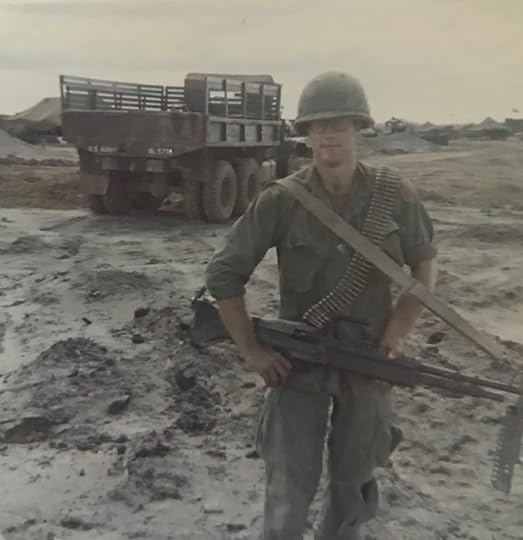 Dave Himmer in Vietnam with an M60 machine gun
Dave Himmer in Vietnam with an M60 machine gunAt the airport, Dave and the other draftees boarded a chartered flight that took them to Milwaukee, where more draftees filled the remaining seats. The now-full plane flew directly to Fort Campbell, Kentucky, where waiting soldiers screamed at them to get off the plane and into nearby buses. The temperature was a balmy four degrees below zero, six degrees warmer than it was when Dave left Minneapolis/St. Paul.
Once they got to the barracks, one of the drill sergeants immediately focused on a guy with long hair and a guitar. The drill sergeant had the draftee drop down and do pushups over the guitar, while singing “I love you” to it. When the draftee turned in for the night, he had to sleep with his guitar. He was, however, allowed to keep the guitar. Toward the end of boot camp, he was permitted to play it and sing—he just had to prove himself first.
During the first week at Fort Campbell, Dave received his uniforms, got lots of shots, took aptitude tests, did “KP” (kitchen police), and stood fire watches in the barracks. At the end of that week, the first official week of Basic Training began. Dave’s drill sergeant was Sergeant Pinckney, a demanding soldier who let the draftees know early on he expected perfection and attention to detail. More important, he had served in Vietnam, so he did everything he could to prepare the draftees to be ready for war. The men respected him for that and gave him their all. Only one man in the company failed to conform and was mustered out of boot camp.
Another reason Dave’s company did so well was an older draftee from Memphis named Thurmond. At twenty-seven, he was an old man compared to the mostly eighteen-year-olds in the company. He told everyone not to worry. He said, “They can’t kill us, so all we have to do is do a good job and they will start to leave us alone.” That is exactly what happened.
Because Dave was in great shape both mentally and physically, he excelled at boot camp. So much so, Sergeant Pinckney selected him to be a squad leader. That meant he had to account for the men in his squad, ensure they knew what they had to do, and generally make sure they were taken care of. It didn’t mean Dave got favorable treatment. On one afternoon after the squad had been training particularly hard with little sleep, they sat on bleachers as Sergeant Pinckney explained how they were about to be exposed to tear gas so they would know what to do in the event it happened in real life. Exhausted from the last few days, Dave closed his eyes and nodded off. When Sergeant Pinckney saw him, he took Dave to task in front of the squad and said if it happened again, he’d be sorry. A few minutes later, Dave nodded off again. Sergeant Pinckney had him come down in front of everyone, lie on his back, and stick his arms and legs straight up in the “dying cockroach” position. After doing that for thirty minutes, Dave had no more trouble staying awake.
Four weeks into boot camp, the company commander summoned Dave to his office. He said he had heard Dave wanted to be a medic and had just the program for him – in the Army’s Special Forces. After boot camp, Dave would be sent to medic training at Fort Sam Houston in Texas for eighteen months, then he would have to complete all the other training required to be in the Special Forces. Knowing his service obligation as a draftee was only two years and the medic training would take him to the end of his commitment, Dave asked if he would incur an additional service obligation. The company commander responded if Dave accepted the training, he would have to stay in the Army for three more years. When Dave heard that, he respectfully declined, saying he’d already left his new wife behind for two years. He could not tell her he would be gone for three more.
Although boot camp was demanding, Dave enjoyed the training and believed it was helping prepare him for Vietnam. For example, toward the end of their training, the men had to pass through the “infiltration course.” That meant low-crawling under concertina wire in a muddy course the size of a football field with live machine gun fire raking over them just thirty-six inches off the ground. Simulated grenade and landmine explosions made the experience feel even more real. The infiltration course complemented the weapons training they received at the range, the twelve-mile course they had to complete with all their equipment, and the other physical training they endured on a daily basis.
Dave graduated from Basic Training at the end of April 1968. Because he had served as squad leader, he was immediately promoted to private (E-2), earning about $103/month. He and all but two of the other graduates loaded onto a bus after the graduation ceremony and made the long trek to Fort Polk, Louisiana, for advanced infantry training (AIT) at “Tigerland.” Tigerland was an Army training facility designed to simulate for the new soldiers exactly what living and fighting in Vietnam would be like. Dave’s bus arrived in the middle of a downpour, foreshadowing the monsoons in Vietnam. Instead of driving all the way to the reception center, the bus let the new soldiers off in their Class A uniforms about a quarter of a mile away, forcing them to walk through the rain with their heavy duffel bags to check in. They laughed it off, thinking it’s got to get better than this.
Everything at Tigerland prepared Dave and the other new soldiers for Vietnam. From replicas of Vietnamese villages to the steamy heat of a Louisiana summer, the training was as realistic as it could be. Dave trained on embarking and disembarking helicopters, dealing with enemy soldiers in tunnels, and handling all types of weapons (M16s, .50 caliber and M60 machine guns, M79 grenade launchers, 81mm mortars, and anti-tank weapons). He learned how to conduct search and destroy missions during the day and ambushes at night. At the end, his unit had to complete another infiltration course. This time, they were bused to an area at around 4:00 p.m. and told they had to cross a valley on their own and make it safely to the other side. To make the objective more difficult, trainers playing the role of North Vietnamese Army (NVA) soldiers and Viet Cong guerilla fighters would hunt them down. If captured, the trainees would be taken to a prisoner of war (POW) camp and interrogated. Before being turned loose, Dave and the others were given raw chicken, which they had to cook on a fire made from wood they scrounged. They were finally released at dusk to see if they could evade capture and reach their objective on the other side of the valley.
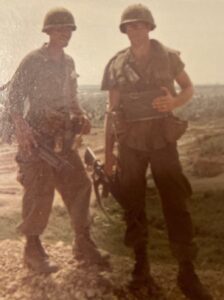 Dave Himmer (right) and Manny Hernandez (left) in the Vietnamese countryside
Dave Himmer (right) and Manny Hernandez (left) in the Vietnamese countrysideWhen Dave’s turn came, he took off running and soon heard a trainer hot on his trail. He managed to get away by low-crawling through ditches and underneath fences. He later had to avoid a large snake on some logs in the swamp he found himself in as he crossed the valley. At about 10:00 p.m., he heard a loudspeaker on a truck calling the soldiers to come out, but he was afraid it was a ruse and would take those that came out to the POW camp, which is what happened. He was glad he did not go because those that went to the POW camp were roughed up, with one soldier suffering a broken arm. At about midnight, a second truck came by calling for the soldiers to come out. Dave figured by now it was safe, so he revealed himself. He guessed right and was taken back to the barracks having successfully completed the AIT infiltration course.
Dave graduated from AIT on June 30, 1968. Because he was a squad leader at AIT just as he had been at Basic Training, he was immediately promoted to Private First Class (E-3). He had about two weeks leave before having to depart for Vietnam, so he returned to Minnesota to visit his wife and family. This visit was very hard because by the time Dave finished his training at Tigerland, he was mentally prepared for combat in Vietnam. Seeing his wife and family made him realize how much he missed them, but he couldn’t stop thinking about what lay in store for him in Vietnam. The emotional roller coaster made it very hard when it came time to leave.
With his wife, parents, and brothers and sisters waving, Dave said goodbye at the Minneapolis/St. Paul airport and flew to San Francisco, California. He took an Army bus from the airport to the Oakland Army Terminal to await a flight to Vietnam. He spent three or four days there pulling “KP” duty, but then finally heard the announcement directing him to report with his gear at 10:00 p.m. to the buses that would take him to Travis Air Force Base for his flight to Vietnam. Once he departed Travis, his plane refueled in Anchorage, Alaska, and Yokota, Japan. In Yokota, the plane’s air conditioning failed and the plane became uncomfortably hot. The pilot reassured the passengers, “Don’t worry about the air conditioning. It’s going to be a lot hotter in Vietnam.”
Dave landed in South Vietnam at Bien Hoa Air Base, about sixteen miles northeast of Saigon, on July 20, 1968. An Army staff sergeant came aboard to brief the new arrivals. He told them they were guests in South Vietnam and went over the rules and regulations they had to obey. He added they needed to do as instructed out in the field so they wouldn’t come back like those they could see out their windows. When Dave looked outside, he saw long lean-to structures with coolers containing the coffins of those killed in action and awaiting flights back to the “world”, which was how soldiers referred to the United States. The sight was a sobering introduction to Vietnam.
The men departed the plane and boarded buses with wire mesh covering the windows to prevent the Viet Cong from hurling grenades inside. Dave and the others, who were still wearing their summer khaki uniforms, couldn’t understand why they hadn’t been issued weapons. They’d learned about Viet Cong ambushes during their training at Tigerland, but now as they drove from Bien Hoa to Long Binh Army Base, located about twenty miles northeast of Saigon, they had no way to defend themselves if their bus was attacked. They were all relieved when they arrived safely within the guarded perimeter of Long Binh.
While at Long Binh, Dave was temporarily assigned to the 90th Replacement Battalion awaiting orders to his follow-on permanent assignment. Each day, he and the other new arrivals mustered at designated times with their personal gear to listen for their names to be called with their new assignments. They continued to ask when they would get their weapons and were told they would be issued once they reached their permanent unit. After a couple of days, Dave heard his name called. He was assigned to the 1st Infantry Division, whose headquarters was in Di An.
Dave and the other replacements assigned to the 1st Infantry Division loaded onto a truck for the twelve-mile ride to the Base Camp at Di An. After checking in with 1st Infantry Division Admin, they were told they could get something to eat before forming up for further instructions. Dave went to the enlisted men’s club, where he got a hamburger and fries. When he sat down to eat, he saw a guy he worked with at Gold Cross Ambulance! When the guy got drafted, Dave and his coworkers laughed at him. Now it was his friend’s turn to laugh.
As Dave walked back to where he was supposed to form up, he saw some soldiers behind a wall. He went to see what they were doing and saw them washing off the bodies of two soldiers killed in action the day before. It was another sobering reminder of the deadly serious business he was now involved in.
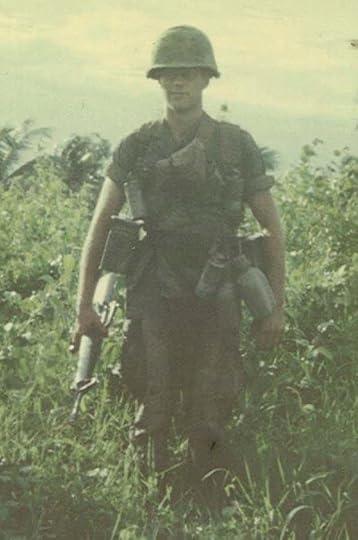 Dave Himmer in the Field in Vietnam
Dave Himmer in the Field in VietnamDave learned the next morning he had been assigned to Alpha Company of the 1st Battalion, 28th Infantry Regiment (the Army’s famed Black Lions), operating out of the Quan Loi Base Camp. The base camp, constructed on a former French rubber plantation, was about four miles east of the town of An Loc and about seventy-two miles north of Saigon. Dave and a few others flew there on a C-7 “Caribou” transport aircraft, arriving around 6:00 p.m. When they arrived, they reported to the company Executive Officer, 1st Lieutenant (1LT) Ed Knoll. He told them to go to supply to get their weapons and equipment, clean their weapons, get some chow, and report back for guard duty on the base camp perimeter.
One of the other new arrivals, Private First Class (PFC) Bob Gruen, spoke up and told 1LT Knoll he was not supposed to be there. 1LT Knoll responded, “None of us are supposed to be here, but Gruen, tell me why you are not supposed to be here.” PFC Gruen said he was an armored personnel carrier (APC) driver and that was why he wasn’t supposed to be there. 1LT Knoll took him outside and walked him to where he could see the burned-out hulk of an APC. He said, “Do you see that? That was an APC. We call them coffins on wheels over here.” PFC Gruen concluded his new assignment was the right one after all.
On that first night, Dave stood guard duty half-way between two bunkers on the perimeter of the base camp. Around 1:30 a.m., he heard someone yell “fire in the hole”, which Dave thought meant there was going to be a controlled detonation somewhere. Suddenly, he heard a huge kaboom overhead. The concussion from the blast was so strong it launched him upwards into his shelter half (half of a tent). Not knowing what was going on, he remained at his post. He learned the next morning his position was just forward of an eight-inch artillery piece, and the explosion he heard was the big gun firing a shell at some distant target. Had he known about the gun’s location before he took his position, it would have saved him some late-night worry.
Before reporting to Alpha Company, Dave had one more hoop to jump through. This was “Jungle Devil School”, where Army instructors told the new arrivals to forget everything they learned in “the world” because they were going to teach them how things were done in Vietnam. Here they learned the tactics of the local Viet Cong units and how to conduct sweeps outside the base camp perimeter. On one of the training sweeps, a sniper shot and killed one of the trainees. The instructor reinforced with everyone the need to be ready for action everywhere, all the time.
After completing Jungle Devil School, Dave joined Alpha Company, which was working out of a night defensive position (NDP) just outside the village of An Loc. He was assigned to Lima platoon and his platoon leader, Staff Sergeant Terry Richardson, asked what he wanted to do. Dave said he’d do whatever the platoon needed him to do, so Sergeant Richardson offered him the option of being an M60 machine gun ammunition carrier. Sergeant Richardson told him if he did that, he wouldn’t have to “pull point”, which meant he would never be the soldier leading the platoon’s way through the jungle in search of the enemy. It also meant he had to hump two heavy cans of M60 ammunition in addition to his other gear when on patrol in the steaming jungle heat. Still, that sounded better than pulling point, so Dave took the position. His squad leader was Norm Meier.
For the rest of July and throughout August, Dave and the rest of Alpha Company conducted road sweeps by day to keep Highway 13 (Thunder Road) clear of the enemy. At night, they set ambushes for the Viet Cong operating in the area. Growing more confident and feeling like Lima platoon was really sticking it to the enemy during firefights and road sweeps, Dave told his platoon leader, “I think I’ll be able to survive a year over here.” Staff Sergeant Richardson told him to wait and see.
The waiting came to an end on September 12, 1968. Alpha Company’s commander, now 1LT Knoll, took a call early in the morning that they would be moving out from An Loc with a tank unit headed for the base camp at Quan Loi. While they resupplied at Quan Loi, some of the company’s veterans took pictures of the men as they prepared to leave, saying the company was going to a bad place and some would not be coming back. Dave and the other “newbies” thought they were just trying to scare them, but they couldn’t tell for sure. They would just have to find out for themselves.
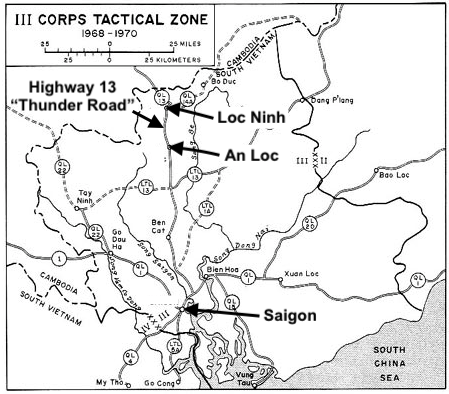 Map showing Loc Ninh, An Loc, and Highway 13 relative to Saigon – Source: U.S. Army
Map showing Loc Ninh, An Loc, and Highway 13 relative to Saigon – Source: U.S. ArmyChinook helicopters ferried Alpha, Charlie, Delta, and the Headquarters Companies of the 1st Battalion, 28th Infantry Regiment, from the base camp at Quan Loi to an airstrip at Loc Ninh. (Bravo Company had remained behind near An Loc to fill the defensive positions vacated by Alpha Company.) From Loc Ninh, the battalion headed northeast on foot to help sweep the area for NVA troops and help the 1st Battalion of the 2nd Infantry Regiment, First Infantry Division, which had already run into some serious trouble.
By the time Dave and Alpha Company got into position about four miles northeast of Loc Ninh early in the afternoon on September 12th, the monsoon rains were pouring down. Together with the other men of Lima platoon, Dave waded through the wet three-foot-tall jungle grass under the rubber trees on Alpha Company’s left flank. As 1LT Knoll pushed Alpha Company forward along the azimuth they have been given, they passed through the first of two checkpoints without incident. After Alpha Company passed through the second checkpoint on the way to the position where they were to remain for the night, they spotted an NVA soldier in a rubber plantation worker’s hut or “hootch”. He stood there looking at Alpha Company, which took him under fire and killed him. 1LT Knoll then sent out reconnaissance patrols from the Company’s right and left flanks. When they returned, they reported no NVA movement, so 1LT Knoll started moving the Company forward. Shortly thereafter, they spotted three more NVA soldiers, apparently trying to pull Alpha Company to the northeast. The Company took them under fire and killed two of them.
At about 2:30 p.m., 1LT Knoll told the Company to get down and then sent squads out on the Company’s flanks to conduct reconnaissance. The squad on the left from Lima Platoon encountered no one, but the eight-man squad on the right from Mike Platoon was ambushed. Everyone was killed or fatally wounded. Realizing they could not now rescue the ambushed squad, 1LT Knoll ordered the Company to move back seventy-five meters to prepare defensive positions and set out claymore mines in the event the NVA tried to overrun them. Dave saw green NVA tracer bullets flying everywhere and the men had to set off their claymore mines to beat back the NVA attacks.
By 4:30 p.m., Alpha Company’s situation had grown worse. 1LT Knoll called for assistance, indicating the Company was surrounded and would not survive the night without help. E Troop of the 11th Armored Cavalry responded by dispatching tanks and APCs to Alpha Company’s position, eleven of which managed to fight their way through. The armored vehicles formed a 360-degree perimeter and the Company withdrew inside their protective cover. Not deterred, the NVA fired rocket propelled grenades (RPGs), mortars, and small arms fire at the position throughout the night. Two APCs and members from Mike Platoon were, however, able recover the bodies of the soldiers killed in the ambushed patrol. The bodies were flown from the area by a Chinook helicopter.
At around 1:30 a.m. on September 13th, a “Dustoff” helicopter arrived to evacuate the wounded and deliver ammunition and supplies. Also onboard was Lieutenant Colonel Leland C. Rew, the commander of the 1st Battalion, 28th Infantry Regiment, who flew in to direct the battalion’s operations as it set its sights on sweeping the enemy from nearby Hill 222 later in the morning.
After E Troop’s armor detached to assist other units, Alpha and Charlie Companies moved out from their respective positions to sweep toward Hill 222. Charlie Company met fierce resistance, so Alpha Company was ordered to cover their withdrawal. As they did, they too came under heavy fire. Flying over the battlefield, the 1st Infantry Division Commander, Major General Keith Ware, a World War II Medal of Honor recipient, directed Alpha Company by radio to engage. Shortly after the transmission, the general’s helicopter was shot down, killing him and everyone else on board. For the remainder of the day, Alpha and Charlie Companies were pinned down. U.S. air strikes pounded the NVA positions on Hill 222.
The ground assault on Hill 222 resumed in the morning on September 14th. Lima platoon had the lead for Alpha Company as they moved forward to take the hill. When Lima platoon’s point man and the rifleman behind him were hit by machine gun fire, Dave said “all hell broke loose”. The platoon and the rest of Alpha Company found themselves pinned down by three NVA machine guns, unable to continue forward or pull back. With both Dave’s and Lima platoon’s other M60 machine gun crew providing suppressing fire, the platoon leader, Staff Sergeant Terry Richardson, crawled forward and pulled his wounded point man, rifleman, and squad leader back to the Alpha Company perimeter. He then grabbed the platoon’s radio and crawled between the three NVA machine gun positions. Following an NVA communication wire, he worked his way to the top of Hill 222, where enemy troops from units in the NVA’s 7th Division manned a complex of camouflaged bunkers defending the Division’s base camp.
Using the radio he’d hauled to the top of the hill, Staff Sergeant Richardson began calling in tactical air strikes on the enemy’s positions. An hour into these calls, an NVA sniper chained to a tree shot him in the right knee. After he stopped the bleeding, he resumed calling in air strikes throughout the rest of the day, forcing the NVA to withdraw. With the enemy finally gone, Dave and the other members of the platoon’s two M60 machine gun crews climbed to the top of Hill 222 to recover Staff Sergeant Richardson. After they found him, Dave ran back down the hill at full speed carrying his ninety pounds of gear. Suddenly, he fell into a well-concealed four-foot-deep trench and his heavy helmet caused his head to snap back, injuring his neck. He was stunned and dazed but had to press on—there would be time to hurt later.
Dave credits God’s grace and the extreme heroism and bravery of Staff Sergeant Richardson with saving the lives of the eighty-five remaining members of Alpha Company pinned down as they proceeded up Hill 222 that day. Alpha and Charlie Companies took full control of the hill on the morning of September 15th. Alpha Company would lose 3 more men before the three-day battle ended, bringing its total losses to 20 of its 102 men, with eight men killed and twelve wounded.
After the battle at Loc Ninh, Dave and his unit returned to Quan Loi. Although no one in the unit ever wanted to go back to Loc Ninh, Alpha Company was ordered to return around September 20th after replacements filled the company’s vacant positions. This time, only a lone sniper in a rubber tree shot at the men. They killed the sniper, while no one from Alpha Company was wounded. The company returned to Quan Loi the same day.
Dave was now a seasoned veteran, routinely participating in search and destroy missions and nighttime ambushes. He was nearly killed in a friendly fire incident near the Song Be River when his M60 machine gun crew covered Alpha Company’s withdrawal and a U.S. AH-1 Cobra attack helicopter fired too close to his position. On another occasion, Dave was on a search and destroy mission when a mortar round landed on top of his platoon, wounding some members and blowing out his eardrums. These were just some of the close calls he endured during his patrols in the field after Loc Ninh.
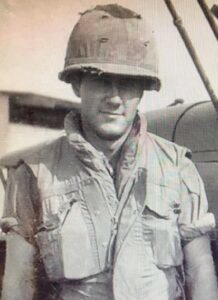 Dave Himmer in Vietnam next to his truck
Dave Himmer in Vietnam next to his truckAround Christmas of 1968, Dave mentioned to his First Sergeant he would like to be considered for a position in the rear if the First Sergeant knew of one. Dave heard nothing about it until the end of January 1969, when his First Sergeant accompanied a portable mess kitchen to Dave’s NDP for the night. While the cooks prepared a warm meal for Dave’s unit, his First Sergeant asked him if he was still looking for a job in the rear. When Dave said yes, the First Sergeant told Dave to return to the Lai Khe Base Camp with him in the morning. Before leaving in the morning, Dave ate breakfast with the M60 machine gunner he carried ammunition for. When Dave arrived at Lai Khe later that morning, he learned the machine gunner had been killed by a land mine outside the NDP. The news hit Dave hard because had he not left for Lai Khe that morning, he knew he would’ve been walking next to the machine gunner when he stepped on the mine.
Dave’s new job was driving a supply truck for the battalion, but the job was anything but safe. Supply trucks traveling in convoys on Thunder Road were routinely ambushed, with the NVA and Viet Cong waiting for the convoy’s escorting tank and military police Jeep to pass before attacking the column of defenseless trucks. After two or three of these runs, Dave asked if he could drive his truck a short distance behind the escorting tank and Jeep, but ahead of the other vehicles in the convoy. Although this meant he would be completely on his own if attacked, he reasoned the enemy would not risk blowing an ambush for a single truck. His logic proved correct, and he drove the supply route along Thunder Road every day, traveling between Lai Khe, Di An, Long Binh, Bien Hoa, Tan Son Nhut, and Thu Duc without incident.
During his time as a truck driver, Dave developed connections at the bases he delivered supplies to and became an expert “scrounger”. On one scrounging mission, he traded camouflaged poncho liners for two pallets of lumber to construct an officer’s club at Lai Khe. On another occasion, he negotiated a deal for a water pump the battalion needed. He continued driving his truck and scrounging until his tour of duty came to an end in July 1969. He still had one more close call, though. Two days before he left, an enemy mortar round hit the “hooch” (tent) next to his. No one was hurt, but it was a sobering reminder of the danger he faced until he finally departed the country. Despite his many close calls, Dave was never wounded. He did, however, contract malaria as a result of his exposure to the disease-carrying parasite in the Vietnamese jungle.
Now a sergeant, Dave left Vietnam on July 20, 1969, one year to the day after he arrived. The route back took him through Clark Air Base in the Philippines, Hawaii, Travis Air Force Base, and finally Oakland. From there he caught a flight to Minnesota, where he walked into his parents’ house on the same day Neil Armstrong walked on the moon. His Army service wasn’t over yet, though, as he still had six months left on his service commitment. He finished his tour at the 4th Combat Support Training Brigade at Fort Ord, California, where he processed orders for soldiers entering and graduating from Cook School. Twice he was offered tempting follow-on positions, first as a drill instructor and second with the Ceremonial Old Guard in Washington, DC, but he turned down both opportunities. He was even offered a promotion to Staff Sergeant if he elected to stay in the Army. He needed to be a civilian, though, at least for a little while, and after being discharged from the Army in February 1970, took a job with IBM in Reno, Nevada.
Although it looked like Dave’s military career was over, in fact, it was just beginning. By coincidence, a salesman Dave worked with at IBM was the commander of a Marine Reserve rifle company. When he asked Dave to sign on, Dave couldn’t refuse. He’d always wanted to be a Marine and this was his chance. Although he had to revert to corporal (E-4) “because the Marines do things differently than the Army”, Dave took the oath in July 1970 and, because of his prior administrative experience at Fort Ord, became the company clerk for India Company, 3rd Battalion, 23rd Marine Regiment, 4th Marine Division. Before he was promoted to sergeant, IBM transferred him to Minneapolis, where there were no Marine Reserve assignments that worked for him. His brief Marine experience ended in September 1972.
Again, it looked like Dave would settle into civilian life, but this time the Army Reserve beckoned him to sign on in November 1973 with the 5501st U.S. Army Reserve Hospital at Fort Snelling, Minnesota. Dave became an operating room technician, relating back to the hospital work he enjoyed so much before he was drafted. As if the Reserve duty and working full-time for IBM weren’t enough, Dave also completed the Emergency Medical Technician (EMT) Course at Inver Grove Community College and worked part-time for the Smith Ambulance Company and the Emergency Room at Methodist Hospital.
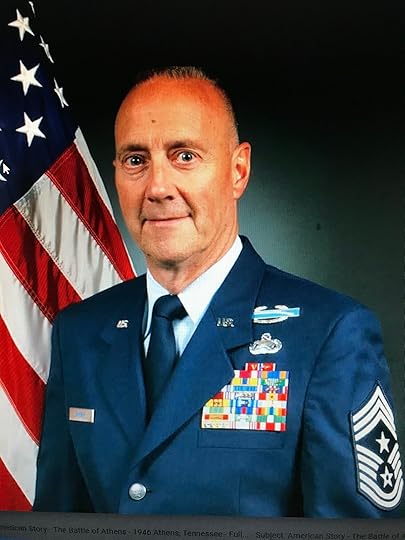 Command Chief Master Sergeant David Himmer
Command Chief Master Sergeant David HimmerDave’s part-time gig with the ambulance company proved providential. The company’s dispatcher served with the Minnesota Air National Guard’s 133rd Airlift Wing Medical Squadron at the Minneapolis/St. Paul International Airport. He recommended Dave switch services again and Dave did. So began Dave’s long affiliation with the Minnesota Air National Guard and the 133rd Airlift Wing. He started out in August 1975 as a medic, then progressed to an optometry technician and a unit training manager, where he handled unit training for the Wing’s medical squadron.
Dave went on to serve as a training manager and acting First Sergeant in the 133rd Airlift Wing’s Mission Support Flight. He subsequently received the Commandant’s Award at the Air Force’s First Sergeant’s Academy and served as the First Sergeant in the Wing’s Support Group, where he was selected as both the Wing and Minnesota Air National Guard First Sergeant of the Year. His responsibilities expanded to human resource advisor, first at the Wing level and later at the state-wide Air National Guard level. While at the Wing, Dave was selected as the Air National Guard Human Resources Advisor of the year. More important, the Air National Guard recognized Dave’s seasoned leadership, promoting him to the highest enlisted rank in the Air Force, Chief Master Sergeant (E-9), in 2001.
Dave served as the 133rd Airlift Wing’s Command Chief Master Sergeant from December 2003 to March 2005. In this last position, and with the Global War on Terrorism in full-swing, Dave was responsible for the 1,134 enlisted men and women assigned to the Wing, while still working full-time for his civilian employer, now CoBank/Farm Credit Leasing in Minneapolis. Oftentimes he worked eighty-hour weeks to make sure both his military and civilian jobs got done. Finally, for fifteen of the years Dave was assigned to various units in the 133rd Airlift Wing, his son, Mark, was also assigned to the Wing as a member of the 133rd Security Forces Squadron.
Dave retired from the Air National Guard when he turned sixty in 2005. He and his wife, Janet, now live in Bloomington, Minnesota, spending time with their five children (Mark and Kelly from Dave’s first marriage and Rick, Jeff, and Chris from Janet’s first marriage), eleven grandchildren, and one great grandchild. He continues to serve our military by volunteering at the Armed Forces Services Center at Minneapolis/St. Paul International Airport. In addition, he serves as an advocate for veterans and their families, helping them navigate through the Veterans Administration system. As always, he is active in his church.
Dave’s military decorations include the Bronze Star with “V” device (with two oak leaf clusters), the Meritorious Service Medal (with four oak leaf clusters), the Army Commendation Medal with “V” device (with one oak leaf cluster), the Combat Infantryman Badge, the Air Medal, the Vietnam Service Ribbon, and the State Active-Duty Ribbon. The “V” device indicates the award was given for valor in combat.
Dave is a Distinguished Member of the Black Lions Regiment, an association of those who honorably served in the Army’s 28th Infantry Regiment. Since November 2000 and in every year but one since then (2020), Dave and other members of Alpha Company have met over the Veterans Day holiday to talk about their shared experience in Vietnam and to honor those who never made it home.
Voices to Veterans is proud to salute Command Chief Master Sergeant Dave Himmer, U.S. Air Force (retired), for his many years of distinguished service to our nation. He answered our country’s call during the Vietnam War, serving in the Army with courage and honor in the face of a determined enemy. He then continued to serve in both the Marines and the Air Force, becoming a senior leader and exemplifying selfless service for the next generation of men and women in our armed forces. We thank him for all he has done and wish him fair winds and following seas.
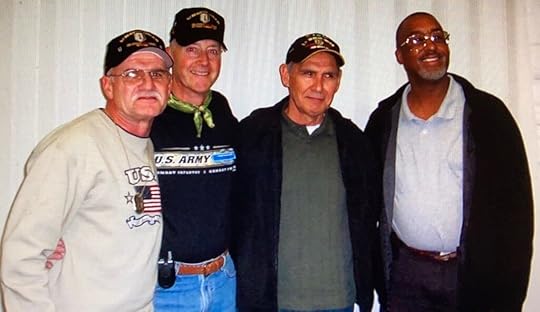 From an Alpha Company reunion over 50 years after the war – Norm Meier (far left), Dave Himmer, Manny Hernandez, and Robert Grier (far right)
From an Alpha Company reunion over 50 years after the war – Norm Meier (far left), Dave Himmer, Manny Hernandez, and Robert Grier (far right)
August 11, 2021
Staff Sergeant Howard A. Berger, U.S. Army – Five Decades of Service
Sometimes when you’ve got your heart set on something, that’s all you can see. Your focus can cause you to miss even better opportunities that might present themselves in unexpected ways. Staff Sergeant Howard Berger had that kind of focus in February of 1946, looking forward to going home from Austria after having served in the U.S. Army in Europe at the end of World War II. He, however, took a chance on a pop-up interview in Vienna and it led to a wonderful career and a lifetime of service to the Army. This is his story.
Howard was born in November 1923 in The Bronx and raised in Brooklyn, New York. His family lived in an apartment in a house purchased by his grandparents after they immigrated from Eastern Europe. Howard’s father, who had served as a machine gunner in World War I, was a successful salesman at a New York clothing store, Maxi’s, while his mother raised Howard and his younger brother at home.
Both Howard and his brother walked to and from their neighborhood schools. One afternoon in May 1937 when Howard was walking home from middle school, he stopped at a playground along the way and climbed onto a swing. As he swung back and forth, he looked up into the sky and saw a giant white blimp flying very slowly overhead. He thought the blimp looked beautiful until he saw the Nazi swastika on its fins. Later in the day, he heard on the news the blimp was the German airship Hindenburg, and that it had exploded with great loss of life as it attempted to dock at Naval Air Station Lakehurst in New Jersey.
After Howard graduated from Eastern District High School in June 1940, he went to work as a messenger in the heart of Times Square on 42nd Street in New York City. Scanning through the want ads one morning, he saw a job that interested him working for the Curtis Publishing Company. He asked his boss if he could apply and his boss not only told him yes, but also said if the job was better than what he had now, he should take it. His boss also promised Howard if the new job didn’t work out, he would always have a messenger job waiting for him when he returned.
The job with Curtis Publishing involved selling subscriptions door-to-door for the company’s most popular magazines, The Saturday Evening Post, Ladies’ Home Journal, and Country Gentleman. Since Howard’s father was a salesman and Howard had sales in his blood, he decided to give it a try. When he first went out, his new boss showed him what he needed to do. Although he was a little nervous, Howard earned $6.00 in the first week. By the fourth week, he was making $24.00. Once he fully learned the ropes, he was earning up to $100.00 each week, making him the primary breadwinner in his family. In addition to the good pay, the job taught Howard how to quickly size up and get along with lots of different kinds of people – “the good, the bad, and the ugly”.
In October 1942, Howard’s sales territory included an area in New Jersey with a number of defense factories, which were going full bore in support of the war effort. Seeing these factories in action convinced Howard he needed to enlist to do his part. His brother wanted to enlist too, so together they went to a local recruiting office in New York to sign up. Howard was eighteen and old enough to enlist, but since his brother was only seventeen, the recruiter would not let his brother enlist without their father’s signature. With that, the brothers left the recruiting office and walked around the corner, where Howard signed his father’s name. The brothers then returned to the office and both were permitted to enlist – Howard in the Army and his brother in the Coast Guard. Howard is sure the recruiter knew what they had done, but he also figured the recruiter didn’t care. As long as the recruiter could point to a signature Howard and his brother said was their father’s, that was all the recruiter needed.
Although the recruiter wasn’t upset with what Howard had done, Howard’s father was. When the brothers got home and told their parents they had enlisted, Howard’s father was furious—not so much because the boys had enlisted, but because Howard had signed his name. He did not, however, attempt to invalidate the agreement and he let both boys serve. Howard’s brother went on to serve successfully in the Coast Guard, sailing on ships protecting Lend-Lease convoys in the North Atlantic and becoming a police officer in New York City after the war.
Howard’s military service began when he reported for active duty on November 13, 1942, one day after his nineteenth birthday. He was initially mobilized at Fort Hamilton in Brooklyn, but shortly thereafter was sent to Fort Dix, New Jersey, for in-processing. After a few weeks at Fort Dix, Howard was sent to basic training at Camp Stewart, Georgia, just outside of Savannah.
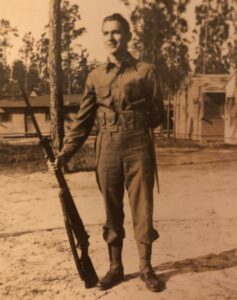 Howard Berger at Camp Stewart
Howard Berger at Camp StewartWhat stands out most for Howard about basic training was getting shots and working in the mess hall on “Kitchen Police” duty, better known as “KP”. He remembers being roused out of bed at 4:30 a.m., getting up to three shots at a time by 5:30 a.m., and then being sent back to work in the kitchen scrubbing pots and pans and preparing meals. The trainees thought the mess sergeant particularly mean because he would give no one a break, no matter how sore their arms might be after the shots.
After basic training, Howard continued training at Camp Stewart at the Army Antiaircraft Artillery Center. Initially assigned to the 490th Antiaircraft Artillery – Automatic Weapons (AAA) Battalion, and then the 454th AAA Battalion, Howard trained in halftracks with four 50-caliber machine guns in a quad mount in the bay at the rear of the vehicle. The unit also had a 40-millimeter Bofors antiaircraft gun, which had to be towed behind a truck. When it came time for the unit to deploy to Europe, a cadre of soldiers that included Howard stayed behind to train the next unit. Howard was then assigned to Battery “D” of the 580th AAA Battalion. He trained with the unit on maneuvers in Louisiana in 1944 and then returned to Camp Stewart to prepare to deploy to the European Theater for action against the Nazis.
In December 1944, Howard’s unit traveled to New York for the trip to Scotland. Howard, now a staff sergeant leading a platoon comprised of twenty-one soldiers and four halftracks, boarded the Queen Elizabeth (a luxury ocean liner converted to a troop ship for the war) along with the other members of his platoon and 15,000 other soldiers. The ship soon set sail into the heavy seas of the wintry North Atlantic. The seas were so rough, the ship turned south to Bermuda before heading west toward Europe, all the time zigzagging to avoid attacks by German U-boats. Although Howard didn’t get seasick, many others did, making it a wretched voyage for all onboard. When the ship finally arrived in Greenock, Scotland, just a few days before Christmas, sunny weather and a beautiful day brought an end to their European cruise.
After getting off the ship in Greenock, Howard and his men boarded a train and were taken to a small farm town, where they unloaded their gear and set up their sleeping arrangements in an area known as Camp Codford. While they were working, a giant explosion came out of nowhere and shook the ground. A German V-2 rocket with a 2,200 pound warhead had hit in their vicinity, and although no one in the unit was hurt, it “scared the hell” out of all of them. They didn’t stay at Camp Codford long, as their next assignment was to assist with the coastal defenses in the resort town of Bornemouth, located on the south coast of England. From there, they reported to a park in Southampton, where they stood guard at a British camp for Italian prisoners of war (POWs). The duty was easy because the Italian soldiers were happy to be POWs and did not want to escape. In the camp, they were treated well and had good food. Howard’s POW camp duty ended in March of 1945, when Howard’s unit loaded on a ship together with their halftracks and crossed the English Channel, landing in France.
Once in France, Howard and his platoon climbed into their halftracks and drove across northern France and Belgium and on into Germany. As the Allied armies had already cleared this area, they were not involved in any fighting, but as an antiaircraft unit, they were always on alert for enemy aircraft and the possibility of German paratroopers trying to get behind Allied lines. When Howard’s unit crossed into Germany near the city of Aachen, Howard saw for the first time the casualties of war. Dead German soldiers lay strewn around on the ground, frozen by the bitter winter cold in macabre poses reflecting their last moments of life. Although Howard can still see the images of the lifeless men today, he didn’t have time to dwell on it then as his unit continued driving further into Germany towards the retreating enemy.
Howard reached the Rhine River near the town of Remagen, where weeks before, the U.S. Army’s 9th Armored Division captured the Ludendorff Bridge intact, allowing tens of thousands of Allied troops and their equipment to cross in hot pursuit of the German army. The bridge at Remagen helped bring the war to a speedy conclusion. By the time Howard arrived, the bridge had collapsed, but Army engineers had constructed pontoon bridges over the river, allowing Howard’s halftracks to cross.
After a day of progress on the other side of the Rhine, Howard pitched his tent for the evening. The camps were always in blackout conditions at night to protect from enemy attack, but a lone jeep usually managed to navigate to the camp to bring the unit its mail. That was when Howard learned his best friend from school, Harold Marin, had been killed in Belgium. Harold was a promising young boxer, but now he was gone. Howard was so angry he took his rifle and set out looking for German soldiers to exact revenge. Looking back, he is glad he didn’t find any, and even more glad no German soldiers found him.
On May 5, two days before Germany surrendered, Howard’s unit repositioned to a farm and Howard’s platoon occupied an empty farmhouse. The farmhouse offered a unique opportunity – a hot bath instead of having to wash with water poured into a helmet. To get the “bath” ready, water had to be heated on a stove in the kitchen and then poured into a large tub for reasonable bathing. As Howard readied for his bath, he got undressed and took a c-ration can filled with gasoline and tossed the gasoline into the stove to get the fire going. When the gasoline hit inside the hot stove, it blew up and spewed flaming liquid on Howard’s hands and his left leg. Howard ran outside to a nearby air raid shelter and put out the flames by covering them with sand. Still, he was badly burned and had to be immediately medevac’d. A medic had him placed on a gurney and loaded onto a ¾-ton truck for the drive to the closest tent hospital, with some of the men from his platoon going along to cheer him up and make sure he was taken care of.
At the tent hospital, he was triaged along with other injured soldiers. When it was Howard’s turn, a doctor and two nurses attended to him. They told him they were going to put him to sleep to treat him, but Howard refused because he was afraid they were going to amputate his leg, which by now was completely black. The doctor said okay and then instructed the nurses to clean all of the sand from Howard’s burns, which was very painful. They then bandaged his wounds and moved his gurney to a recovery area, where he lay on a stretcher on the ground with other recovering soldiers. He tried to get some sleep, but every three hours he had to get a shot and take medication, making for quite a long night.
The next day, Howard and other injured soldiers were flown to Paris in a B-25 medium bomber converted into an air ambulance. Howard’s gurney had a tag on it that said “UK”, meaning he was to continue on to England to recover. However, as he waited in the Orly Airport terminal for the next flight, an announcement came over the PA system saying all burn patients would now be treated in Paris. As a result, Howard was transported by ambulance to L’Hopital Beaujon in Clichy, Paris. Once there, the doctors told Howard he would be as good as new in thirty days, as long as he did exactly as they said. That was all Howard needed to hear and he followed their instructions to the letter.
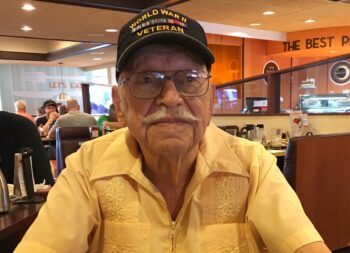 Howard Berger
Howard BergerAs the doctor promised, Howard was released from treatment in thirty days, but he remained at the hospital for observation to make sure there were no follow-on issues or infections. He was, however, allowed to tour Paris during the day, an opportunity he took full advantage of. With the war over and everyone celebrating, it was a good time to enjoy the city. At the end of the thirty-day observation period, he was sent to Nuremburg, Germany, and told to wait for the 580th AAA Battalion to send someone to pick him up. While he waited, he was able to attend a USO show on the 4th of July at Soldiers Field starring Jack Benny, Ingrid Bergman, Larry Adler, and many other stars of the day. After the show, he boldly went backstage and introduced himself to the stars. He has a ten mark note signed by Jack Benny, Ingrid Bergman, and Larry Adler to show for it.
Although the Allies celebrated VE Day (Victory in Europe Day) on May 8, 1945, the war with Japan still raged on. In recognition of that reality, the 580th AAA Battalion received orders to relocate to Austria to begin training in anticipation of being transferred to the Pacific theater for action against Japan. Howard rejoined the battalion as it made its way to Austria. On the way, the unit stopped for approximately one week in the town of Berchtesgaden in the Bavarian Alps. This was the site of Adolf Hitler’s Alpine retreat, known as the Eagle’s Nest.
The unit eventually stopped moving once it arrived at Wallersee Lake, a picturesque resort area near the Austrian city of Salzburg. Given the war with Germany had just ended, no tourists were using the resort, so Howard’s unit took over an empty resort hotel and made it their headquarters. They also were able to relax a little, getting time off from duty on weekends beginning at 8:00 a.m. on Saturday morning. However, due to an order the men attributed to General George Patton, they had to continue wearing their steel helmets on Saturdays until 12:00 in the afternoon. Then they could take them off for the rest of the weekend. Rigid requirements like this made General Patton unpopular with Howard and his men, although they respected him as a great tactical commander.
The preparations for sending the 580th AAA Battalion to the Pacific ended after President Harry Truman authorized the use of two atomic bombs against Japan and the Japanese Government formally surrendered on September 2, 1945. The unit wintered in Salzburg, Austria, with soldiers singularly focused on returning home to the United States as soon as they accumulated enough points to allow their departure. Soldiers earned one point for each month they had in the Army, one point for each month they spent overseas, five points for each campaign they were involved in, five points for a medal of merit or valor, five points for a Purple Heart, and twelve points for each of up to three dependent children.
Howard’s turn to go home finally arrived in February 1946. After shipping most of his belongings back to New York City and attending a farewell party the night before he was to leave, he prepared to depart on a morning train to Bremerhaven, where he would board a ship for the return voyage to the United States. As he was getting ready on the day he was to depart for the train station to begin his journey home, his captain called him to his office at 8:00 a.m. Howard assumed the captain was going to say goodbye again and wish him good luck. Instead, the captain informed him a TWX (an electronically sent typewritten message) had just come in saying the High Commissioner in Austria had finally reviewed an application Howard had submitted months ago to stay behind and work as part of the occupation forces in Austria. The TWX added Howard should report to Vienna for an interview as soon as possible.
The captain gave Howard a way out. He said Howard could get on the train to Bremerhaven and the captain would reply Howard was already on his way home. Howard thought for a moment. He was a twenty-two-year-old young man from Brooklyn—he would never have the opportunity to visit Europe again because it was too expensive to get there. He told the captain he’d go to the interview. Expecting not to be hired, he’d at least get to visit Vienna, the world-renowned capital of Austria, and would simply be delaying his return home by no more than a week or two.
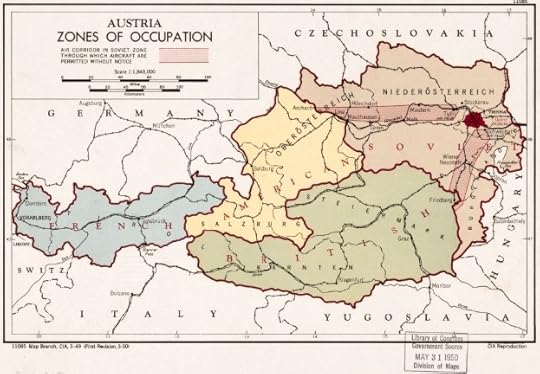 Map of Austria Occupation Zones Source: Library of Congress
Map of Austria Occupation Zones Source: Library of CongressA week later, Howard boarded a train known as the “Mozart” in Salzburg, headed for Vienna. At the time, Austria was divided into four zones, with each zone being administered by one of the occupying powers: the United States, Great Britain, France, and the Soviet Union. Vienna was surrounded by the Soviet zone, so when the train arrived at the border between the U.S. zone and the Soviet Zone, the train stopped and Soviet troops boarded to conduct a cursory inspection. The train then continued until it arrived in Vienna, which also had been divided into four zones, with the historical center of Vienna designated as a fifth central zone administered on a monthly rotating basis by one of the four occupying powers.
When Howard arrived at the train station in Vienna, he was met by military police, who escorted him to his quarters for the night. He was assigned to a two-person room on the first floor of an eight-story building. As both cots were empty when he arrived, he stowed his gear, cleaned-up, and then headed to the PX (post exchange) to buy some supplies before going to his interview the following morning.
At the PX, there were a lot of young Austrian women waiting nearby and hoping to meet an American GI. Knowing that, Howard bought some extra candy and cigarettes. As he came out of the PX, a pretty young Austrian woman asked him if he would like a tour of Vienna. He said he would, but first they needed to go back to his billets so he could drop off his purchases. When they returned to the building, the young woman waited outside because visitors were not permitted inside.
When Howard returned to his room and opened the door, a monkey jumped out towards him! Stunned, Howard carefully worked his way into the room to stow his purchases, but it took him extra time because he had to secure everything from the monkey. He then went to the front desk and complained, learning that a soldier who had served in Africa had arrived and brought his pet monkey with him. Howard said he wanted the monkey out, which happened later in the day. When Howard finally returned for his tour of Vienna, the pretty young woman was gone, apparently thinking Howard would not return. Howard cursed the monkey and its owner.
The next morning, someone from the High Commissioner’s Office (General Mark Clark was the U.S. High Commissioner for Austria) escorted Howard to the Civilian Personnel Office at the U.S. Army headquarters building on Alser Strasse. There he learned the position he was being interviewed for was Assistant to the Class VI Officer, which meant he would help account for alcohol sales to Army officer and enlisted clubs and U.S. embassies throughout eastern Europe. He spoke initially with a man named Vincent Mahler, who had him fill out some papers and then instructed him to go to another building a few blocks away for his interviews. He interviewed initially with a captain and then a major. When he told them he’d never worked in accounting before, they asked him if he knew what two plus two was. When he said four, they told him that was all he needed to know. Then they took him to meet the colonel, a huge man who had played center for the Army football team at West Point. The colonel asked Howard a few questions and then told the captain and the major to sign Howard up.
On the way back to the Civilian Personnel Office, Howard found a U.S. Army library soldiers could use. He went in, found a book on accounting, and did a little brushing up on his high school accounting. He then went back and finished up with Vincent before returning to Salzburg to retrieve the few personal belongings he hadn’t already shipped to the States. Ten days later, he returned to Vienna where he received his Honorable Discharge from the Army and took his new oath as a civilian employee of USFA (United States Forces, Austria). So began Howard’s amazing fifty-year career working as a civilian for the U.S. Army in Europe.
Although Howard began as the Assistant to the Class VI Officer, that didn’t last long because after a month or two, the captain who was the Class VI Officer earned enough points to return to the States, making Howard the Class VI Officer. Two months later, the major in charge of budgeting also became eligible to return to the States. Howard’s boss gave him just three weeks to learn the job of the Budget Officer for Army Special Services, which, inter alia, included the entertainment branch. Eventually, Howard took on additional responsibilities on the entertainment side of Special Services, starting with publishing posters about upcoming events and then moving into event planning and execution. Howard loved his work because his entire focus was helping U.S. soldiers and their families enjoy life in Austria.
Howard’s entertainment branch responsibilities in Austria, and later in Italy at Livorno/Pisa (where a U.S. Army missile command and Airborne Team were established), followed by Verona and Vicenza, allowed him to host and interact with lots of famous entertainers who came to Europe to perform for the troops. Some of the people and shows he worked with included Bob Hope, Orson Wells, Cab Calloway, Joseph Cotton, Minnie Pearl, Red Foley, Little Jimmy Dickens, Eli Wallach, Jack Palance, Primo Canera, and Olivia de Havilland. Just as important, he worked to educate the Austrian people about American culture. For years they had been told by the Nazis that Americans were crude and unsophisticated, so Howard worked with the USO to introduce them to American music and musical theater. The first musical they brought over was Kiss Me Kate, followed by the American opera Porgy and Bess, which starred classically trained African American singers, including Cab Calloway as Sportin’ Life. The audiences loved the shows and the opportunity to see and meet the American stars, helping reverse the harmful effects of years of Nazi propaganda, especially against African Americans.
Although Howard had too many interactions with celebrities to count, three warrant special mention. After years of intense negotiations, the Four Powers governing Austria agreed to leave the country and return control to an Austrian government. The event would be marked by a lavish ceremony and parade in the heart of Vienna, featuring military bands and troops from the United States, the Soviet Union, Great Britain, and France. Orson Wells, who had previously filmed The Third Man in Vienna, asked to attend the ceremony. Howard was selected as his escort, so he attended the ceremony as a VIP with Orson Wells and a translator. Howard still has the thank-you letter he received from Orson Wells.
The second event occurred in Italy when Olivia de Havilland, a famous actress who received an Oscar nomination for her role as Melanie Hamilton in Gone with the Wind, came through to visit the troops stationed there. Howard hosted her in Verona and, because she’d played Juliet in Shakespeare’s Romeo and Juliet on Broadway, arranged for her to visit Juliet’s balcony in Verona. When she went out on the balcony, Howard presented her with roses. Olivia de Havilland loved the event and autographed a photo of her for Howard in return.
The third event involved Cab Calloway, one of Howard’s favorite musicians. He’d loved Cab Calloway’s music since the 1930s and the days of Cab’s hit song Hi-De-Ho. In fact, when he was sixteen, he’d taken a long train ride by himself to watch two of Cab Calloway’s live shows. When Cab visited Vienna to star in Porgy and Bess, Howard asked him after one of the shows if he would be interested in visiting soldiers and patients and their families at the Army hospital. Cab said he would, and the troops loved him. Afterwards, Howard asked Cab if there was anything he could do for him and Cab asked if he could get him a reflex camera, which was extremely hard to find. Howard told him he would check and went to the PX manager and said he needed a reflex camera for Cab Calloway. The PX manager said he didn’t have one, but instructed Howard to come back the next day. When Howard returned, the manager produced a reflex camera, which Howard delivered to Cab and Cab reimbursed him for. Years later, after Cab Calloway had passed, Cab’s daughter, Chris, brought a touring version of her late father’s band to Naples, Florida, where Howard was living in retirement. After the show, Howard found Chris and told her the story about her father and the reflex camera. After hearing the story, Chris signed a program for Howard: “In memory of Cabell Calloway, My Dad.” Howard was extremely happy to learn the source of Cab’s nickname. Originally, he thought Cab must have started out his career as a part-time cabbie and a part-time musician.
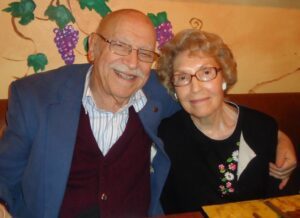 Howard and Dorothy Berger
Howard and Dorothy BergerHoward met one additional star while he was in Austria – a young woman named Dorothy who, after serving in the Marine Corps, had been accepted into the U.S. Foreign Service and assigned to the U.S. Embassy in Vienna. They were happily married for 68 years and traveled all over Europe together before Howard retired in 1994 from SETAF (the Southern European Task Force) in Vicenza, Italy. They finally settled into retirement, wintering in Naples, Florida, with good friends they met in Europe, and spending the summers in the Denver area where Dorothy’s family lived. Sadly, Dorothy passed away in 2019 and is interred at the Fort Logan National Cemetery. Howard was very proud of the beautiful U.S. Marine Corps ceremony held in Dorothy’s honor, which was attended by many friends and family members.
Howard’s military and government civilian awards include the European African Mediterranean War Medal, the American Theater Ribbon, the World War II Victory Medal for participation in the Rhineland Campaign and Central Europe Campaign, the Department of the Army Civilian Meritorious Service Award, and the first U.S. Army Adjutant General White Plume Award in the European Theater. Howard received the White Plume Award for his dedication to the morale and welfare of the soldiers and their families in Austria and Italy, and that of the “atomic” artillery troops stationed in remote areas of Greece and Turkey during the Cold War (including in Erzurum, Turkey, reportedly the closest U.S. military base to Russia at the time).
Howard’s retirement from the Army was not the end of his community service, it was just the beginning. Since turning 90, he’s created the concept of the “Over 90 Charitable Gift Annuity Plan”, allowing charities to pay significantly higher rates of return on charitable gift annuities. Howard describes the Over 90 Annuities as a “Win-Win-Wow”, because the donor wins by getting a higher rate of return on their annuity for the rest of his or her life, the charity wins because they get a donation they likely would not have received otherwise, and the annuity manager wins because they were successful in getting the plan implemented. At 97 years young, Howard continues to help numerous charities implement the “Over 90 Charitable Gift Annuity Gift Plan.”
Given the many adventures Howard experienced with the Army over his long career, Howard recommends young people today consider service in the military. He notes not only is it a patriotic thing to do, but it also provides an opportunity to see the world, meet new people, earn good pay, and take advantage of free educational opportunities for undergraduate and graduate degrees.
Voices to Veterans is proud to salute Staff Sergeant Howard Berger for his long and distinguished career with the Army, first as a soldier and then as a civilian employee of Army Special Services. For over fifty years, his service as a civilian helped bring smiles to the faces of tens of thousands of soldiers and their families. He dedicated his entire adult life to our country, and for that we are eternally grateful. We wish him fair winds and following seas.
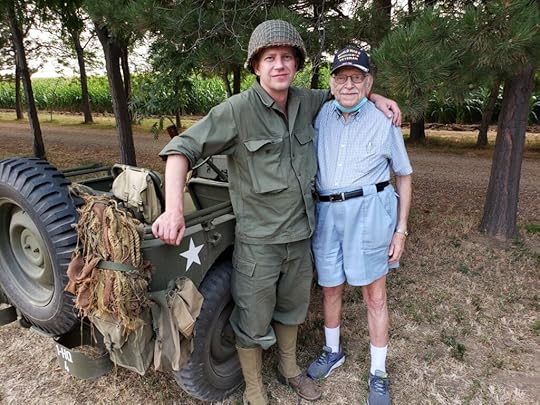 Howard Berger with a WWII reenactor and Jeep
Howard Berger with a WWII reenactor and Jeep
Staff Sergeant A. Howard Berger, U.S. Army – Five Decades of Service
Sometimes when you’ve got your heart set on something, that’s all you can see. Your focus can cause you to miss even better opportunities that might present themselves in unexpected ways. Staff Sergeant Howard Berger had that kind of focus in February of 1946, looking forward to going home from Austria after having served in the U.S. Army in Europe at the end of World War II. He, however, took a chance on a pop-up interview in Vienna and it led to a wonderful career and a lifetime of service to the Army. This is his story.
Howard was born in November 1923 in The Bronx and raised in Brooklyn, New York. His family lived in an apartment in a house purchased by his grandparents after they immigrated from Eastern Europe. Howard’s father, who had served as a machine gunner in World War I, was a successful salesman at a New York clothing store, Maxi’s, while his mother raised Howard and his younger brother at home.
Both Howard and his brother walked to and from their neighborhood schools. One afternoon in May 1937 when Howard was walking home from middle school, he stopped at a playground along the way and climbed onto a swing. As he swung back and forth, he looked up into the sky and saw a giant white blimp flying very slowly overhead. He thought the blimp looked beautiful until he saw the Nazi swastika on its fins. Later in the day, he heard on the news the blimp was the German airship Hindenburg, and that it had exploded with great loss of life as it attempted to dock at Naval Air Station Lakehurst in New Jersey.
After Howard graduated from Eastern District High School in June 1940, he went to work as a messenger in the heart of Times Square on 42nd Street in New York City. Scanning through the want ads one morning, he saw a job that interested him working for the Curtis Publishing Company. He asked his boss if he could apply and his boss not only told him yes, but also said if the job was better than what he had now, he should take it. His boss also promised Howard if the new job didn’t work out, he would always have a messenger job waiting for him when he returned.
The job with Curtis Publishing involved selling subscriptions door-to-door for the company’s most popular magazines, The Saturday Evening Post, Ladies’ Home Journal, and Country Gentleman. Since Howard’s father was a salesman and Howard had sales in his blood, he decided to give it a try. When he first went out, his new boss showed him what he needed to do. Although he was a little nervous, Howard earned $6.00 in the first week. By the fourth week, he was making $24.00. Once he fully learned the ropes, he was earning up to $100.00 each week, making him the primary breadwinner in his family. In addition to the good pay, the job taught Howard how to quickly size up and get along with lots of different kinds of people – “the good, the bad, and the ugly”.
In October 1942, Howard’s sales territory included an area in New Jersey with a number of defense factories, which were going full bore in support of the war effort. Seeing these factories in action convinced Howard he needed to enlist to do his part. His brother wanted to enlist too, so together they went to a local recruiting office in New York to sign up. Howard was eighteen and old enough to enlist, but since his brother was only seventeen, the recruiter would not let his brother enlist without their father’s signature. With that, the brothers left the recruiting office and walked around the corner, where Howard signed his father’s name. The brothers then returned to the office and both were permitted to enlist – Howard in the Army and his brother in the Coast Guard. Howard is sure the recruiter knew what they had done, but he also figured the recruiter didn’t care. As long as the recruiter could point to a signature Howard and his brother said was their father’s, that was all the recruiter needed.
Although the recruiter wasn’t upset with what Howard had done, Howard’s father was. When the brothers got home and told their parents they had enlisted, Howard’s father was furious—not so much because the boys had enlisted, but because Howard had signed his name. He did not, however, attempt to invalidate the agreement and he let both boys serve. Howard’s brother went on to serve successfully in the Coast Guard, sailing on ships protecting Lend-Lease convoys in the North Atlantic and becoming a police officer in New York City after the war.
Howard’s military service began when he reported for active duty on November 13, 1942, one day after his nineteenth birthday. He was initially mobilized at Fort Hamilton in Brooklyn, but shortly thereafter was sent to Fort Dix, New Jersey, for in-processing. After a few weeks at Fort Dix, Howard was sent to basic training at Camp Stewart, Georgia, just outside of Savannah.
 Howard Berger at Camp Stewart
Howard Berger at Camp StewartWhat stands out most for Howard about basic training was getting shots and working in the mess hall on “Kitchen Police” duty, better known as “KP”. He remembers being roused out of bed at 4:30 a.m., getting up to three shots at a time by 5:30 a.m., and then being sent back to work in the kitchen scrubbing pots and pans and preparing meals. The trainees thought the mess sergeant particularly mean, because he would give no one a break, no matter how sore their arms might be after the shots.
After basic training, Howard continued training at Camp Stewart at the Army Antiaircraft Artillery Center. Initially assigned to the 490th Antiaircraft Artillery – Automatic Weapons (AAA) Battalion, and then the 454th AAA Battalion, Howard trained in halftracks with four 50-caliber machine guns in a quad mount in the bay at the rear of the vehicle. The unit also had a 40-millimeter Bofors antiaircraft gun, which had to be towed behind a truck. When it came time for the unit to deploy to Europe, a cadre of soldiers that included Howard stayed behind to train the next unit. Howard was then assigned to Battery “D” of the 580th AAA Battalion. He trained with the unit on maneuvers in Louisiana in 1944 and then returned to Camp Stewart to prepare to deploy to the European Theater for action against the Nazis.
In December 1944, Howard’s unit traveled to New York for the trip to Scotland. Howard, now a staff sergeant leading a platoon comprised of twenty-one soldiers and four halftracks, boarded the Queen Elizabeth (a luxury ocean liner converted to a troop ship for the war) along with the other members of his platoon and 15,000 other soldiers. The ship soon set sail into the heavy seas of the wintry North Atlantic. The seas were so rough, the ship turned south to Bermuda before heading west toward Europe, all the time zigzagging to avoid attacks by German U-boats. Although Howard didn’t get seasick, many others did, making it a wretched voyage for all onboard. When the ship finally arrived in Greenock, Scotland, just a few days before Christmas, sunny weather and a beautiful day brought an end to their European cruise.
After getting off the ship in Greenock, Howard and his men boarded a train and were taken to a small farm town, where they unloaded their gear and set up their sleeping arrangements in an area known as Camp Codford. While they were working, a giant explosion came out of nowhere and shook the ground. A German V-2 rocket with a 2,200 pound warhead had hit in their vicinity, and although no one in the unit was hurt, it “scared the hell” out of all of them. They didn’t stay at Camp Codford long, as their next assignment was to assist with the coastal defenses in the resort town of Bornemouth, located on the south coast of England. From there, they reported to a park in Southampton, where they stood guard at a British camp for Italian prisoners of war (POWs). The duty was easy because the Italian soldiers were happy to be POWs and did not want to escape. In the camp, they were treated well and had good food. Howard’s POW camp duty ended in March of 1945, when Howard’s unit loaded on a ship together with their halftracks and crossed the English Channel, landing in France.
Once in France, Howard and his platoon climbed into their halftracks and drove across northern France and Belgium and on into Germany. As the Allied armies had already cleared this area, they were not involved in any fighting, but as an antiaircraft unit, they were always on alert for enemy aircraft and the possibility of German paratroopers trying to get behind Allied lines. When Howard’s unit crossed into Germany near the city of Aachen, Howard saw for the first time the casualties of war. Dead German soldiers lay strewn around on the ground, frozen by the bitter winter cold in macabre poses reflecting their last moments of life. Although Howard can still see the images of the lifeless men today, he didn’t have time to dwell on it then as his unit continued driving further into Germany towards the retreating enemy.
Howard reached the Rhine River near the town of Remagen, where weeks before, the U.S. Army’s 9th Armored Division captured the Ludendorff Bridge intact, allowing tens of thousands of Allied troops and their equipment to cross in hot pursuit of the German army. The bridge at Remagen helped bring the war to a speedy conclusion. By the time Howard arrived, the bridge had collapsed, but Army engineers had constructed pontoon bridges over the river, allowing Howard’s halftracks to cross.
After a day of progress on the other side of the Rhine, Howard pitched his tent for the evening. The camps were always in blackout conditions at night to protect from enemy attack, but a lone jeep usually managed to navigate to the camp to bring the unit its mail. That was when Howard learned his best friend from school, Harold Marin, had been killed in Belgium. Harold was a promising young boxer, but now he was gone. Howard was so angry he took his rifle and set out looking for German soldiers to exact revenge. Looking back, he is glad he didn’t find any, and even more glad no German soldiers found him.
On May 5, two days before Germany surrendered, Howard’s unit repositioned to a farm and Howard’s platoon occupied an empty farmhouse. The farmhouse offered a unique opportunity – a hot bath instead of having to wash with water poured into a helmet. To get the “bath” ready, water had to be heated on a stove in the kitchen and then poured into a large tub for reasonable bathing. As Howard readied for his bath, he got undressed and took a c-ration can filled with gasoline and tossed the gasoline into the stove to get the fire going. When the gasoline hit inside the hot stove, it blew up and spewed flaming liquid on Howard’s hands and his left leg. Howard ran outside to a nearby air raid shelter and put out the flames by covering them with sand. Still, he was badly burned and had to be immediately medevac’d. A medic had him placed on a gurney and loaded onto a ¾-ton truck for the drive to the closest tent hospital, with some of the men from his platoon going along to cheer him up and make sure he was taken care of.
At the tent hospital, he was triaged along with other injured soldiers. When it was Howard’s turn, a doctor and two nurses attended to him. They told him they were going to put him to sleep to treat him, but Howard refused because he was afraid they were going to amputate his leg, which by now was completely black. The doctor said okay and then instructed the nurses to clean all of the sand from Howard’s burns, which was very painful. They then bandaged his wounds and moved his gurney to a recovery area, where he lay on a stretcher on the ground with other recovering soldiers. He tried to get some sleep, but every three hours he had to get a shot and take medication, making for quite a long night.
The next day, Howard and other injured soldiers were flown to Paris in a B-25 medium bomber converted into an air ambulance. Howard’s gurney had a tag on it that said “UK”, meaning he was to continue on to England to recover. However, as he waited in the Orly Airport terminal for the next flight, an announcement came over the PA system saying all burn patients would now be treated in Paris. As a result, Howard was transported by ambulance to L’Hopital Beaujon in Clichy, Paris. Once there, the doctors told Howard he would be as good as new in thirty days, as long as he did exactly as they said. That was all Howard needed to hear and he followed their instructions to the letter.
 Howard Berger
Howard BergerAs the doctor promised, Howard was released from treatment in thirty days, but he remained at the hospital for observation to make sure there were no follow-on issues or infections. He was, however, allowed to tour Paris during the day, an opportunity he took full advantage of. With the war over and everyone celebrating, it was a good time to enjoy the city. At the end of the thirty-day observation period, he was sent to Nuremburg, Germany, and told to wait for the 580th AAA Battalion to send someone to pick him up. While he waited, he was able to attend a USO show on the 4th of July at Soldiers Field starring Jack Benny, Ingrid Bergman, Larry Adler, and many other stars of the day. After the show, he boldly went backstage and introduced himself to the stars. He has a ten mark note signed by Jack Benny, Ingrid Bergman, and Larry Adler to show for it.
Although the Allies celebrated VE Day (Victory in Europe Day) on May 8, 1945, the war with Japan still raged on. In recognition of that reality, the 580th AAA Battalion received orders to relocate to Austria to begin training in anticipation of being transferred to the Pacific theater for action against Japan. Howard rejoined the battalion as it made its way to Austria. On the way, the unit stopped for approximately one week in the town of Berchtesgaden in the Bavarian Alps. This was the site of Adolf Hitler’s Alpine retreat, known as the Eagle’s Nest.
The unit eventually stopped moving once it arrived at Wallersee Lake, a picturesque resort area near the Austrian city of Salzburg. Given the war with Germany had just ended, no tourists were using the resort, so Howard’s unit took over an empty resort hotel and made it their headquarters. They also were able to relax a little, getting time off from duty on weekends beginning at 8:00 a.m. on Saturday morning. However, due to an order the men attributed to General George Patton, they had to continue wearing their steel helmets on Saturdays until 12:00 in the afternoon. Then they could take them off for the rest of the weekend. Rigid requirements like this made General Patton unpopular with Howard and his men, although they respected him as a great tactical commander.
The preparations for sending the 580th AAA Battalion to the Pacific ended after President Harry Truman authorized the use of two atomic bombs against Japan and the Japanese Government formally surrendered on September 2, 1945. The unit wintered in Salzburg, Austria, with soldiers singularly focused on returning home to the United States as soon as they accumulated enough points to allow their departure. Soldiers earned one point for each month they had in the Army, one point for each month they spent overseas, five points for each campaign they were involved in, five points for a medal of merit or valor, five points for a Purple Heart, and twelve points for each of up to three dependent children.
Howard’s turn to go home finally arrived in February 1946. After shipping most of his belongings back to New York City and attending a farewell party the night before he was to leave, he prepared to depart on a morning train to Bremerhaven, where he would board a ship for the return voyage to the United States. As he was getting ready on the day he was to depart for the train station to begin his journey home, his captain called him to his office at 8:00 a.m. Howard assumed the captain was going to say goodbye again and wish him good luck. Instead, the captain informed him a TWX (an electronically sent typewritten message) had just come in saying the High Commissioner in Austria had finally reviewed an application Howard had submitted months ago to stay behind and work as part of the occupation forces in Austria. The TWX added Howard should report to Vienna for an interview as soon as possible.
The captain gave Howard a way out. He said Howard could get on the train to Bremerhaven and the captain would reply Howard was already on his way home. Howard thought for a moment. He was a twenty-two-year-old young man from Brooklyn—he would never have the opportunity to visit Europe again because it was too expensive to get there. He told the captain he’d go to the interview. Expecting not to be hired, he’d at least get to visit Vienna, the world-renowned capital of Austria, and would simply be delaying his return home by no more than a week or two.
 Map of Austria Occupation Zones Source: Library of Congress
Map of Austria Occupation Zones Source: Library of CongressA week later, Howard boarded a train known as the “Mozart” in Salzburg, headed for Vienna. At the time, Austria was divided into four zones, with each zone being administered by one of the occupying powers: the United States, Great Britain, France, and the Soviet Union. Vienna was surrounded by the Soviet zone, so when the train arrived at the border between the U.S. zone and the Soviet Zone, the train stopped and Soviet troops boarded to conduct a cursory inspection. The train then continued until it arrived in Vienna, which also had been divided into four zones, with the historical center of Vienna designated as a fifth central zone administered on a monthly rotating basis by one of the four occupying powers.
When Howard arrived at the train station in Vienna, he was met by military police, who escorted him to his quarters for the night. He was assigned to a two-person room on the first floor of an eight-story building. As both cots were empty when he arrived, he stowed his gear, cleaned-up, and then headed to the PX (post exchange) to buy some supplies before going to his interview the following morning.
At the PX, there were a lot of young Austrian women waiting nearby and hoping to meet an American GI. Knowing that, Howard bought some extra candy and cigarettes. As he came out of the PX, a pretty young Austrian woman asked him if he would like a tour of Vienna. He said he would, but first they needed to go back to his billets so he could drop off his purchases. When they returned to the building, the young woman waited outside because visitors were not permitted inside.
When Howard returned to his room and opened the door, a monkey jumped out towards him! Stunned, Howard carefully worked his way into the room to stow his purchases, but it took him extra time because he had to secure everything from the monkey. He then went to the front desk and complained, learning that a soldier who had served in Africa had arrived and brought his pet monkey with him. Howard said he wanted the monkey out, which happened later in the day. When Howard finally returned for his tour of Vienna, the pretty young woman was gone, apparently thinking Howard would not return. Howard cursed the monkey and its owner.
The next morning, someone from the High Commissioner’s Office (General Mark Clark was the U.S. High Commissioner for Austria) escorted Howard to the Civilian Personnel Office at the U.S. Army headquarters building on Alser Strasse. There he learned the position he was being interviewed for was Assistant to the Class VI Officer, which meant he would help account for alcohol sales to Army officer and enlisted clubs and U.S. embassies throughout eastern Europe. He spoke initially with a man named Vincent Mahler, who had him fill out some papers and then instructed him to go to another building a few blocks away for his interviews. He interviewed initially with a captain and then a major. When he told them he’d never worked in accounting before, they asked him if he knew what two plus two was. When he said four, they told him that was all he needed to know. Then they took him to meet the colonel, a huge man who had played center for the Army football team at West Point. The colonel asked Howard a few questions and then told the captain and the major to sign Howard up.
On the way back to the Civilian Personnel Office, Howard found a U.S. Army library soldiers could use. He went in, found a book on accounting, and did a little brushing up on his high school accounting. He then went back and finished up with Vincent before returning to Salzburg to retrieve the few personal belongings he hadn’t already shipped to the States. Ten days later, he returned to Vienna where he received his Honorable Discharge from the Army and took his new oath as a civilian employee of USFA (United States Forces, Austria). So began Howard’s amazing fifty-year career working as a civilian for the U.S. Army in Europe.
Although Howard began as the Assistant to the Class VI Officer, that didn’t last long because after a month or two, the captain who was the Class VI Officer earned enough points to return to the States, making Howard the Class VI Officer. Two months later, the major in charge of budgeting also became eligible to return to the States. Howard’s boss gave him just three weeks to learn the job of the Budget Officer for Army Special Services, which, inter alia, included the entertainment branch. Eventually, Howard took on additional responsibilities on the entertainment side of Special Services, starting with publishing posters about upcoming events and then moving into event planning and execution. Howard loved his work because his entire focus was helping U.S. soldiers and their families enjoy life in Austria.
Howard’s entertainment branch responsibilities in Austria, and later in Italy at Livorno/Pisa (where a U.S. Army missile command and Airborne Team were established), followed by Verona and Vicenza, allowed him to host and interact with lots of famous entertainers who came to Europe to perform for the troops. Some of the people and shows he worked with included Bob Hope, Orson Wells, Cab Calloway, Joseph Cotton, Minnie Pearl, Red Foley, Little Jimmy Dickens, Eli Wallach, Jack Palance, Primo Canera, and Olivia de Havilland. Just as important, he worked to educate the Austrian people about American culture. For years they had been told by the Nazis that Americans were crude and unsophisticated, so Howard worked with the USO to introduce them to American music and musical theater. The first musical they brought over was Kiss Me Kate, followed by the American opera Porgy and Bess, which starred classically trained African American singers, including Cab Calloway as Sportin’ Life. The audiences loved the shows and the opportunity to see and meet the American stars, helping reverse the harmful effects of years of Nazi propaganda, especially against African Americans.
Although Howard had too many interactions with celebrities to count, three warrant special mention. After years of intense negotiations, the Four Powers governing Austria agreed to leave the country and return control to an Austrian government. The event would be marked by a lavish ceremony and parade in the heart of Vienna, featuring military bands and troops from the United States, the Soviet Union, Great Britain, and France. Orson Wells, who had previously filmed The Third Man in Vienna, asked to attend the ceremony. Howard was selected as his escort, so he attended the ceremony as a VIP with Orson Wells and a translator. Howard still has the thank-you letter he received from Orson Wells.
The second event occurred in Italy when Olivia de Havilland, a famous actress who received an Oscar nomination for her role as Melanie Hamilton in Gone with the Wind, came through to visit the troops stationed there. Howard hosted her in Verona and, because she’d played Juliet in Shakespeare’s Romeo and Juliet on Broadway, arranged for her to visit Juliet’s balcony in Verona. When she went out on the balcony, Howard presented her with roses. Olivia de Havilland loved the event and autographed a photo of her for Howard in return.
The third event involved Cab Calloway, one of Howard’s favorite musicians. He’d loved Cab Calloway’s music since the 1930s and the days of Cab’s hit song Hi-De-Ho. In fact, when he was sixteen, he’d taken a long train ride by himself to watch two of Cab Calloway’s live shows. When Cab visited Vienna to star in Porgy and Bess, Howard asked him after one of the shows if he would be interested in visiting soldiers and patients and their families at the Army hospital. Cab said he would, and the troops loved him. Afterwards, Howard asked Cab if there was anything he could do for him and Cab asked if he could get him a reflex camera, which was extremely hard to find. Howard told him he would check and went to the PX manager and said he needed a reflex camera for Cab Calloway. The PX manager said he didn’t have one, but instructed Howard to come back the next day. When Howard returned, the manager produced a reflex camera, which Howard delivered to Cab and Cab reimbursed him for. Years later, after Cab Calloway had passed, Cab’s daughter, Chris, brought a touring version of her late father’s band to Naples, Florida, where Howard was living in retirement. After the show, Howard found Chris and told her the story about her father and the reflex camera. After hearing the story, Chris signed a program for Howard: “In memory of Cabell Calloway, My Dad.” Howard was extremely happy to learn the source of Cab’s nickname. Originally, he thought Cab must have started out his career as a part-time cabbie and a part-time musician.
 Howard and Dorothy Berger
Howard and Dorothy BergerHoward met one additional star while he was in Austria – a young woman named Dorothy who, after serving in the Marine Corps, had been accepted into the U.S. Foreign Service and assigned to the U.S. Embassy in Vienna. They were happily married for 68 years and traveled all over Europe together before Howard retired in 1994 from SETAF (the Southern European Task Force) in Vicenza, Italy. They finally settled into retirement, wintering in Naples, Florida, with good friends they met in Europe, and spending the summers in the Denver area where Dorothy’s family lived. Sadly, Dorothy passed away in 2019 and is interred at the Fort Logan National Cemetery. Howard was very proud of the beautiful U.S. Marine Corps ceremony held in Dorothy’s honor, which was attended by many friends and family members.
Howard’s military and government civilian awards include the European African Mediterranean War Medal, the American Theater Ribbon, the World War II Victory Medal for participation in the Rhineland Campaign and Central Europe Campaign, the Department of the Army Civilian Meritorious Service Award, and the first U.S. Army Adjutant General White Plume Award in the European Theater. Howard received the White Plume Award for his dedication to the morale and welfare of the soldiers and their families in Austria and Italy, and that of the “atomic” artillery troops stationed in remote areas of Greece and Turkey during the Cold War (including in Erzurum, Turkey, reportedly the closest U.S. military base to Russia at the time).
Howard’s retirement from the Army was not the end of his community service, it was just the beginning. Since turning 90, he’s created the concept of the “Over 90 Charitable Gift Annuity Plan”, allowing charities to pay significantly higher rates of return on charitable gift annuities. Howard describes the Over 90 Annuities as a “Win-Win-Wow”, because the donor wins by getting a higher rate of return on their annuity for the rest of his or her life, the charity wins because they get a donation they likely would not have received otherwise, and the annuity manager wins because they were successful in getting the plan implemented. At 98 years young, Howard continues to help numerous charities implement the “Over 90 Charitable Gift Annuity Gift Plan.”
Given the many adventures Howard experienced with the Army over his long career, Howard recommends young people today consider service in the military. He notes not only is it a patriotic thing to do, but it also provides an opportunity to see the world, meet new people, earn good pay, and take advantage of free educational opportunities for undergraduate and graduate degrees.
Voices to Veterans is proud to salute Staff Sergeant Howard Berger for his long and distinguished career with the Army, first as a soldier and then as a civilian employee of Army Special Services. For over fifty years, his service as a civilian helped bring smiles to the faces of tens of thousands of soldiers and their families. He dedicated his entire adult life to our country, and for that we are eternally grateful. We wish him fair winds and following seas.
 Howard Berger with a WWII reenactor and Jeep
Howard Berger with a WWII reenactor and Jeep
July 14, 2021
Technician 5th Grade Robert Miller, U.S. Army – Taking the GI Bill to Korea and Beyond
One of the most common reasons young men and women join the military is to get an education. In fact, the post-World War II GI Bill changed America, making a college education available to millions of veterans who otherwise could not have afforded it. This new cadre of college graduates helped drive the U.S. economy, grow the middle class, and spur innovation and prosperity for years to come. At just eighteen, Robert Miller recognized the life-changing potential of the GI Bill and enlisted in the Army in September of 1946. This bold step later empowered him to contribute to the U.S. space program at the National Aeronautics and Space Administration, better known as NASA, and to lead a successful engineering career. This is his story.
Bob was born in July 1928 and raised in the Kamm’s Corners neighborhood of Cleveland, Ohio, about eleven miles west of downtown. His dad and mom moved there with Bob and his older sister and brother in the early 1930s, just as the Great Depression was beginning. Bob attended John Marshall High School, a public school located not too far from his home. He was scheduled to graduate in January 1947, but in 1946 his older brother and his brother-in-law, both veterans, urged him to enlist in the military to take advantage of the new GI Bill, which would pay most of the costs of a college education, as well as a monthly living allowance. The only problem was he had to begin serving on active duty before December 31st to take advantage of the program, and he would not be out of high school by that date.
To resolve the problem, Bob took two summer school courses at Cleveland’s West Tech High School. Because he’d already taken extra courses at John Marshall, the two summer school courses at West Tech gave him the credits he needed to graduate. He received his diploma from John Marshall in the fall.
With the GI Bill eligibility window closing, Bob went to a recruiter to sign up. As he had obtained his student pilot’s license at age 16, the Army Air Corps was an attractive option. However, at the time the Army Air Corps was drawing down rapidly and did not need to recruit new pilots. In contrast, the Army was still looking for new soldiers and the commitment was only eighteen months. Bob thought eighteen months in the Army was a very good investment in return for the GI Bill.
In October 1946, Bob reported to the Army induction station in Cleveland. He was then sent to Camp Atterbury in south-central Indiana. There he was issued uniforms, sworn in, and put on a train to El Paso, Texas, and Basic Training at Fort Bliss. He spent three months at Fort Bliss and had a standard Basic Training experience, although several seemingly ordinary events turned out to have a big impact on his future in the Army.
One morning, the drill sergeant called the recruits into formation and asked for volunteers for fire control school without explaining what fire control school was. Bob did not want to be a fireman, so he did not volunteer. He had enjoyed working with radios and electronics in high school and wanted to do something along those lines. Later, Bob learned fire control school did not involve fighting fires, but instead involved working with radars that controlled weapons systems to help them lock onto and destroy their targets. After learning that, Bob wished he had volunteered for the opportunity.
On Thanksgiving Day in 1946, the recruits were again called into formation, this time in their winter gear. Although it was late November, it was still west Texas and Bob remembers it being “hotter than hell”. After one recruit passed out, the drill sergeant dismissed the formation and the soldier was attended to. For the rest of Boot Camp, there were no more outdoor formations in winter uniforms.
Bob thought the “chow” at Boot Camp tasted pretty bad. Most of Bob’s fellow recruits would have agreed with him. During the course of a conversation with his father, he told his father what he thought about the food. Unbeknownst to him, his father called his Congressman and reported the food at Fort Bliss was lousy. The call resulted in a Congressional investigation, with an investigator coming to Fort Bliss to check out the food situation. Fortunately, Bob’s superiors apparently did not know who made the complaint, and neither did Bob. Only later did he learn about his father’s call. Despite the investigation, the food did not get better while Bob was there.
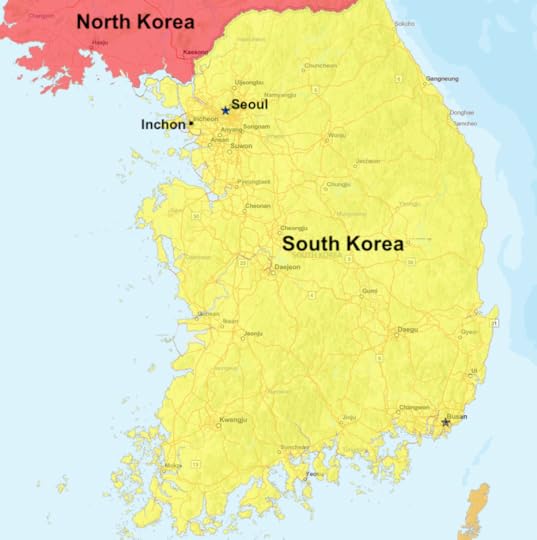 Map of South Korea – Source: U.S. State Department
Map of South Korea – Source: U.S. State DepartmentAs the recruits prepared to graduate from Basic Training, they learned they were all going to be sent to Italy. At the time, Italy was regarded as one of the best assignments possible, so they were all very excited. As they prepared to go, Bob needed to have new glasses made, which delayed his departure, meaning he did not get to go to Italy with the rest of the graduating class. Instead, he received new orders to Korea, which was not considered to be nearly as favorable an assignment. At the time, the situation on the Korean peninsula was very tense, with the Soviet Union occupying North Korea down to the 38th parallel, just thirty miles north of Seoul. The fear was the Soviet Union might push south in an effort to control South Korea, too.
Bob graduated from Basic Training in December 1946, just before Christmas. He was given two-weeks leave to visit his family in Ohio. Afterwards, he flew to San Diego where he boarded the troop ship SS Marine Jumper for the long voyage across the Pacific Ocean to South Korea. The ship arrived in the port of Inchon on the west coast of South Korea – a port that later became famous as the site of a brilliant U.S. amphibious landing behind enemy lines during the Korean War. What struck Bob as the ship sailed into the port was the large number of islands the ship passed and the distinct smell of the mainland. South Korea in 1946 was very poor—not the economic powerhouse it is today—forcing farmers to fertilize their fields with human waste. As a result, the country, which was largely agricultural, had a pungent smell. The farming practice also resulted in many South Koreans suffering from intestinal parasites until the country’s rapid industrial modernization took hold in the 1960s, bringing with it access to commercial fertilizers.
Once off the ship, Bob boarded a train that had been used by Japanese forces occupying Korea during World War II. All of the windows were broken out of the passenger cars, allowing the frigid winter air to blow through the train. After freezing in the train for the twenty-five mile trip to Kimpo Airfield in Seoul (now Gimpo International Airport), Bob and a few other replacement soldiers climbed into the back of a two-and-a-half-ton truck for the rest of the trip to the 865th Antiaircraft Artillery – Automatic Weapons (AAA) Battalion.
The 865th AAA Battalion’s mission was to shoot down enemy aircraft in the event of an attack on Kimpo Airfield. Given the political tensions and the Soviet occupation of North Korea, there was constant fear of an attack, so the unit had to be ready. To accomplish its mission, the 865th AAA Battalion used quad fifty caliber machine guns and 40 millimeter Bofors guns mounted on the back of halftracks. Bob had no experience on any of this equipment prior to his arrival. He had been trained to fire a rifle but not antiaircraft weapons, so everything he did from that point on was new to him.
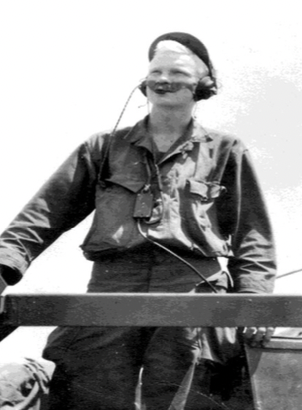 Bob Miller talking on a radio on a halftrack in South Korea
Bob Miller talking on a radio on a halftrack in South KoreaBob was assigned quarters in a Quonset hut together with about twenty other soldiers, mostly from the hill country of Kentucky and West Virginia. As Bob was from suburban Cleveland, he didn’t have much in common with these soldiers, so he looked for other opportunities to spend his free time. When he found the battalion’s radio shop, he knew he’d found a home. He began spending his off hours at the shop, learning how to work on the tactical radios that enabled the men on the unit’s halftracks to communicate with one another. Initially, he could only work on radio receivers, but once his captain certified him as a radio repairman, he was also able to work on radio transmitters. The certification also allowed him to promote to Technician 5th Grade, which meant he could be addressed as “corporal” or “tech corporal”.
Bob also kept his eye on his ultimate goal of going to college using the GI Bill after his enlistment was up. To get into college, he needed a course in trigonometry. The answer was a correspondence course offered by the United States Armed Forces Institute, or “USAFI”. After successfully completing the trigonometry course by mail, Bob was ready to apply to colleges once he got out of the Army.
On Sundays, Bob was one of only three soldiers in the unit who attended the Protestant church service. In fact, the church service had only five persons present: the chaplain, the organist, two other attendees, and Bob. After six months, the number was reduced to four when the organist’s tour of duty ended and he went home. Bob approached the chaplain and asked if he could have the organist’s job. He told the chaplain he could play the organ quite well by ear. The chaplain asked if he could type and Bob said no, but he was willing to learn. That satisfied the chaplain and he arranged for Bob to be transferred to be his assistant.
The transfer was a big deal for Bob. Although he now had to wear his dress uniform to work every day at the chapel, it meant he no longer had to do “kitchen patrol” (also known as “KP”) or stand guard duty. He also had a Korean teenage boy working with him to help him keep the chapel office clean. As the teenage boy wanted to come to the United States someday, Bob helped him learn English and taught him about American culture. In return, the Korean teen taught Bob about Korean customs and the Korean people.
Bob got to see firsthand how the local Korean people lived because of his affiliation with the church and because he enjoyed photography. As it turned out, one of the other two people who attended the Protestant service with Bob was a warrant officer who also enjoyed photography and used a dark room Bob had set up. One weekend, the warrant officer asked Bob if he would like to go for a drive with the warrant and his wife outside the post. Bob did and they borrowed a jeep and drove through the countryside. Bob was amazed at how incredibly poor the people were, most living in shacks with grass roofs. Seeing this made his quarters seem luxurious.
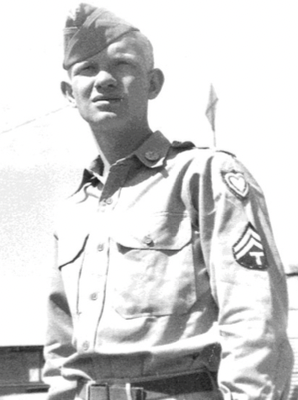 Technician 5th Grade Bob Miller
Technician 5th Grade Bob MillerLater in the year, the chaplain Bob worked for was reassigned to Seoul and he took Bob with him. Bob was assigned quarters with other soldiers in a former Japanese Army barracks. Although his primary responsibilities were in the chapel, he did have time for some other pursuits. On one occasion, some officers and their wives held a dinner party on Thanksgiving. They hired Bob and two other soldiers to dress up in white formal coats and serve the dinner, together with Champagne. When the dinner was over, they had to clean up everything, which also meant “disposing” of the leftover Champagne. Needless to say, Bob and his two comrades had a great evening as a result.
Bob worked in Seoul until February 1948, when his tour of duty in Korea ended. He left Korea in the same way he arrived—on a troop ship. On his voyage back to the States, his ship stopped in the Philippines, giving him a chance to get off the ship and catch a meal in a cafeteria. There he ran into Jimmy Higgins, one of his best friends from John Marshall High School. He also drank his first glass of real milk in over a year. It tasted really good.
Once back underway, the ship ran into a typhoon. The weather was so rough, Bob and the other troops were required to stay below the main deck – they could not go outside for fear of being lost. The waves were so giant that when the ship rode up one side and started to come down the other, everyone could hear the ship’s propellers churning in the air as the stern of the ship came completely out of the water. Soldiers were getting sick everywhere and the whole ship stunk from the smell of vomit. When Bob was finally permitted to go out on the main deck, he looked and saw a wave taller than the ship coming directly toward them. As before, the ship rode up one side of the wave and down the other, but it made for a scary ride.
The other excitement on the trip back was the ship’s crew found a stowaway onboard. A Korean boy who wanted to get to the United States had hid on the ship and was now kept under armed guard, even though he posed no danger to anyone.
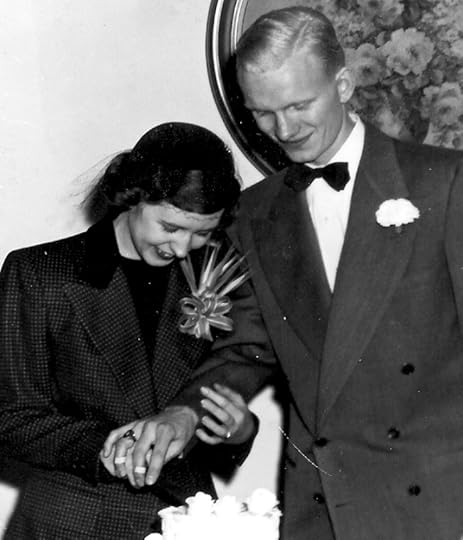 Bob and Mary Miller at their wedding in 1950
Bob and Mary Miller at their wedding in 1950The voyage home came to an end when the ship sailed under the Golden Gate Bridge and into San Francisco Bay. Bob was granted two weeks leave and received his honorable discharge—his ticket to the GI Bill and college—in March 1948. His original plan was to live with his parents and attend Fenn College in Cleveland (Fenn College would later become Cleveland State University), but after visiting his cousin at Miami University of Ohio, he knew that was the place for him. He began his studies there in the fall of 1948 and majored in mathematics and physics, together with a heavy sprinkling of engineering classes. He graduated in 1952, but not before meeting and marrying Mary Hage, his wife of sixty-five years, just before Christmas in December 1950.
After graduation, Bob began working as an engineer for the National Advisory Committee on Aeronautics, which in 1958 became NASA, at Cleveland Hopkins Airport. He rose to the level of Branch Chief at the Jet Propulsion Laboratory, leading a team of thirty engineers and technicians designing and testing NASA’s cutting edge technology. Although he retired in 1980, his engineering career continued, working or consulting for a number of small companies and designing a wide range of electronic products, ranging from water quality control devices to the first patented automatic bowling scoring machine used by Brunswick bowling alleys. In his spare time, he earned his private pilot’s license and flew small planes throughout his career for the pure enjoyment of flying.
Bob permanently retired when he turned sixty-five. Having toured much of the country in a motor home with Mary, they chose to sell their home in Cleveland and retire in Tucson, Arizona, where Bob lives to this day.
Voices to Veterans is proud to salute Technician 5th Grade Robert Miller, U.S. Army, for his distinguished service in South Korea immediately following World War II. His willingness to serve as the U.S. military was drawing down helped the South Korean people get a toehold on democracy in a politically charged atmosphere pitting East against West. After his service, he used his GI Bill to pursue his college degree and went on to a successful career at NASA and as an engineering consultant. We thank him for all of his contributions, both military and civilian, and wish him fair winds and following seas.
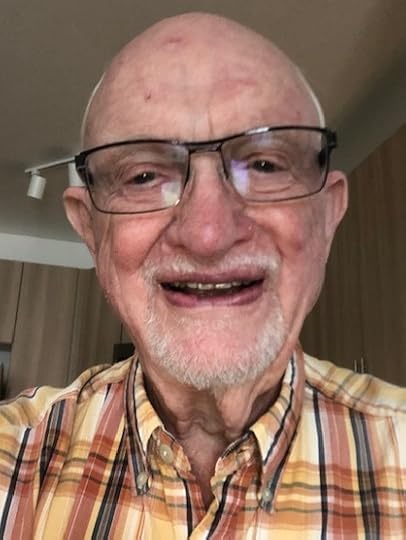 Technician 5th Grade Robert Miller
Technician 5th Grade Robert Miller
June 9, 2021
Sergeant Alice Gallop West, U.S. Army – Service to Others Comes First
For Sergeant Alice Gallop West, service to country and community did not end with her time in the Army—it began there. From working with the families of deployed soldiers, to giving victims and witnesses of crimes a voice in the military criminal justice system, Alice has worked tirelessly to help people and communities heal. At each step of her career, she’s learned and employed new skills to allow her to take her work to the next level. Because of Alice, our communities are safer and better prepared to take care of the needs of our military families. This is her story.
Alice was born and raised in the Ednor Gardens-Lakeside community of northeast Baltimore, Maryland, a middle-class neighborhood just a few blocks from where Baltimore’s Memorial Stadium used to stand. She was the oldest of four children and the only girl, so her father doted on her and they were very close. Her dad, who was a civil engineer, often took her to Baltimore Orioles games at the nearby stadium, passing on his love of baseball to Alice. He also took her horseback riding and ice skating, and she looked up to him and valued his guidance. Her mom was a counselor in the Baltimore City Public Schools, which Alice attended during her elementary and middle school years. When it came time for high school, her parents sent her to Elizabeth Ann Seton High School, a private Catholic school for girls named after the first U.S. citizen to be canonized as a saint.
Although Alice enjoyed her high school years and credits Seton High with preparing her to deal with the challenges she would soon face, she felt like a fish out of water. Not only was she one of the few African-American students enrolled, but she was also raised Baptist and came from a public school background. In contrast, many of her fellow students were Catholic and had attended Catholic grade and middle schools. Those factors made Alice’s life experience different. When her parents separated toward the end of her high school years, it added to her stress. Still, she made the best of the situation and was excited about her future when she graduated in June of 1982.
After graduation, Alice enrolled in Towson University, located eight miles north of Baltimore. This time she didn’t do well because Towson was not what she wanted—it was what her mother wanted. Alice didn’t know how to tell her mother Towson wasn’t right for her, so she moved out of her mother’s house in the spring of 1983 and, at nineteen years old, tried to make it on her own. After getting by for a couple of years, she decided to give the military a try.
Alice went to the recruiter’s office to enlist in June of 1985. She wanted to go Navy, but even though she’d done very well on the Armed Services Vocational Aptitude Battery, or ASVAB, the Navy had no slots for women available until at least September of that year. The Army, however, could take her right away and even dangled a $20,000 bonus in front of her if she agreed to become a missile repair technician. Although pursuing that course entailed attending a school for a year to learn the trade, the opportunity was too good to pass up and Alice accepted the Army’s offer.
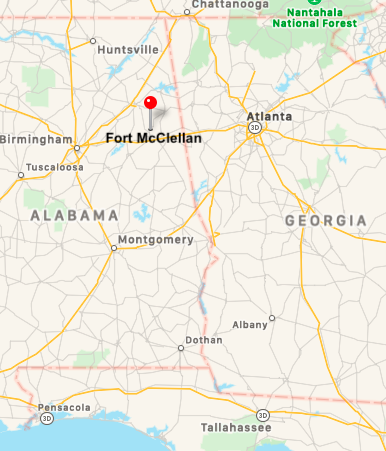 Map showing the location of Fort McClellan, Alabama
Map showing the location of Fort McClellan, AlabamaAfter signing paperwork in Baltimore and being sworn-in, Alice boarded a train to Anniston, Alabama, the home of Fort McClellan. All she had been told prior to departure was to take enough clothes for seven days, so she wore a white linen suit and black pumps to report in for duty, and carried a pants suit, a dress for church on Sunday, and several other outfits in her suitcase. As she got off the train, she remembers it being “as hot as Hades”. With her suitcase and briefcase in hand, she found the recruit reception station and produced a copy of her orders directing her to report for boot camp at Fort McClellan. The soldier working the desk looked at her in her white suit and gave her a look like “really?” Alice realizes now she must have looked like Goldie Hawn in the 1980 movie Private Benjamin, but at the time, she really didn’t know what to expect. When she was growing up, her family always dressed for dinner, so it was only natural for her to report for her first day in the Army in her best clothes.
The soldier at the reception desk took Alice’s orders and pointed out the “amnesty box”. She recited a list of contraband and told Alice if she had anything on the list, she should dispose of it in the box before proceeding any further. Now it was Alice’s turn to react, thinking “what kind of place is this that people come here with contraband they need to get rid of?” It made her wonder, “what have I really gotten myself into?”
As it turned out, Alice’s transition to the Army was easy. Seton High had prepared her well for the all-female training environment, and she immediately fit in and started to bond with the other forty women in her company. The training emphasized the tenets of camaraderie and good community, and the importance of helping each other succeed. For example, in the evening when “lights out” time came, the recruits would work with those who couldn’t do push-ups or sit-ups correctly, teaching them how to do them so they could get through the next day’s activities. For Alice, the physical training was fun because she was in excellent shape from three years of running and bike riding since high school. Still, she liked learning about Army values and the way the training stretched her to be the best she could be.
To move from class to class or to physical training, the recruits marched everywhere. However, if they had to travel somewhere too far away to march, a truck they called the “cattle truck” would pull up to where they were waiting and take them to their destination. The truck was aptly named because it had vertical slits for windows and the recruits had to stand in the back sweltering, packed together like sardines.
When it came time to qualify with the M16 rifle, the recruits were told if the entire company could qualify on the first day, they would get a pizza party. In anticipation of going to the range, Alice and the other recruits practiced with dummy M16s. When the day finally came, the practice paid off because all of the recruits qualified. The instructors made good on their promise and Alice and her comrades enjoyed their pizza party.
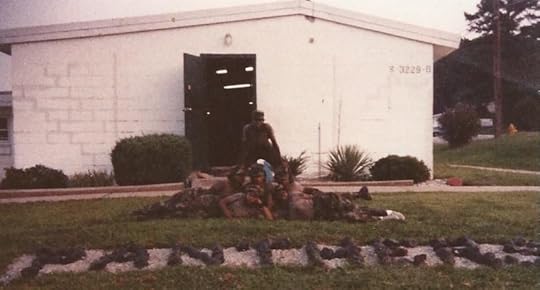 Alice and some members of her company at Basic Training
Alice and some members of her company at Basic TrainingNot everything about boot camp was rosy. When Alice was out in the field, the mornings could be cold and the afternoons blazing hot, making physical activity a challenge. Fire ants and their painful bites added to the discomfort. Worst of all was the water, which came out blood red when faucets were first turned on. The recruits were told it was from the red clay soil and to let the water run until it was clear. What they weren’t told was that Fort McClellan housed the Army’s chemical weapons arsenal and training site, which potentially exposed persons at Fort McClellan to chemical agents at unsafe levels.
Six weeks into boot camp, Alice got some terrible news from her Drill Sergeant – her father had just passed away from a heart attack. The Army let her go home for her father’s funeral and to help get his estate in order. Then she returned to Fort McClellan to pick up where she left off. Unfortunately, because the women she’d started boot camp with were already preparing to graduate, Alice had to “restart” with another company. She joined her new company six weeks into their training, so she didn’t have to re-do anything she’d already done. She graduated from boot camp with her new company in September 1985.
Had Alice graduated with her original company, she would have gone immediately to her follow-on missile technician training. However, the delay meant it was too late to join the course, so she stayed at Fort McClellan waiting until it was time to depart for the next class. Still grieving and with all of her friends having already moved on to their Advanced Individual Training (AIT), Alice was despondent. Finally, one Sunday after church, she asked a Chaplain if she could make an appointment to talk to him. At the appointment, the Chaplain suggested Alice come by the chapel during the workday to answer the phones. That’s what she did, and answering the phones soon expanded into typing church bulletins and flyers once the staff saw how well she could type (thanks to Sister Margaret Mary Donovan’s typing class at Seton High).
It wasn’t long before the senior enlisted Chaplain’s Assistant noticed how well Alice was doing. In fact, she was doing everything the Chaplain’s Assistants were doing, yet she was barely out of boot camp. He recommended Alice consider changing her career path from missile technician to Chaplain’s Assistant. Alice took the advice and put in the request, and the Army approved it. It meant she wouldn’t get the $20,000 missile technician bonus, but she would be doing something she enjoyed. Not only that, but when she departed in March 1986 to go to school to formally become a Chaplain’s Assistant, her command awarded her the Army Achievement medal for her outstanding support to the chapel – something very rare for a soldier fresh out of boot camp.
Alice reported to the U.S. Army Chaplain Center and School at Fort Monmouth, New Jersey, to complete her training to become a Chaplain’s Assistant. It was here she first realized not all Chaplains were effective faith leaders and began sorting them into three categories: good, bad, and indifferent. The Chaplain categories would remain valid for the rest of her career. She also had to learn how to properly remove deer ticks because she and the other students did their field training at the Naval Weapons Station in Earle, New Jersey, which had one of the highest concentrations of deer ticks in the country. As a result, Alice and the other trainees were always at an increased risk of Lyme disease. Finally, before Alice could be designated as a Chaplain’s Assistant, she had to pass a timed typing test. This was no problem because Alice was a skilled typist. However, when the course instructor realized Alice’s skill, she wanted Alice to take the test for some of the other students who were just learning to type. Alice was shocked the instructor would ask such a thing, especially at the Chaplain Center. She told her sergeant, but he didn’t believe her. With the instructor continuing to harass her to take the tests, Alice nearly had an emotional breakdown. She could not wait to get out of the school.
When it finally came time to leave and the assignments were being announced, Alice said she would be happy with anything as long as it wasn’t in Washington State because that was too far from home. Minutes later, Alice’s assignment was announced: I Corps Headquarters at Fort Lewis in Washington State. Once she actually reported there in the summer of 1986, she ended up loving the assignment, although she had to overcome the attitudes of some in her chain of command who weren’t used to working with women generally, and with women of color in particular. A Chaplain Alice really admired who had no such issues was Gaylord T. Gunhus, the Chaplain for the 9th Infantry Division. One day while they were driving together, Alice told him “I think you might become the Army Chief of Chaplains someday.” Her judgment of character turned out to be spot on, as Chaplain Gunhus became the Army Chief of Chaplains in 1999, rising to the rank of Major General.
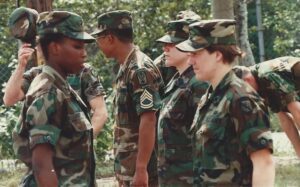 Alice (at far left) with other soldiers in Korea
Alice (at far left) with other soldiers in KoreaIn addition to assisting the I Corps Headquarters Chaplain, Alice taught aerobics at the base gym. One of her aerobics students was the I Corps commander, Lieutenant General Norman Schwarzkopf, who would lead U.S. ground forces to victory in Operation Desert Storm in Iraq a few years later. At one point when Alice got sick and had to be hospitalized, the news went across General Schwarzkopf’s desk as part of his daily brief. He directed the I Corps surgeon to call the hospital emergency room to make sure Alice, a Private First Class at the time, was okay. That made a lasting impression on Alice—the three-star commanding general cared enough about one of his soldiers to make sure she was okay, even before any of her immediate chain of command inquired about her condition. It was a lesson in leadership she would not forget.
Alice detached from I Corps in January 1988 and reported to Pyeongtaek, South Korea, for duty with the U.S. Eighth Army at Camp Humphreys, approximately forty miles south of Seoul along Korea’s west coast. Her specific assignment was with the 194th Maintenance Battalion, where she was supposed to assist the brigade Chaplain. He, however, had issues with women (and, in particular, minority women) serving as Chaplain’s Assistants, so he sidelined Alice from the moment she arrived. When he left six months later and his replacement, Chaplain Linda Ambler, arrived, Alice was finally permitted to do the work she was trained for. Alice and Chaplain Ambler were one of the first all-female Chaplain/Chaplain’s Assistant teams. They worked very well together, traveling throughout South Korea to minister to soldiers wherever they were. It was during this time that Alice learned that other students going through the Chaplain Center after she had made similar complaints about the typing instructor. As a result, the typing instructor was relieved of her duties, vindicating Alice. Finally, although Alice went to Korea single, she fell in love with a soldier there and they were married. They were able to arrange orders to be co-located at their next assignment, and they departed Korea in January of 1989.
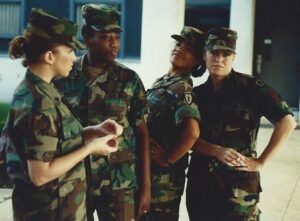 Alice (second from left) and other NCO’s at BNCOC
Alice (second from left) and other NCO’s at BNCOCAfter Korea, Alice reported for duty at the U.S. Army Armor Center at Fort Knox, Kentucky, where she supported chapel operations for two chapels. At the time, she was an “E-4 promotable”, which meant she was a Specialist (E-4) who was eligible to promote to Sergeant (E-5). While still a Specialist, Alice was selected to attend the Basic Noncommissioned Officer Course, or “BNCOC”, which was usually reserved for Sergeants and required a waiver from the Department of the Army for a Specialist to attend. Prior to departing Fort Knox to attend the course, which was held at Fort Monmouth, New Jersey, Alice had to report to the Command Sergeant Major, together with all of the other soldiers heading out on temporary assignments, so he could make it clear to them that they were expected to represent the command well wherever they were going. As an E-4, Alice waited at the back of the line for all those senior to her to see the Command Sergeant Major first. Things changed when the Command Sergeant Major looked at the list of people who were to see him and he saw that Alice was attending BNCOC as an E-4. He instructed that Alice be brought in first because in all of his years as a Sergeant Major, he had never seen an E-4 selected to attend BNCOC. He told Alice if there was anything she needed while at the course, she should feel free to call him. Then he sent her on her way, much to the surprise of the more senior soldiers who were still waiting in line.
When Alice returned from BNCOC in the fall of 1989, she was assigned to the Family Life Center at Fort Knox. There she supported the Army’s counseling program and assisted Army families address a host of issues often relating to the deployment of a family member. Then, in August of 1990, Iraq invaded Kuwait and the United States prepared to come to the defense of its ally. Now a Sergeant, Alice was called into the Sergeant Major’s office and told it looked like she would be deploying with the 19th Engineer Battalion to help repel Iraq’s invasion. Alice had to tell the Sergeant Major something she had been keeping secret – she was three months pregnant. She’d managed to keep it a secret by wearing her husband’s battle dress uniform (BDU) top and continuing with physical training along with everyone else, but the possible deployment meant she could no longer keep it a secret.
Alice gave birth to her daughter in February of 1991 and went back to work at the Family Life Center in July. Collaborating with others at the Center, Alice helped design and bring to life the Waiting Spouse Support Group Program, which provided the spouses of all of the Fort Knox soldiers deployed in support of Operation Desert Storm a place of community and a space to talk about all of the issues they faced in common. For example, they tackled the many family issues that arise when one spouse suddenly has to take over full responsibility for managing the family’s affairs, and then addressing the difficulties that often arise when the deploying spouse returns home. They held events for the spouses, provided day care, hosted meals, and gave kits to the families so they could write their deployed soldier. The Fort Knox program was so successful, it became the prototype for the Army’s Family Readiness Group program implemented Army-wide.
In January of 1992, Alice made the difficult decision not to reenlist after seven successful years on active duty. To Alice, being a mother to her daughter was her most important job and she felt like she couldn’t be the kind of mother she wanted to be if she stayed in the Army. Alice received her honorable discharge from the Army on January 19, 1992, and her husband received his three months later after making the same decision.
Alice found the transition to civilian life difficult, especially when it came to healthcare. By 1992, she began to suffer from a number of medical conditions which she attributes to her possible year-long exposure to chemical contaminants at Fort McClellan. Not only was the Veterans Administration medical staff unable to address the symptoms she was suffering, but Alice’s experience was they were not prepared in 1992 to deal with the medical needs of women veterans. Since then, Alice has been proactive about her health and is now getting the care she deserves.
In the years that followed, Alice had a series of life-changing events. She gave birth to her son in January of 1996 and was divorced a year later. She also completed her Associate’s degree and went to work for the Army again, this time as a civilian. She initially worked for Army Community Services and then the Army Cadet Program in Hampton, Virginia.
In 1999, Alice took a major step in a new direction and began working in the Army Corrections Program at Fort Knox as the Chief of Prisoner Administration. She also took on the role of the victim and witness coordinator. In this position, Alice fought for the rights of crime victims to make sure they knew what their rights were and that they were given a voice during the military justice process. She was also responsible for making sure sex offenders were properly registered as required by law to protect local communities once the offenders were released. In all of these areas, Alice immersed herself in the regulations to make sure she knew her responsibilities inside and out—the stakes involved in protecting innocent lives were just too high.
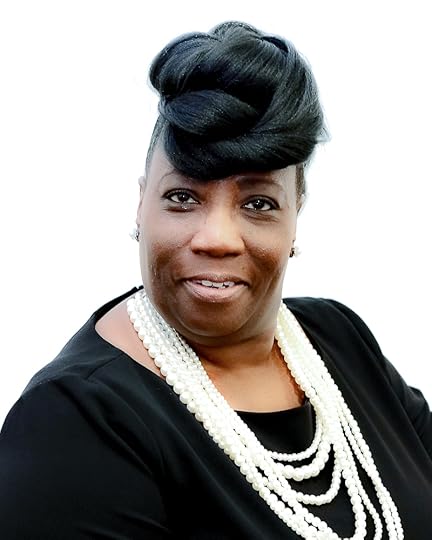 Alice Gallop West
Alice Gallop WestAlice excelled at her job. In 2004, she was named the Best of the Best in Army Corrections by the American Corrections Association and the Department of Defense and received a Department of the Army Achievement Medal for Civilian Service in 2007. Her career hit a speed bump in 2009, though, when the Army corrections facility at Fort Knox closed as a result of the Base Realignment and Closure Commission. Then in 2011, the Navy opened the Naval Consolidated Brig in Chesapeake, Virginia, and brought in Alice to help stand up the new facility as the Victim and Witness Coordinator. As the Victim and Witness Coordinator, Alice was responsible for making sure victims and witnesses of military crimes knew how to exercise their rights. She was also responsible for registering sex offenders with state authorities. Alice was subsequently promoted to Vocational Director for the prisoners, helping prepare them for life after incarceration. Finally, she was reassigned to serve as the facility’s Compliance Manager, responsible for making sure the facility met or exceeded regulatory and accreditation standards pertaining to prisoner and staff health and safety, staff training, and facility security.
Alice retired from federal service in 2016. She continues to serve her community through her membership in the Elizabeth City Chapter of The Links, Incorporated; the National Federation of Business and Professional Women’s Clubs – North Carolina; and the Virginia Dare Business & Professional Women’s Club. She is also a contributing author in the Amazon Best Seller, Camouflaged Sisters – Silent No More!, and is a national and international speaker and advocate for victims’ rights, veterans issues, and management of sex offender registration (visit Alice’s Facebook page to learn more). Last but not least, Alice is an active participant in Quilts of Valor, making quilts for servicemembers and veterans touched by war, and in her own ecumenical quilting group, Quilt with a Heart, through her church. Quilt with a Heart makes quilts for local charities and hospitals.
Voices to Veterans is proud to salute Sergeant Alice Gallop West for her lifetime of service, starting with her active duty years in the Army and extending through her volunteer service to the present day. In everything Alice has done, she has always put service to others first, whether it be helping families deal with the stress of a deployed parent or making sure crime victims and witnesses are heard in the criminal justice system. On behalf of all those Alice has helped, we thank Alice for her long career of service and wish her fair winds and following seas.
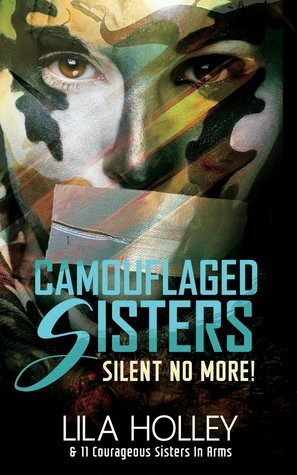
May 12, 2021
Private First Class Oscar Green, U.S. Army – Fighting in Europe to Save His Brother
True courage is rare. It only shows itself when a person is tested. For that reason, you can’t look at someone or listen to what they say about themselves to predict if they will be courageous. In fact, many courageous people won’t talk about their deeds because they don’t consider what they did anything special. They see their actions as simply doing their jobs. That’s why you can walk down the streets of New York City, sit in a diner in Chicago, talk to a farmer in Texas, or meet a laborer repairing a roof in California, and not realize you are in the presence of someone great. For example, who would have thought a twenty-year-old truck driver from Waynesburg, Kentucky, would have the courage to walk to death’s doorstep on battlefields in Europe, then return to his humble Kentucky surroundings as if his encounters with death never happened. That’s what Private First Class Oscar W. Green did in the waning days of World War II. This is his story, as told through his grandson, Mike Reed, and family friend, Dan Klare.
Oscar was born to John and Lilly Green on May 20, 1923, in the tiny town of Waynesburg, located in central Kentucky about sixty miles south of Lexington. He was the eighth of thirteen brothers and sisters who worked on the family farm. His father also operated a blacksmith shop, and persons from as far away as Lexington would come to get work done. Oscar attended school through the fourth grade, but quit school in 1935 during the middle of the Great Depression to work at home with his family.
Although the Depression made life hard, Oscar found time for activities other than work. When he was seventeen, he fell in love with Mary Josephine Coker, a fifteen-year-old girl from nearby King’s Mountain. Oscar’s family, and especially his mother, didn’t approve of the relationship because Mary was literally from the other side of the tracks. A railroad ran through the town and it was more industrial than Oscar’s family’s rural surroundings, so Oscar’s mother did not consider Mary good enough for Oscar. Oscar’s family was devout Methodist while Mary’s was devout Baptist, further adding to the divide. Oscar saw things differently than his mother, though, and asked Mary to be his wife. Unlike Oscar’s mom, Mary’s mother approved of the marriage and not only signed to allow her daughter to marry at age fifteen, but also served as a witness for the ceremony in Louisville, Kentucky, in January 1942.
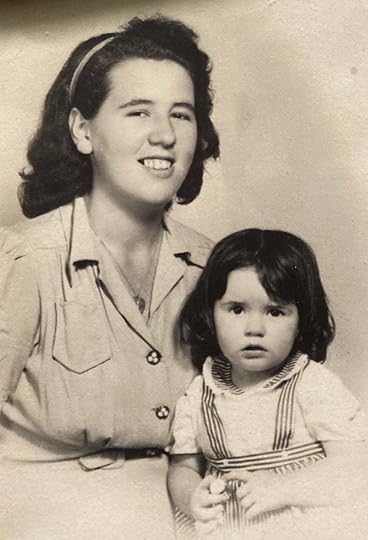 Mary and Patsy Green in September 1944
Mary and Patsy Green in September 1944Oscar and Mary began their life together living in King’s Mountain with Mary’s family. Oscar worked throughout 1942 and into early 1943 as a cook in Highland, Kentucky. Mary gave birth to their first daughter, Patsy, in February 1943, adding another mouth to feed to the family. Oscar changed jobs soon thereafter and drove a light truck for the Lincoln Lumber Company for the last seven months of the year. Then Oscar made a decision that would forever impact his family.
By now, World War II raged throughout Europe and across the Pacific, directly affecting Oscar’s family. Oscar’s older brother, James, was already serving in the Army and fighting the Japanese. Oscar felt like he needed to enlist, too, to help bring his brother home. By now, Oscar’s daughter was almost one year old, and he felt he could leave Mary and Patsy to join the war effort. By heading off to fight, Oscar believed he was doing his part to bring the war to an end, which meant his brother would be able to come home. With his mind set, he went to an Army recruiting station on January 8, 1944, and signed on the dotted line. Three weeks later, on January 29, Oscar took the oath of enlistment and entered active duty in the U.S. Army.
Oscar reported to “boot camp” at Camp Wheeler near Macon, Georgia. The Army used the camp to convert citizens into soldiers and, instead of training them to be part of a new unit that would deploy intact to fight the enemy, trained them to be replacements to fit into existing units that had sustained casualties and needed new soldiers to fill their ranks. Oscar complained in a letter to Mary that the bugs were “eating him up” and he couldn’t wait to get out of there. Once he graduated from boot camp in June, Mary left Patsy at home with her mother and visited Oscar in Georgia. It was the last time they would be together before Oscar shipped off for the war.
Boot camp wasn’t the end of Oscar’s training at Camp Wheeler. He also received his advanced training in infantry skills at the camp. This advanced training was crucial because Oscar would be a replacement soldier for the 44th Infantry Division, a National Guard Division which was already finalizing preparations at Camp Myles Standish in Massachusetts to sail to Cherbourg, France, for action against the Germans. The 44th Infantry Division left the port of Boston on September 5, 1944, and landed in France on September 15th.
[image error]Oscar posing on a bar set in 1944Because Oscar was still in the replacement training pipeline when the 44th Infantry Division departed, he did not sail to Europe with the Division. In fact, during the month of September 1944, he was in Fort Meade, Maryland, where the Army trained cooks and bakers. While he was there, he received a letter from Mary responding to a picture he had sent her showing him posing with a bottle of whiskey behind a bar. The bar appears to be a set used by the photographer to take pictures of soldiers. The backdrop is a drawing of the wall behind the bar, with Oscar’s name written in big letters above the image of a cash register. Mary, a staunch Baptist opposed to consuming alcohol, did not like what she saw. On September 26, 1944, she wrote Oscar a letter telling him just that. She said, “Well, I’m sorry you have to do such things since you have a daughter at home to think of and knowing that you may be soon facing the battlefield and you are unprepared to die and go out into eternity unprepared to meet thy God.” Although Mary was just eighteen, her letter made it clear she understood the gravity of what her husband was about to embark upon. She also made it clear that she and Patsy wanted him to come back home alive.
Given that Oscar followed in the footsteps of the 44th Infantry Division, he likely staged at Camp Myles Standish awaiting a ship that would carry him to France. He set sail from Boston in October 1944 and arrived in France on October 26, two days after the 44th Infantry Division saw its first action 475 miles to the east in the Vosges Mountains. Oscar joined the Division in November, as it was fighting through the mountains on its way to liberate the city of Strasbourg, France, together with the French 2nd Armored Division. He was assigned to Company K of the 3rd Battalion, 71st Infantry Regiment—one of three infantry regiments comprising the 44th Infantry Division.
After the liberation of Strasbourg on November 23, 1944, the 71st Infantry Regiment turned northward, taking on the Germans defending captured French fortifications on the Maginot Line. The 71st Infantry Regiment’s objectives, Forts Simserhof and Hoffviller, fell to the regiment on December 20 after six days of fighting. The regiment repositioned to Gros-Rederching, France, on December 23 in response to the German offensive to the north known as the Battle of the Bulge. Just three days later, Oscar’s medical records indicate he was treated for trench foot—a painful condition resulting from having cold, wet feet for too long—in the vicinity of Rimling, France.
Fighting was heavy in the snow and bitter cold after the first of the year, with the German’s attacking the 71st Infantry Regiment’s position. Company K was right in the thick of it, holding back the German advance. After the engagement, Company K and the rest of the 3rd Battalion relocated several times, all the time subject to German mortar and artillery fire. Oscar managed to live through it all unscathed, but on February 15, 1945, his luck ran out near Rimling. As Oscar and the other men in his unit began digging defensive positions, German automatic rifle fire opened up on their right flank, causing the men of Company K to take cover. Oscar’s Silver Star citation tells what happened next:
“Private Green, realizing the danger involved, crawled 75 yards toward the position of the hostile fire when he was hit in the back. Despite his injury, he continued firing at the enemy, accounting for at least two. Running out of ammunition, he returned for more and again moved toward the enemy gun, this time killing another German and forcing the others to withdraw.”
[image error]Oscar’s two-day pass to ParisWhat the citation does not describe is how seriously wounded Oscar was. He was hit by three German machine gun bullets in the shoulder and had to be evacuated from the front. He wrote a letter to Mary and Patsy that same day, or at least dictated one to someone writing for him, and told them how much he loved them. He did not mention being wounded, but told them he wanted to get home to see them. His wounds, however, did not get him sent home. After he was sufficiently recuperated to be returned to duty, he was assigned to the 232nd Reinforcement Company. On March 28, he was given a forty-eight hour pass to Paris, where he stayed at the Maisons Laffitte, one of several properties designated for soldiers recuperating from their wounds. Sometime in April after his two days in Paris, and not wanting to leave his buddies behind, he returned to the 71st Infantry Division to pick up the fighting where he left off. This time he was assigned to Company L, which was also part of the 3rd Battalion.
[image error]Oscar’s receipt from the Hotel Maisons-LaffitteStarting in mid-April, the 3rd Battalion was on the move, having teamed up with the 772nd Tank Battalion of the Tenth Armored Division. After capturing several towns along the way, the 3rd Battalion crossed the Danube River on April 23 and entered Germany. Although the timing isn’t clear, Oscar relayed a story to his grandson after the war that early one morning when they were on the move through the woods, they smelled coffee and bacon cooking. When they found the source of the smell, it was a German encampment with everyone sleeping except a lone German soldier making coffee and cooking bacon. Oscar’s job was to slip into the camp and eliminate the cook, which he did. Then the rest of the unit sprung on the camp and the Germans surrendered, thinking there were more American attackers than there really were. Oscar took a pocket watch from one of the German soldiers, but that was not all. Whether during this incident or some other at about the same time, he and his fellow soldiers confiscated some gold bars they found with the German soldiers they captured. Oscar said each soldier in his squad tucked away two gold bars and continued on. Oscar later discarded his because they were too heavy to carry together with his rifle and other gear. He lamented after the war that if he’d been able to keep just one of the bars, he never would have had to work again. He did, however, keep the watch he took. The watch is inscribed Werner Trau of Corbach, Waldeck, which is in Germany. (Oscar’s grandson would like find Werner Trau’s family, if possible, to learn more about the story behind the watch.)
[image error]Watch with inscription “Werner Trau, Corbach, Waldeck”The 3rd Battalion’s next assignment was to establish a bridgehead over the Iller River near the town of Illerieden. When they reached the bridge they were supposed to secure, the Germans blew it up. However, a cable remained between the two ends of the blown bridge and the soldiers began to cross going hand-over-hand. As Oscar prepared to cross the wire, he saw two men in front of him fall in and get swept downstream. Despite carrying his rifle and other gear, he managed to make it across without incident.
With the war with Germany entering its final days, the 71st Infantry Regiment and the 10th Armored Division fought eastward deeper into Germany, until they captured Fussen, which was just across the Austrian border. They then fought their way through passes in the Austrian Alps, which had to be cleared of defensive positions and snipers all along the route. When they reached Fern Pass, at an elevation of almost 4,000 feet and in the highest section of the Austrian Alps, the weather was bitter cold and snowing. The road through the pass was cratered to make it impassable and was defended by German heavy artillery. The Germans stalled and battled the 3rd Battalion in the pass all through the night of May 1st, with Oscar and the rest of Company L dueling with the Germans in order to dislodge them. The stalemate broke after the 1st Battalion made a treacherous journey around the enemy and came upon the Germans from behind.
The battle at Fern Pass proved catastrophic for Oscar. As he exchanged fire with a German soldier, he felt a bee sting on his left eye and tried to wipe the sweat he felt running from his face. He kept firing and saw the German fall. That was the last thing he remembers because at that point, his position took a direct hit from a German panzerfaust, a high-explosive anti-tank rocket with deadly effects on infantry, as well. This time Oscar’s war was over for good. Later that day, German rocket scientist Werner Von Braun surrendered to the 44th Infantry Division. He would beome a key figure in the U.S. space program. Then it was Germany’s turn, surrendering unconditionally just five days later on May 7, 1945.
[image error]71st Infantry Regiment Movements during WWII. Source: U.S. Army, “71st Infantry Regiment” (1946).A few days after the battle at Fern Pass, Mary received a Western Union telegram indicating Oscar was missing in action. A few weeks later, Army representatives visited her and gave her Oscar’s dog tags. They informed her Oscar was missing and presumed dead. Mary refused to accept their message. She told them, “You’ve only given me his dog tags. Until you show me his body, he’s not dead as far as I am concerned.” She added, “If he is dead, I want him brought back to Kentucky for a proper burial. I don’t want him buried in Europe.”
After the men went away, Mary reached out to the Red Cross for help. They told her she should investigate the “John Doe” soldiers being returned to the United States. Most had face or head wounds so they could not be identified. Each time Mary got word of a group of John Doe soldiers, she checked them out. She went to St. Louis and Kansas City to no avail. Then she learned some John Doe soldiers had arrived from France on June 26, 1945, and were being transported to a hospital in Maryland. As Mary prepared to go see them, Oscar’s mother decided to join her and the two traveled from Kentucky to the hospital by bus. Once they arrived at the ward, Mary heard a man talking and told the attendant, “I hear my husband.” Oscar’s mother called out his name and Oscar answered, triggering his memory for the first time since the panzerfaust blast.
The reunion was both happy and sad. Happy for the obvious reason that Oscar and Mary were reunited, but sad because Oscar had been terribly wounded. The bee sting Oscar felt was a bullet that took away his left eye and part of his left cheek, while the panzerfaust blast had severely injured his left arm, torso, and leg. He told Mary that he did not want to go home with her because he was only half the man he had been before the war. Mary would have none of it, declaring he was the man she’d married and he was the man she was taking home. Besides, she had something special to show him. His second daughter, Barbara, who was conceived during Mary’s visit with Oscar after boot camp graduation, had been born while he was in Europe, and had never seen her daddy. On top of that, Oscar’s mother now loved Mary dearly because Mary never gave up on Oscar when others said he was dead. She credited Mary with bringing Oscar home to the family.
[image error]Oscar and Mary on the steps of the house built for them by his brothersThe road ahead was tough for Oscar. He still had months to recuperate and wouldn’t be discharged until November 23, 1945, after he was fitted with a glass eye in Cleveland, Ohio. He couldn’t work and was given a 100% monthly disability payment. When he returned to Waynesburg, Kentucky, his family rallied around him and five of his brothers built him a house in 1948. Oscar made it a point to be at the worksite every day, which didn’t sit well with someone in the town. They complained he shouldn’t be receiving a disability check if he was at the construction site because that meant he had to be doing some of the work. The result was his monthly disability payment was cut in half. Oscar wanted to challenge it, but was afraid they would take the other half away if he did. He told his family, “if the government thinks they need that money more than I do, they can have it.”
Because of his wounds, it took several years before Oscar was able to work full time again. Handy with mechanical equipment before the war, Oscar took a job with the Gene Triplet Farm Equipment Company of Danville, Kentucky, repairing farm equipment and becoming a skilled mechanic. He later shifted to working on cars, which he did for about fifteen years until he had to retire due to heart issues. Oscar’s grandson remembers seeing Oscar work on cars, often leaning on the car and doing the work with his right hand. Shrapnel continued to work its way to the surface of his skin until it could be removed with a pair of tweezers, and he and Mary kept an ash tray filled with the little slivers of metal as a testament to what he had endured during the war. He also had nightmares for the rest of his life, flashing back to the incessant combat he experienced fighting his way through France, Germany, and Austria.
Despite all of this, Oscar remained in good spirits. He and Mary raised their two daughters and were dedicated to their family. Oscar was particularly close to his grandchildren, all of whom admired him not only for his service during the war, but also for the way he lived his life with quiet dignity. Mike Reed, for example, felt very honored when Oscar agreed to serve as best man in Mike’s wedding. Oscar also lived by the 23rd Psalm because he believed that Psalm had saved his life. When he took the hit from the panzerfaust, a small Bible in his breast pocket absorbed shrapnel that otherwise would have gone into his chest. The shrapnel penetrated through to the 23rd Psalm and stopped there, so he found comfort in the Psalm for the rest of his life. In the end, though, it was a piece of shrapnel lodged in his heart that killed him. Too dangerous to remove, the metal fragment caused five heart attacks, the fifth one killing him on January 30, 1995. His beloved Mary, who never gave up on him, predeceased him in December 1984.
For his service during World War II, Oscar earned the Silver Star, the Bronze Star, the Purple Heart with one Oak Leaf Cluster, the Army of Occupation Medal with Germany Clasp, the European-African-Middle Eastern Campaign Medal with two Bronze Service Stars, the World War II Victory Medal, the Combat Infantryman Badge, the Sharpshooter Badge with Rifle Bar, and the Honorable Service Lapel Button WWII.
Voices to Veterans is proud to salute the life and service of Private First Class Oscar W. Green, U.S. Army. He endured unimaginable hardships, never asking for anything in return. He enlisted believing he needed to do his part to help the United States and its Allies win the war and bring his brother home. He demonstrated courage under fire and bravery in the face of a determined enemy, and never backed down. Moreover, he continued to demonstrate courage back home, raising his family and inspiring all those around him. This story, coming over twenty-six years after his death, demonstrates the lasting impression and legacy Oscar left behind. Were he here today, we would thank him for his service and wish him fair winds and following seas.
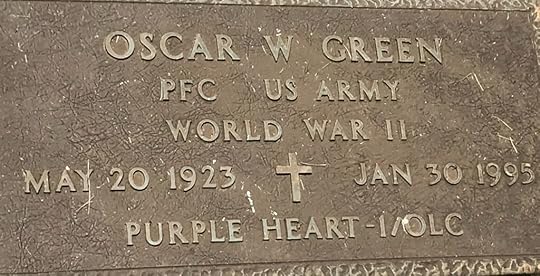 Oscar Green’s gravestone
Oscar Green’s gravestone



